Development of UK Audit Committee for Effective and Good Governance
VerifiedAdded on 2023/06/18
|37
|13815
|493
AI Summary
This dissertation explores the development of the UK audit committee for effective and good governance in public sector organizations like Foundation Trusts (FTs). It examines the responsibilities and roles of the audit committee, the strategies and policies employed, and the composition of FTs. The study is based on Institutional Theory and adopts an explanatory and exploratory method.
Contribute Materials
Your contribution can guide someone’s learning journey. Share your
documents today.
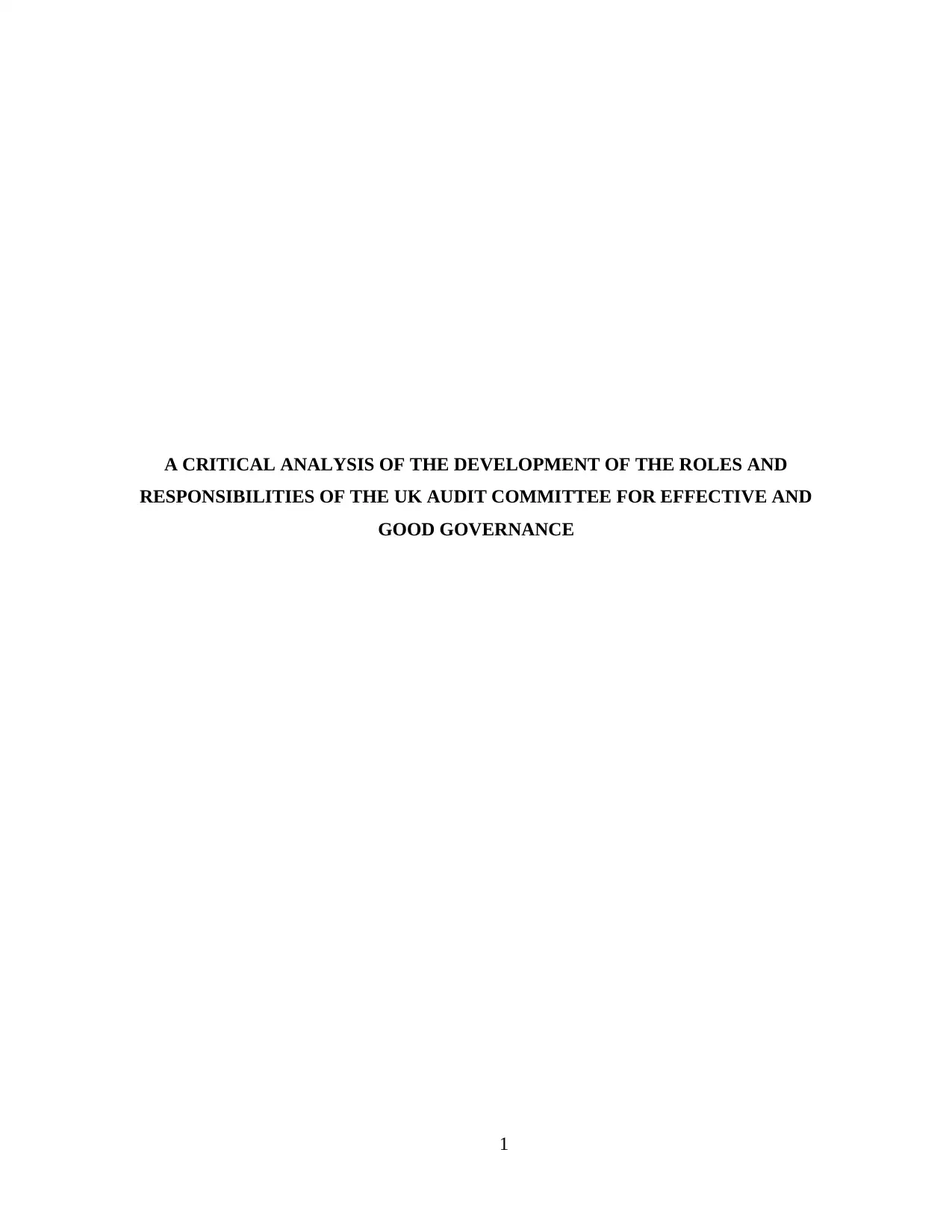
A CRITICAL ANALYSIS OF THE DEVELOPMENT OF THE ROLES AND
RESPONSIBILITIES OF THE UK AUDIT COMMITTEE FOR EFFECTIVE AND
GOOD GOVERNANCE
1
RESPONSIBILITIES OF THE UK AUDIT COMMITTEE FOR EFFECTIVE AND
GOOD GOVERNANCE
1
Secure Best Marks with AI Grader
Need help grading? Try our AI Grader for instant feedback on your assignments.
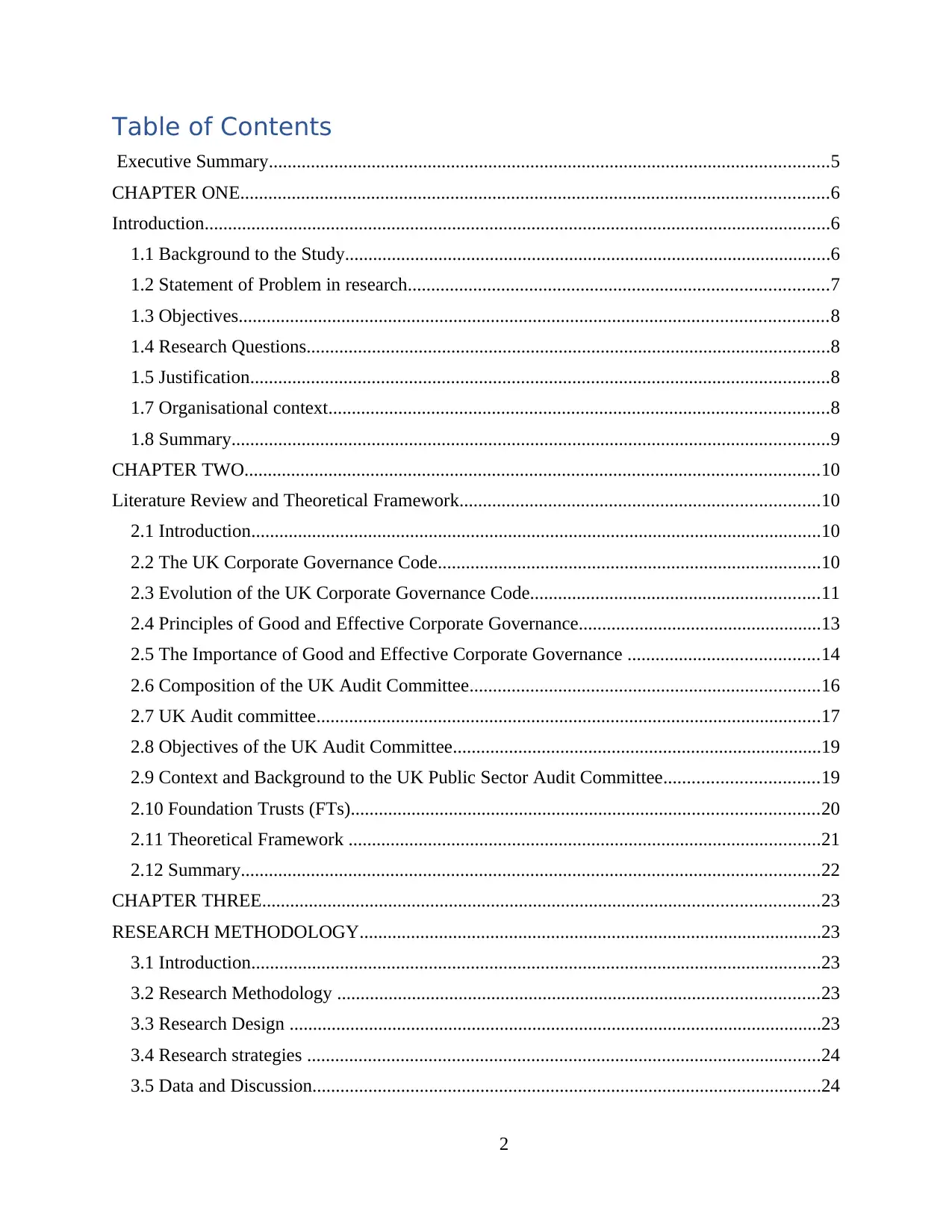
Table of Contents
Executive Summary........................................................................................................................5
CHAPTER ONE..............................................................................................................................6
Introduction......................................................................................................................................6
1.1 Background to the Study........................................................................................................6
1.2 Statement of Problem in research..........................................................................................7
1.3 Objectives..............................................................................................................................8
1.4 Research Questions................................................................................................................8
1.5 Justification............................................................................................................................8
1.7 Organisational context...........................................................................................................8
1.8 Summary................................................................................................................................9
CHAPTER TWO...........................................................................................................................10
Literature Review and Theoretical Framework.............................................................................10
2.1 Introduction..........................................................................................................................10
2.2 The UK Corporate Governance Code..................................................................................10
2.3 Evolution of the UK Corporate Governance Code..............................................................11
2.4 Principles of Good and Effective Corporate Governance....................................................13
2.5 The Importance of Good and Effective Corporate Governance .........................................14
2.6 Composition of the UK Audit Committee...........................................................................16
2.7 UK Audit committee............................................................................................................17
2.8 Objectives of the UK Audit Committee...............................................................................19
2.9 Context and Background to the UK Public Sector Audit Committee.................................19
2.10 Foundation Trusts (FTs)....................................................................................................20
2.11 Theoretical Framework .....................................................................................................21
2.12 Summary............................................................................................................................22
CHAPTER THREE.......................................................................................................................23
RESEARCH METHODOLOGY...................................................................................................23
3.1 Introduction..........................................................................................................................23
3.2 Research Methodology .......................................................................................................23
3.3 Research Design ..................................................................................................................23
3.4 Research strategies ..............................................................................................................24
3.5 Data and Discussion.............................................................................................................24
2
Executive Summary........................................................................................................................5
CHAPTER ONE..............................................................................................................................6
Introduction......................................................................................................................................6
1.1 Background to the Study........................................................................................................6
1.2 Statement of Problem in research..........................................................................................7
1.3 Objectives..............................................................................................................................8
1.4 Research Questions................................................................................................................8
1.5 Justification............................................................................................................................8
1.7 Organisational context...........................................................................................................8
1.8 Summary................................................................................................................................9
CHAPTER TWO...........................................................................................................................10
Literature Review and Theoretical Framework.............................................................................10
2.1 Introduction..........................................................................................................................10
2.2 The UK Corporate Governance Code..................................................................................10
2.3 Evolution of the UK Corporate Governance Code..............................................................11
2.4 Principles of Good and Effective Corporate Governance....................................................13
2.5 The Importance of Good and Effective Corporate Governance .........................................14
2.6 Composition of the UK Audit Committee...........................................................................16
2.7 UK Audit committee............................................................................................................17
2.8 Objectives of the UK Audit Committee...............................................................................19
2.9 Context and Background to the UK Public Sector Audit Committee.................................19
2.10 Foundation Trusts (FTs)....................................................................................................20
2.11 Theoretical Framework .....................................................................................................21
2.12 Summary............................................................................................................................22
CHAPTER THREE.......................................................................................................................23
RESEARCH METHODOLOGY...................................................................................................23
3.1 Introduction..........................................................................................................................23
3.2 Research Methodology .......................................................................................................23
3.3 Research Design ..................................................................................................................23
3.4 Research strategies ..............................................................................................................24
3.5 Data and Discussion.............................................................................................................24
2
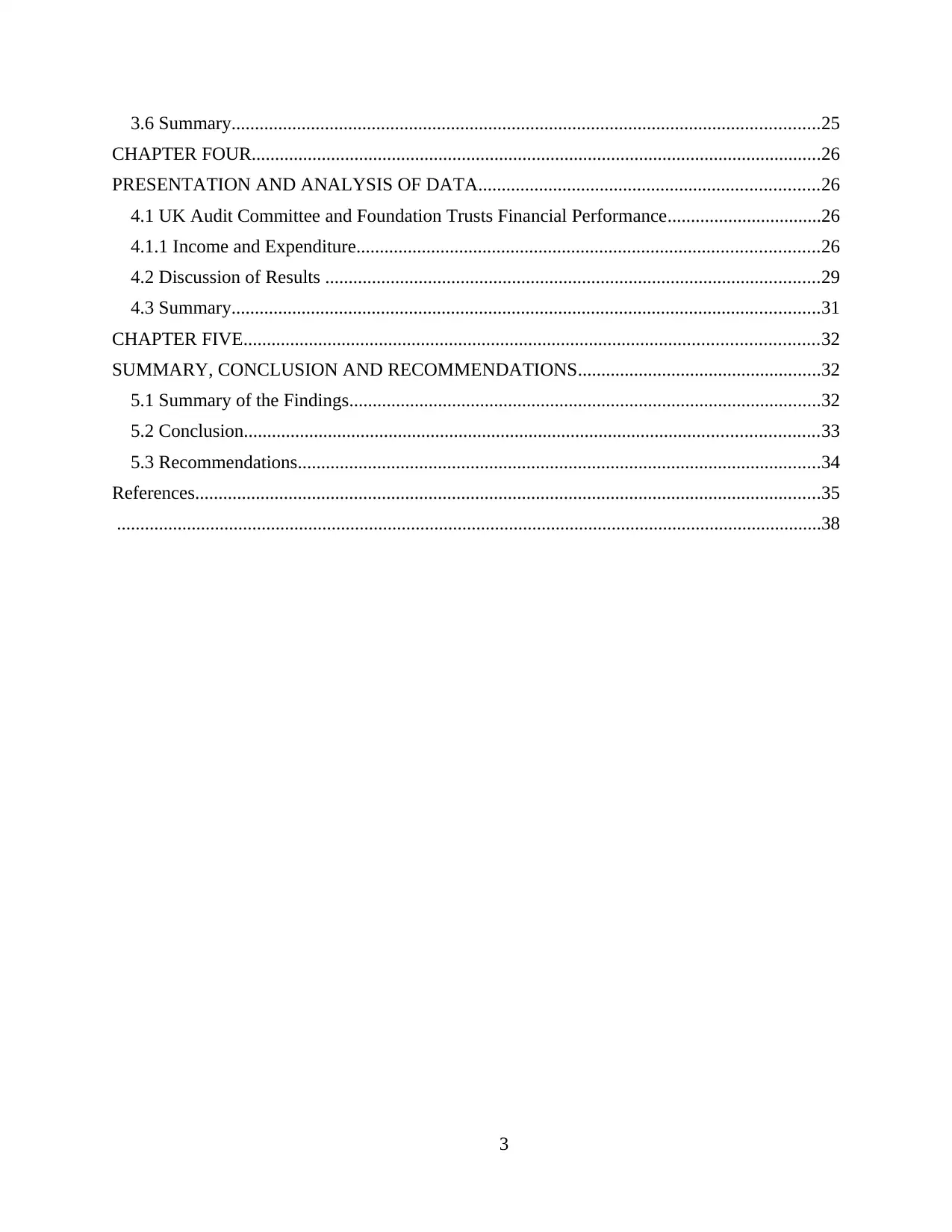
3.6 Summary..............................................................................................................................25
CHAPTER FOUR..........................................................................................................................26
PRESENTATION AND ANALYSIS OF DATA.........................................................................26
4.1 UK Audit Committee and Foundation Trusts Financial Performance.................................26
4.1.1 Income and Expenditure...................................................................................................26
4.2 Discussion of Results ..........................................................................................................29
4.3 Summary..............................................................................................................................31
CHAPTER FIVE...........................................................................................................................32
SUMMARY, CONCLUSION AND RECOMMENDATIONS....................................................32
5.1 Summary of the Findings.....................................................................................................32
5.2 Conclusion...........................................................................................................................33
5.3 Recommendations................................................................................................................34
References......................................................................................................................................35
.......................................................................................................................................................38
3
CHAPTER FOUR..........................................................................................................................26
PRESENTATION AND ANALYSIS OF DATA.........................................................................26
4.1 UK Audit Committee and Foundation Trusts Financial Performance.................................26
4.1.1 Income and Expenditure...................................................................................................26
4.2 Discussion of Results ..........................................................................................................29
4.3 Summary..............................................................................................................................31
CHAPTER FIVE...........................................................................................................................32
SUMMARY, CONCLUSION AND RECOMMENDATIONS....................................................32
5.1 Summary of the Findings.....................................................................................................32
5.2 Conclusion...........................................................................................................................33
5.3 Recommendations................................................................................................................34
References......................................................................................................................................35
.......................................................................................................................................................38
3
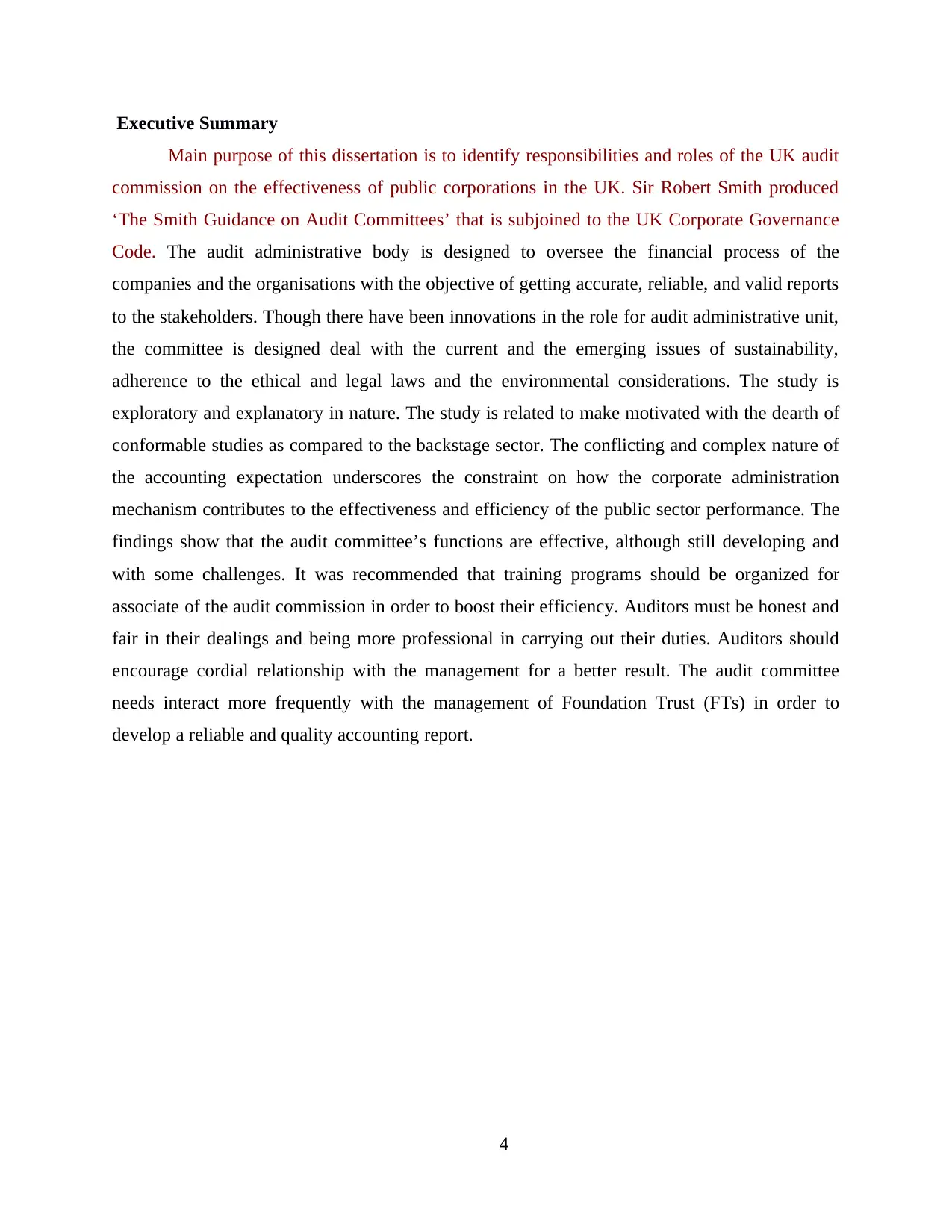
Executive Summary
Main purpose of this dissertation is to identify responsibilities and roles of the UK audit
commission on the effectiveness of public corporations in the UK. Sir Robert Smith produced
‘The Smith Guidance on Audit Committees’ that is subjoined to the UK Corporate Governance
Code. The audit administrative body is designed to oversee the financial process of the
companies and the organisations with the objective of getting accurate, reliable, and valid reports
to the stakeholders. Though there have been innovations in the role for audit administrative unit,
the committee is designed deal with the current and the emerging issues of sustainability,
adherence to the ethical and legal laws and the environmental considerations. The study is
exploratory and explanatory in nature. The study is related to make motivated with the dearth of
conformable studies as compared to the backstage sector. The conflicting and complex nature of
the accounting expectation underscores the constraint on how the corporate administration
mechanism contributes to the effectiveness and efficiency of the public sector performance. The
findings show that the audit committee’s functions are effective, although still developing and
with some challenges. It was recommended that training programs should be organized for
associate of the audit commission in order to boost their efficiency. Auditors must be honest and
fair in their dealings and being more professional in carrying out their duties. Auditors should
encourage cordial relationship with the management for a better result. The audit committee
needs interact more frequently with the management of Foundation Trust (FTs) in order to
develop a reliable and quality accounting report.
4
Main purpose of this dissertation is to identify responsibilities and roles of the UK audit
commission on the effectiveness of public corporations in the UK. Sir Robert Smith produced
‘The Smith Guidance on Audit Committees’ that is subjoined to the UK Corporate Governance
Code. The audit administrative body is designed to oversee the financial process of the
companies and the organisations with the objective of getting accurate, reliable, and valid reports
to the stakeholders. Though there have been innovations in the role for audit administrative unit,
the committee is designed deal with the current and the emerging issues of sustainability,
adherence to the ethical and legal laws and the environmental considerations. The study is
exploratory and explanatory in nature. The study is related to make motivated with the dearth of
conformable studies as compared to the backstage sector. The conflicting and complex nature of
the accounting expectation underscores the constraint on how the corporate administration
mechanism contributes to the effectiveness and efficiency of the public sector performance. The
findings show that the audit committee’s functions are effective, although still developing and
with some challenges. It was recommended that training programs should be organized for
associate of the audit commission in order to boost their efficiency. Auditors must be honest and
fair in their dealings and being more professional in carrying out their duties. Auditors should
encourage cordial relationship with the management for a better result. The audit committee
needs interact more frequently with the management of Foundation Trust (FTs) in order to
develop a reliable and quality accounting report.
4
Secure Best Marks with AI Grader
Need help grading? Try our AI Grader for instant feedback on your assignments.
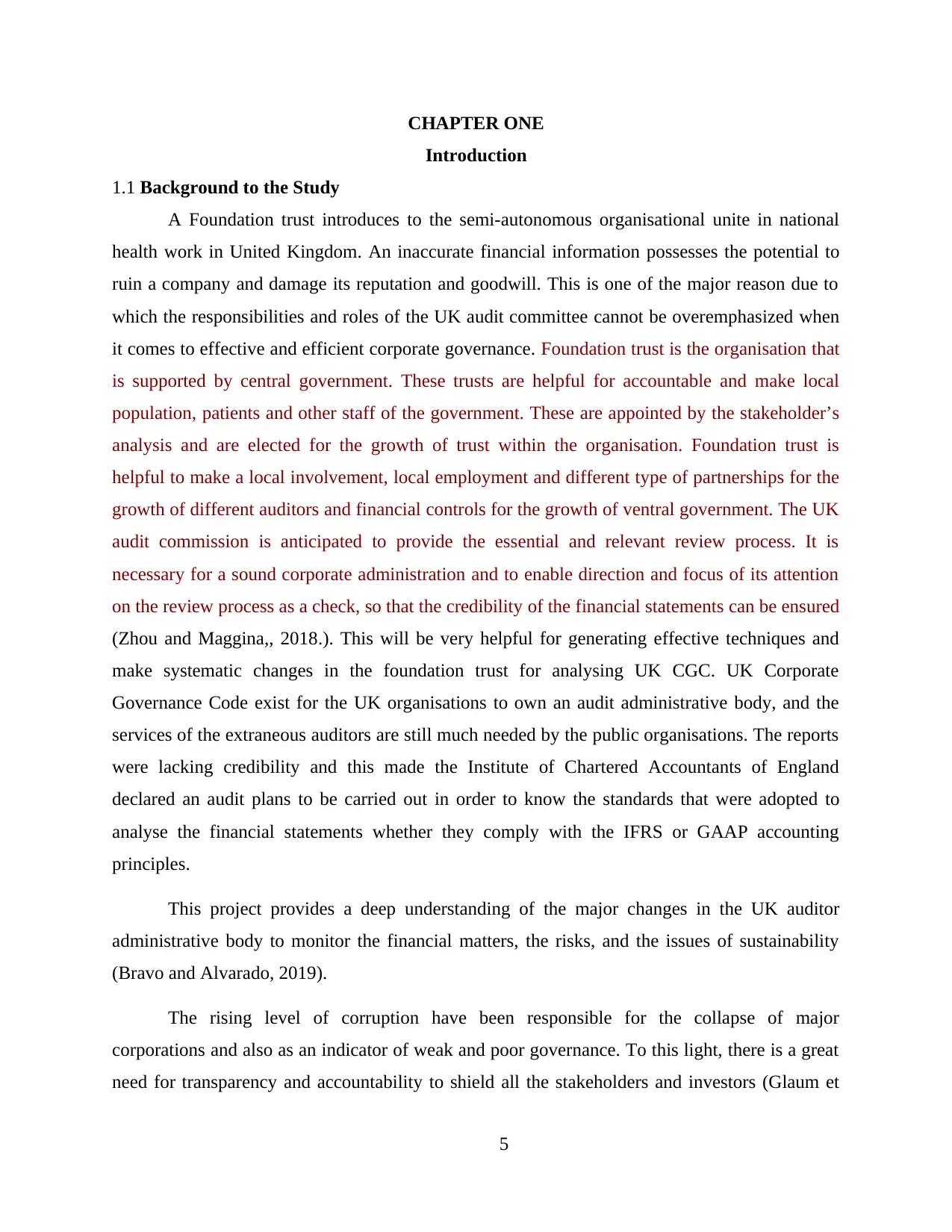
CHAPTER ONE
Introduction
1.1 Background to the Study
A Foundation trust introduces to the semi-autonomous organisational unite in national
health work in United Kingdom. An inaccurate financial information possesses the potential to
ruin a company and damage its reputation and goodwill. This is one of the major reason due to
which the responsibilities and roles of the UK audit committee cannot be overemphasized when
it comes to effective and efficient corporate governance. Foundation trust is the organisation that
is supported by central government. These trusts are helpful for accountable and make local
population, patients and other staff of the government. These are appointed by the stakeholder’s
analysis and are elected for the growth of trust within the organisation. Foundation trust is
helpful to make a local involvement, local employment and different type of partnerships for the
growth of different auditors and financial controls for the growth of ventral government. The UK
audit commission is anticipated to provide the essential and relevant review process. It is
necessary for a sound corporate administration and to enable direction and focus of its attention
on the review process as a check, so that the credibility of the financial statements can be ensured
(Zhou and Maggina,, 2018.). This will be very helpful for generating effective techniques and
make systematic changes in the foundation trust for analysing UK CGC. UK Corporate
Governance Code exist for the UK organisations to own an audit administrative body, and the
services of the extraneous auditors are still much needed by the public organisations. The reports
were lacking credibility and this made the Institute of Chartered Accountants of England
declared an audit plans to be carried out in order to know the standards that were adopted to
analyse the financial statements whether they comply with the IFRS or GAAP accounting
principles.
This project provides a deep understanding of the major changes in the UK auditor
administrative body to monitor the financial matters, the risks, and the issues of sustainability
(Bravo and Alvarado, 2019).
The rising level of corruption have been responsible for the collapse of major
corporations and also as an indicator of weak and poor governance. To this light, there is a great
need for transparency and accountability to shield all the stakeholders and investors (Glaum et
5
Introduction
1.1 Background to the Study
A Foundation trust introduces to the semi-autonomous organisational unite in national
health work in United Kingdom. An inaccurate financial information possesses the potential to
ruin a company and damage its reputation and goodwill. This is one of the major reason due to
which the responsibilities and roles of the UK audit committee cannot be overemphasized when
it comes to effective and efficient corporate governance. Foundation trust is the organisation that
is supported by central government. These trusts are helpful for accountable and make local
population, patients and other staff of the government. These are appointed by the stakeholder’s
analysis and are elected for the growth of trust within the organisation. Foundation trust is
helpful to make a local involvement, local employment and different type of partnerships for the
growth of different auditors and financial controls for the growth of ventral government. The UK
audit commission is anticipated to provide the essential and relevant review process. It is
necessary for a sound corporate administration and to enable direction and focus of its attention
on the review process as a check, so that the credibility of the financial statements can be ensured
(Zhou and Maggina,, 2018.). This will be very helpful for generating effective techniques and
make systematic changes in the foundation trust for analysing UK CGC. UK Corporate
Governance Code exist for the UK organisations to own an audit administrative body, and the
services of the extraneous auditors are still much needed by the public organisations. The reports
were lacking credibility and this made the Institute of Chartered Accountants of England
declared an audit plans to be carried out in order to know the standards that were adopted to
analyse the financial statements whether they comply with the IFRS or GAAP accounting
principles.
This project provides a deep understanding of the major changes in the UK auditor
administrative body to monitor the financial matters, the risks, and the issues of sustainability
(Bravo and Alvarado, 2019).
The rising level of corruption have been responsible for the collapse of major
corporations and also as an indicator of weak and poor governance. To this light, there is a great
need for transparency and accountability to shield all the stakeholders and investors (Glaum et
5
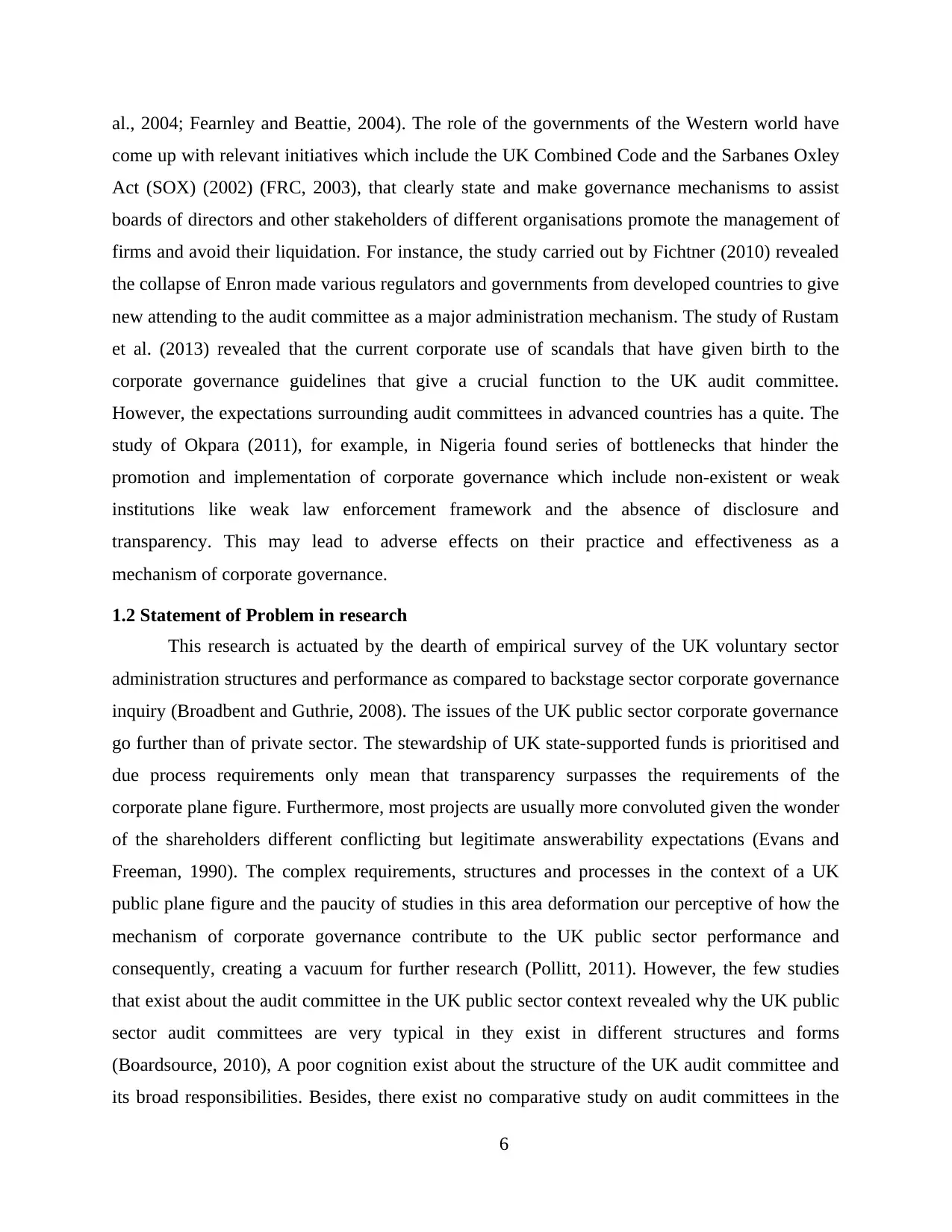
al., 2004; Fearnley and Beattie, 2004). The role of the governments of the Western world have
come up with relevant initiatives which include the UK Combined Code and the Sarbanes Oxley
Act (SOX) (2002) (FRC, 2003), that clearly state and make governance mechanisms to assist
boards of directors and other stakeholders of different organisations promote the management of
firms and avoid their liquidation. For instance, the study carried out by Fichtner (2010) revealed
the collapse of Enron made various regulators and governments from developed countries to give
new attending to the audit committee as a major administration mechanism. The study of Rustam
et al. (2013) revealed that the current corporate use of scandals that have given birth to the
corporate governance guidelines that give a crucial function to the UK audit committee.
However, the expectations surrounding audit committees in advanced countries has a quite. The
study of Okpara (2011), for example, in Nigeria found series of bottlenecks that hinder the
promotion and implementation of corporate governance which include non-existent or weak
institutions like weak law enforcement framework and the absence of disclosure and
transparency. This may lead to adverse effects on their practice and effectiveness as a
mechanism of corporate governance.
1.2 Statement of Problem in research
This research is actuated by the dearth of empirical survey of the UK voluntary sector
administration structures and performance as compared to backstage sector corporate governance
inquiry (Broadbent and Guthrie, 2008). The issues of the UK public sector corporate governance
go further than of private sector. The stewardship of UK state-supported funds is prioritised and
due process requirements only mean that transparency surpasses the requirements of the
corporate plane figure. Furthermore, most projects are usually more convoluted given the wonder
of the shareholders different conflicting but legitimate answerability expectations (Evans and
Freeman, 1990). The complex requirements, structures and processes in the context of a UK
public plane figure and the paucity of studies in this area deformation our perceptive of how the
mechanism of corporate governance contribute to the UK public sector performance and
consequently, creating a vacuum for further research (Pollitt, 2011). However, the few studies
that exist about the audit committee in the UK public sector context revealed why the UK public
sector audit committees are very typical in they exist in different structures and forms
(Boardsource, 2010), A poor cognition exist about the structure of the UK audit committee and
its broad responsibilities. Besides, there exist no comparative study on audit committees in the
6
come up with relevant initiatives which include the UK Combined Code and the Sarbanes Oxley
Act (SOX) (2002) (FRC, 2003), that clearly state and make governance mechanisms to assist
boards of directors and other stakeholders of different organisations promote the management of
firms and avoid their liquidation. For instance, the study carried out by Fichtner (2010) revealed
the collapse of Enron made various regulators and governments from developed countries to give
new attending to the audit committee as a major administration mechanism. The study of Rustam
et al. (2013) revealed that the current corporate use of scandals that have given birth to the
corporate governance guidelines that give a crucial function to the UK audit committee.
However, the expectations surrounding audit committees in advanced countries has a quite. The
study of Okpara (2011), for example, in Nigeria found series of bottlenecks that hinder the
promotion and implementation of corporate governance which include non-existent or weak
institutions like weak law enforcement framework and the absence of disclosure and
transparency. This may lead to adverse effects on their practice and effectiveness as a
mechanism of corporate governance.
1.2 Statement of Problem in research
This research is actuated by the dearth of empirical survey of the UK voluntary sector
administration structures and performance as compared to backstage sector corporate governance
inquiry (Broadbent and Guthrie, 2008). The issues of the UK public sector corporate governance
go further than of private sector. The stewardship of UK state-supported funds is prioritised and
due process requirements only mean that transparency surpasses the requirements of the
corporate plane figure. Furthermore, most projects are usually more convoluted given the wonder
of the shareholders different conflicting but legitimate answerability expectations (Evans and
Freeman, 1990). The complex requirements, structures and processes in the context of a UK
public plane figure and the paucity of studies in this area deformation our perceptive of how the
mechanism of corporate governance contribute to the UK public sector performance and
consequently, creating a vacuum for further research (Pollitt, 2011). However, the few studies
that exist about the audit committee in the UK public sector context revealed why the UK public
sector audit committees are very typical in they exist in different structures and forms
(Boardsource, 2010), A poor cognition exist about the structure of the UK audit committee and
its broad responsibilities. Besides, there exist no comparative study on audit committees in the
6
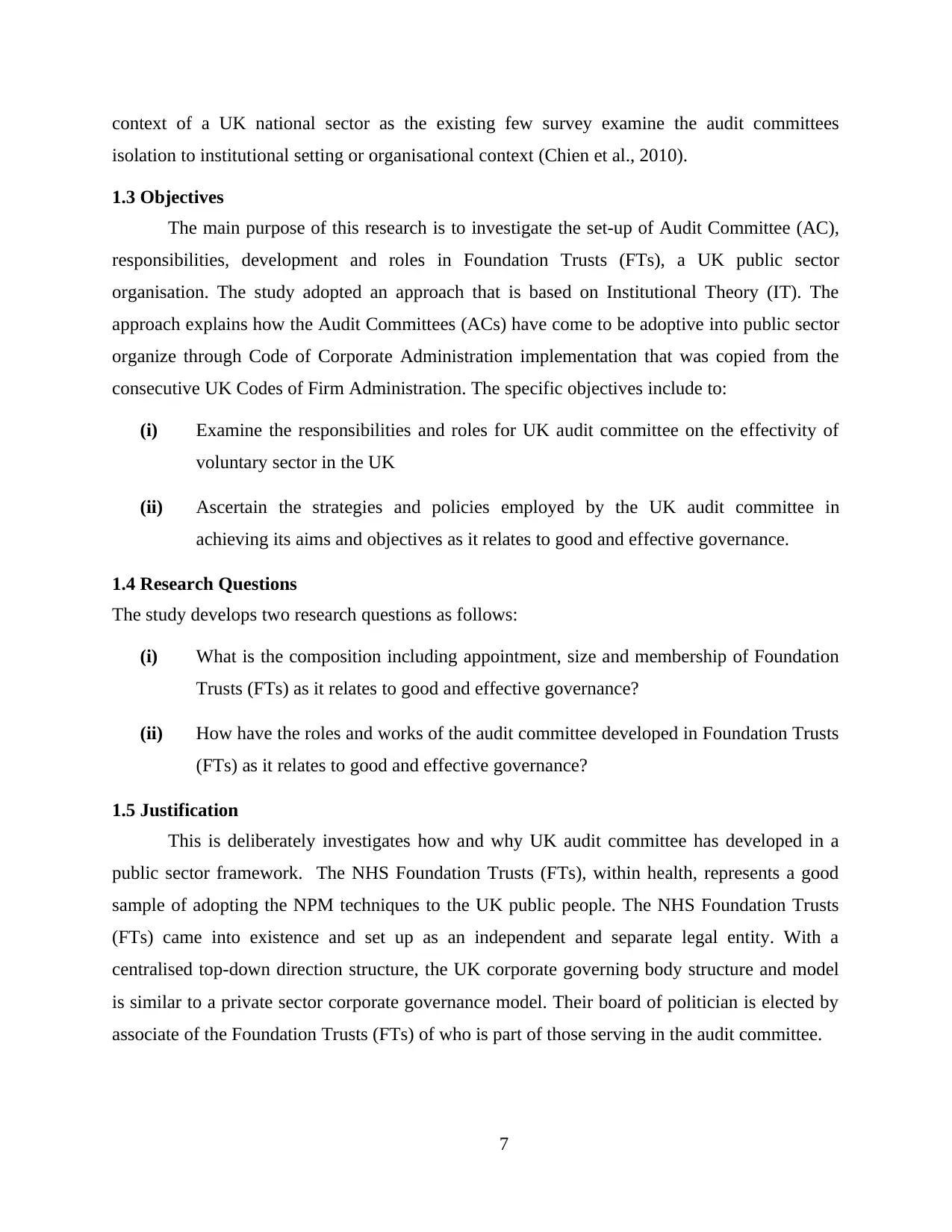
context of a UK national sector as the existing few survey examine the audit committees
isolation to institutional setting or organisational context (Chien et al., 2010).
1.3 Objectives
The main purpose of this research is to investigate the set-up of Audit Committee (AC),
responsibilities, development and roles in Foundation Trusts (FTs), a UK public sector
organisation. The study adopted an approach that is based on Institutional Theory (IT). The
approach explains how the Audit Committees (ACs) have come to be adoptive into public sector
organize through Code of Corporate Administration implementation that was copied from the
consecutive UK Codes of Firm Administration. The specific objectives include to:
(i) Examine the responsibilities and roles for UK audit committee on the effectivity of
voluntary sector in the UK
(ii) Ascertain the strategies and policies employed by the UK audit committee in
achieving its aims and objectives as it relates to good and effective governance.
1.4 Research Questions
The study develops two research questions as follows:
(i) What is the composition including appointment, size and membership of Foundation
Trusts (FTs) as it relates to good and effective governance?
(ii) How have the roles and works of the audit committee developed in Foundation Trusts
(FTs) as it relates to good and effective governance?
1.5 Justification
This is deliberately investigates how and why UK audit committee has developed in a
public sector framework. The NHS Foundation Trusts (FTs), within health, represents a good
sample of adopting the NPM techniques to the UK public people. The NHS Foundation Trusts
(FTs) came into existence and set up as an independent and separate legal entity. With a
centralised top-down direction structure, the UK corporate governing body structure and model
is similar to a private sector corporate governance model. Their board of politician is elected by
associate of the Foundation Trusts (FTs) of who is part of those serving in the audit committee.
7
isolation to institutional setting or organisational context (Chien et al., 2010).
1.3 Objectives
The main purpose of this research is to investigate the set-up of Audit Committee (AC),
responsibilities, development and roles in Foundation Trusts (FTs), a UK public sector
organisation. The study adopted an approach that is based on Institutional Theory (IT). The
approach explains how the Audit Committees (ACs) have come to be adoptive into public sector
organize through Code of Corporate Administration implementation that was copied from the
consecutive UK Codes of Firm Administration. The specific objectives include to:
(i) Examine the responsibilities and roles for UK audit committee on the effectivity of
voluntary sector in the UK
(ii) Ascertain the strategies and policies employed by the UK audit committee in
achieving its aims and objectives as it relates to good and effective governance.
1.4 Research Questions
The study develops two research questions as follows:
(i) What is the composition including appointment, size and membership of Foundation
Trusts (FTs) as it relates to good and effective governance?
(ii) How have the roles and works of the audit committee developed in Foundation Trusts
(FTs) as it relates to good and effective governance?
1.5 Justification
This is deliberately investigates how and why UK audit committee has developed in a
public sector framework. The NHS Foundation Trusts (FTs), within health, represents a good
sample of adopting the NPM techniques to the UK public people. The NHS Foundation Trusts
(FTs) came into existence and set up as an independent and separate legal entity. With a
centralised top-down direction structure, the UK corporate governing body structure and model
is similar to a private sector corporate governance model. Their board of politician is elected by
associate of the Foundation Trusts (FTs) of who is part of those serving in the audit committee.
7
Paraphrase This Document
Need a fresh take? Get an instant paraphrase of this document with our AI Paraphraser
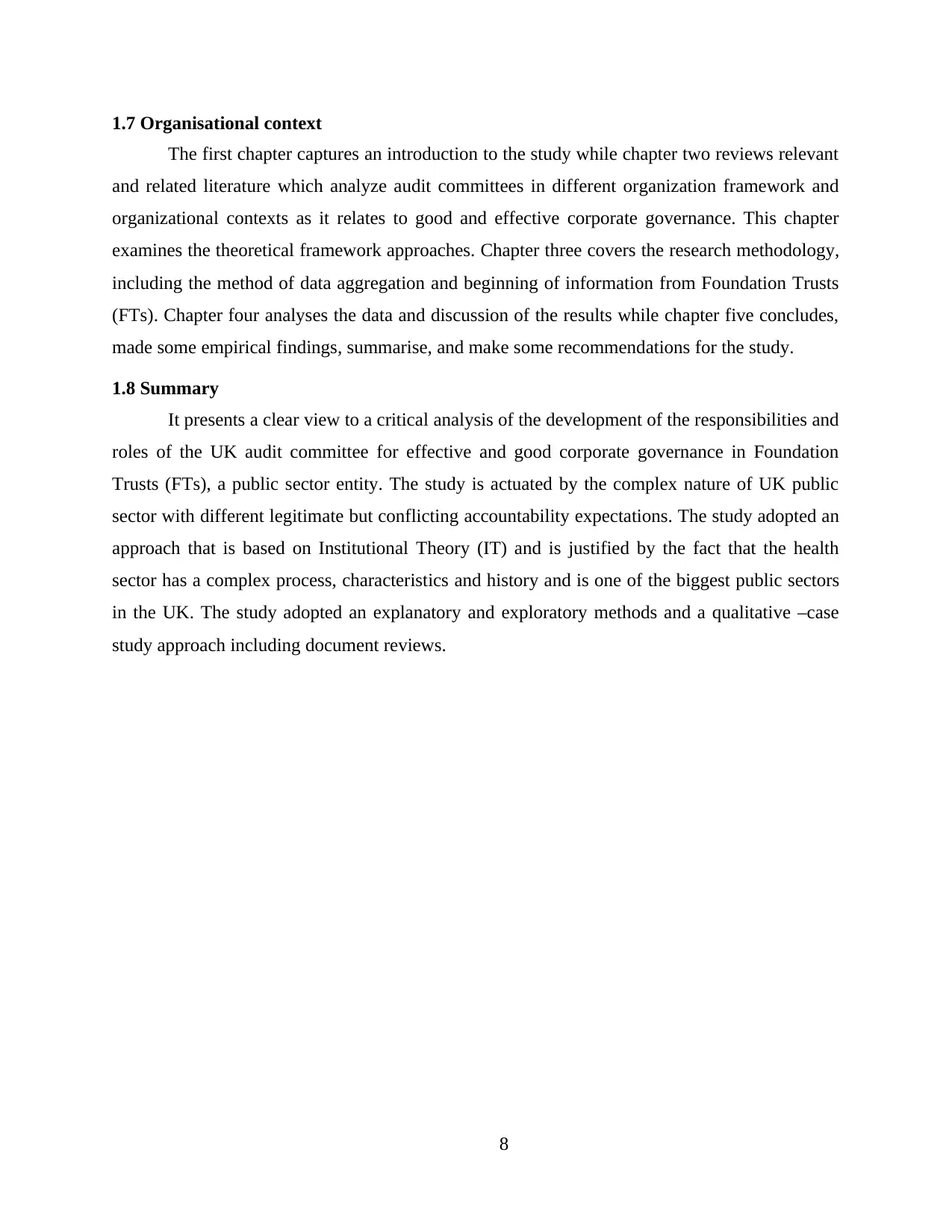
1.7 Organisational context
The first chapter captures an introduction to the study while chapter two reviews relevant
and related literature which analyze audit committees in different organization framework and
organizational contexts as it relates to good and effective corporate governance. This chapter
examines the theoretical framework approaches. Chapter three covers the research methodology,
including the method of data aggregation and beginning of information from Foundation Trusts
(FTs). Chapter four analyses the data and discussion of the results while chapter five concludes,
made some empirical findings, summarise, and make some recommendations for the study.
1.8 Summary
It presents a clear view to a critical analysis of the development of the responsibilities and
roles of the UK audit committee for effective and good corporate governance in Foundation
Trusts (FTs), a public sector entity. The study is actuated by the complex nature of UK public
sector with different legitimate but conflicting accountability expectations. The study adopted an
approach that is based on Institutional Theory (IT) and is justified by the fact that the health
sector has a complex process, characteristics and history and is one of the biggest public sectors
in the UK. The study adopted an explanatory and exploratory methods and a qualitative –case
study approach including document reviews.
8
The first chapter captures an introduction to the study while chapter two reviews relevant
and related literature which analyze audit committees in different organization framework and
organizational contexts as it relates to good and effective corporate governance. This chapter
examines the theoretical framework approaches. Chapter three covers the research methodology,
including the method of data aggregation and beginning of information from Foundation Trusts
(FTs). Chapter four analyses the data and discussion of the results while chapter five concludes,
made some empirical findings, summarise, and make some recommendations for the study.
1.8 Summary
It presents a clear view to a critical analysis of the development of the responsibilities and
roles of the UK audit committee for effective and good corporate governance in Foundation
Trusts (FTs), a public sector entity. The study is actuated by the complex nature of UK public
sector with different legitimate but conflicting accountability expectations. The study adopted an
approach that is based on Institutional Theory (IT) and is justified by the fact that the health
sector has a complex process, characteristics and history and is one of the biggest public sectors
in the UK. The study adopted an explanatory and exploratory methods and a qualitative –case
study approach including document reviews.
8
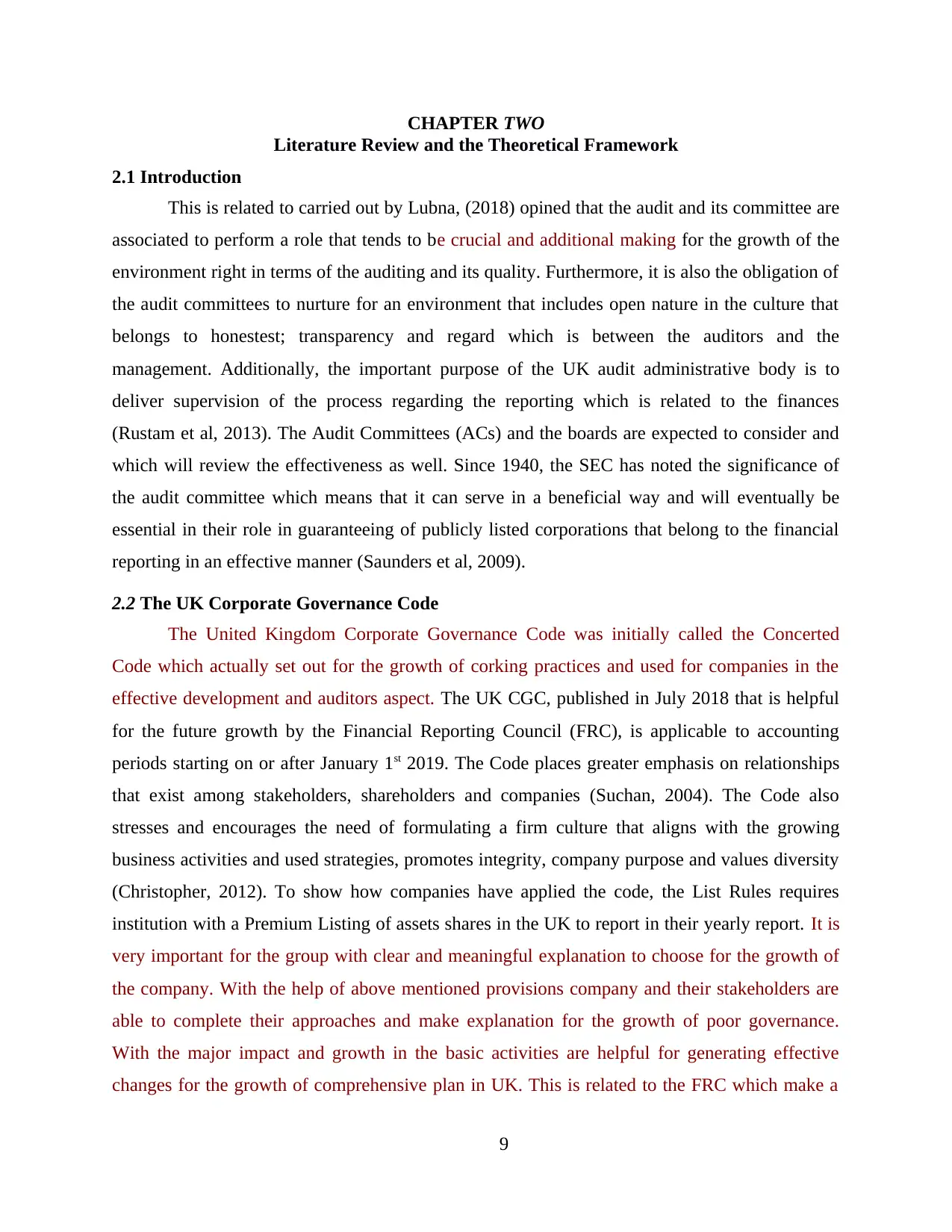
CHAPTER TWO
Literature Review and the Theoretical Framework
2.1 Introduction
This is related to carried out by Lubna, (2018) opined that the audit and its committee are
associated to perform a role that tends to be crucial and additional making for the growth of the
environment right in terms of the auditing and its quality. Furthermore, it is also the obligation of
the audit committees to nurture for an environment that includes open nature in the culture that
belongs to honestest; transparency and regard which is between the auditors and the
management. Additionally, the important purpose of the UK audit administrative body is to
deliver supervision of the process regarding the reporting which is related to the finances
(Rustam et al, 2013). The Audit Committees (ACs) and the boards are expected to consider and
which will review the effectiveness as well. Since 1940, the SEC has noted the significance of
the audit committee which means that it can serve in a beneficial way and will eventually be
essential in their role in guaranteeing of publicly listed corporations that belong to the financial
reporting in an effective manner (Saunders et al, 2009).
2.2 The UK Corporate Governance Code
The United Kingdom Corporate Governance Code was initially called the Concerted
Code which actually set out for the growth of corking practices and used for companies in the
effective development and auditors aspect. The UK CGC, published in July 2018 that is helpful
for the future growth by the Financial Reporting Council (FRC), is applicable to accounting
periods starting on or after January 1st 2019. The Code places greater emphasis on relationships
that exist among stakeholders, shareholders and companies (Suchan, 2004). The Code also
stresses and encourages the need of formulating a firm culture that aligns with the growing
business activities and used strategies, promotes integrity, company purpose and values diversity
(Christopher, 2012). To show how companies have applied the code, the List Rules requires
institution with a Premium Listing of assets shares in the UK to report in their yearly report. It is
very important for the group with clear and meaningful explanation to choose for the growth of
the company. With the help of above mentioned provisions company and their stakeholders are
able to complete their approaches and make explanation for the growth of poor governance.
With the major impact and growth in the basic activities are helpful for generating effective
changes for the growth of comprehensive plan in UK. This is related to the FRC which make a
9
Literature Review and the Theoretical Framework
2.1 Introduction
This is related to carried out by Lubna, (2018) opined that the audit and its committee are
associated to perform a role that tends to be crucial and additional making for the growth of the
environment right in terms of the auditing and its quality. Furthermore, it is also the obligation of
the audit committees to nurture for an environment that includes open nature in the culture that
belongs to honestest; transparency and regard which is between the auditors and the
management. Additionally, the important purpose of the UK audit administrative body is to
deliver supervision of the process regarding the reporting which is related to the finances
(Rustam et al, 2013). The Audit Committees (ACs) and the boards are expected to consider and
which will review the effectiveness as well. Since 1940, the SEC has noted the significance of
the audit committee which means that it can serve in a beneficial way and will eventually be
essential in their role in guaranteeing of publicly listed corporations that belong to the financial
reporting in an effective manner (Saunders et al, 2009).
2.2 The UK Corporate Governance Code
The United Kingdom Corporate Governance Code was initially called the Concerted
Code which actually set out for the growth of corking practices and used for companies in the
effective development and auditors aspect. The UK CGC, published in July 2018 that is helpful
for the future growth by the Financial Reporting Council (FRC), is applicable to accounting
periods starting on or after January 1st 2019. The Code places greater emphasis on relationships
that exist among stakeholders, shareholders and companies (Suchan, 2004). The Code also
stresses and encourages the need of formulating a firm culture that aligns with the growing
business activities and used strategies, promotes integrity, company purpose and values diversity
(Christopher, 2012). To show how companies have applied the code, the List Rules requires
institution with a Premium Listing of assets shares in the UK to report in their yearly report. It is
very important for the group with clear and meaningful explanation to choose for the growth of
the company. With the help of above mentioned provisions company and their stakeholders are
able to complete their approaches and make explanation for the growth of poor governance.
With the major impact and growth in the basic activities are helpful for generating effective
changes for the growth of comprehensive plan in UK. This is related to the FRC which make a
9
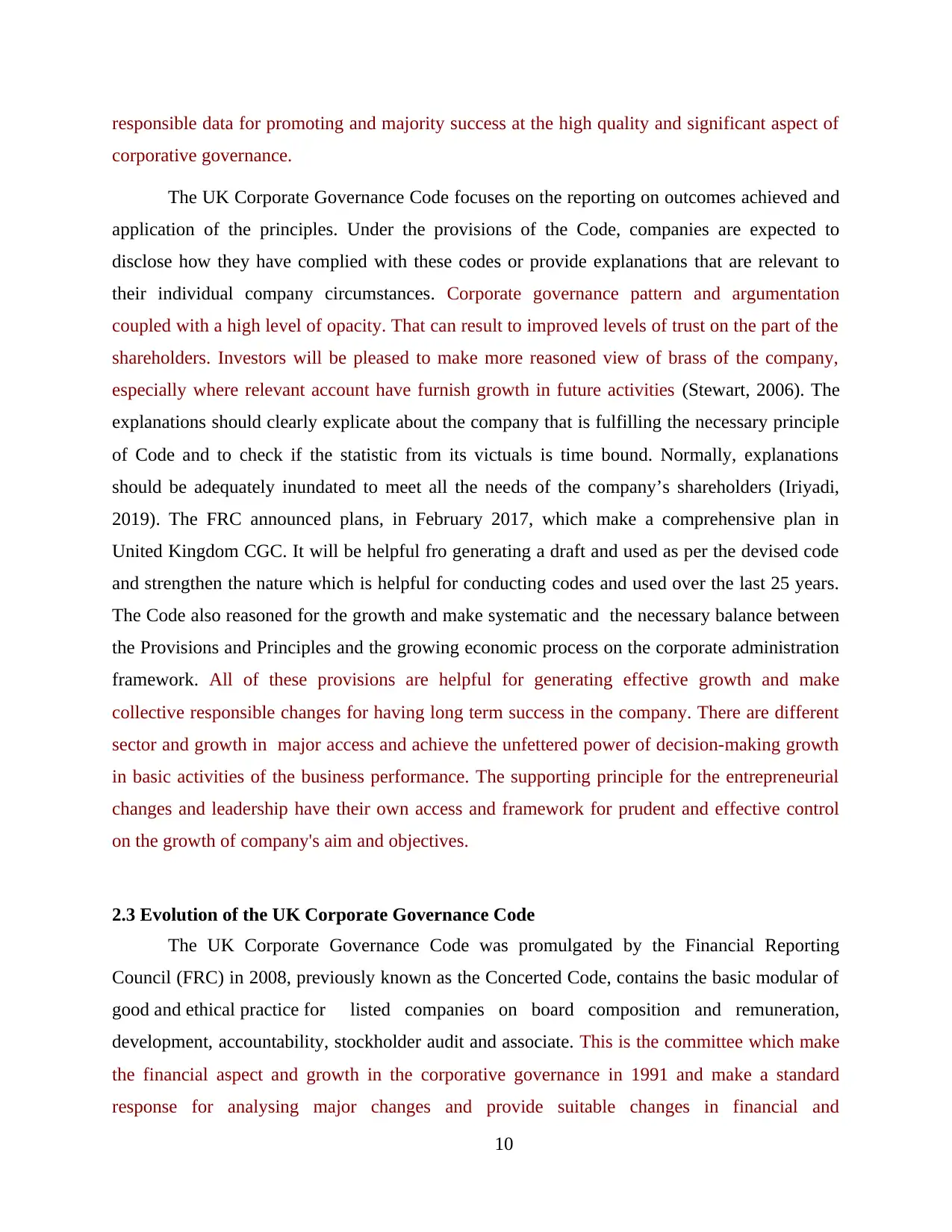
responsible data for promoting and majority success at the high quality and significant aspect of
corporative governance.
The UK Corporate Governance Code focuses on the reporting on outcomes achieved and
application of the principles. Under the provisions of the Code, companies are expected to
disclose how they have complied with these codes or provide explanations that are relevant to
their individual company circumstances. Corporate governance pattern and argumentation
coupled with a high level of opacity. That can result to improved levels of trust on the part of the
shareholders. Investors will be pleased to make more reasoned view of brass of the company,
especially where relevant account have furnish growth in future activities (Stewart, 2006). The
explanations should clearly explicate about the company that is fulfilling the necessary principle
of Code and to check if the statistic from its victuals is time bound. Normally, explanations
should be adequately inundated to meet all the needs of the company’s shareholders (Iriyadi,
2019). The FRC announced plans, in February 2017, which make a comprehensive plan in
United Kingdom CGC. It will be helpful fro generating a draft and used as per the devised code
and strengthen the nature which is helpful for conducting codes and used over the last 25 years.
The Code also reasoned for the growth and make systematic and the necessary balance between
the Provisions and Principles and the growing economic process on the corporate administration
framework. All of these provisions are helpful for generating effective growth and make
collective responsible changes for having long term success in the company. There are different
sector and growth in major access and achieve the unfettered power of decision-making growth
in basic activities of the business performance. The supporting principle for the entrepreneurial
changes and leadership have their own access and framework for prudent and effective control
on the growth of company's aim and objectives.
2.3 Evolution of the UK Corporate Governance Code
The UK Corporate Governance Code was promulgated by the Financial Reporting
Council (FRC) in 2008, previously known as the Concerted Code, contains the basic modular of
good and ethical practice for listed companies on board composition and remuneration,
development, accountability, stockholder audit and associate. This is the committee which make
the financial aspect and growth in the corporative governance in 1991 and make a standard
response for analysing major changes and provide suitable changes in financial and
10
corporative governance.
The UK Corporate Governance Code focuses on the reporting on outcomes achieved and
application of the principles. Under the provisions of the Code, companies are expected to
disclose how they have complied with these codes or provide explanations that are relevant to
their individual company circumstances. Corporate governance pattern and argumentation
coupled with a high level of opacity. That can result to improved levels of trust on the part of the
shareholders. Investors will be pleased to make more reasoned view of brass of the company,
especially where relevant account have furnish growth in future activities (Stewart, 2006). The
explanations should clearly explicate about the company that is fulfilling the necessary principle
of Code and to check if the statistic from its victuals is time bound. Normally, explanations
should be adequately inundated to meet all the needs of the company’s shareholders (Iriyadi,
2019). The FRC announced plans, in February 2017, which make a comprehensive plan in
United Kingdom CGC. It will be helpful fro generating a draft and used as per the devised code
and strengthen the nature which is helpful for conducting codes and used over the last 25 years.
The Code also reasoned for the growth and make systematic and the necessary balance between
the Provisions and Principles and the growing economic process on the corporate administration
framework. All of these provisions are helpful for generating effective growth and make
collective responsible changes for having long term success in the company. There are different
sector and growth in major access and achieve the unfettered power of decision-making growth
in basic activities of the business performance. The supporting principle for the entrepreneurial
changes and leadership have their own access and framework for prudent and effective control
on the growth of company's aim and objectives.
2.3 Evolution of the UK Corporate Governance Code
The UK Corporate Governance Code was promulgated by the Financial Reporting
Council (FRC) in 2008, previously known as the Concerted Code, contains the basic modular of
good and ethical practice for listed companies on board composition and remuneration,
development, accountability, stockholder audit and associate. This is the committee which make
the financial aspect and growth in the corporative governance in 1991 and make a standard
response for analysing major changes and provide suitable changes in financial and
10
Secure Best Marks with AI Grader
Need help grading? Try our AI Grader for instant feedback on your assignments.

accountability report. This is helpful for completing effective major changes and make comply
and explain growth in the major activities.
The FRC website published the altered version of the Concerted Code precisely on 27
June 2008 but was effective from 29 June 2008. The FRC publication titled ‘Alteration to the
Combined for the growth and make systematic Code’ list the changes made the earlier
interpretation of the Joint Code. Further development was made to the Combined Code of June
2008 in 2009. Precisely, in December 2009, the FRC reviewed the Combined Code and
published their final report. This final report was proclaimed in a press statement the aforesaid
day. On March 5, 2010 a consultation on the revised UK CGC closed. A development report on
the review of the effectiveness of the Joint Code that was issued by the FRC on July 28, 2009
which explicitly summarised the research carried out and the results of the consultations. The
report was published and proclaimed on a press statement the same year. In May 2009, the
London Stock Exchange made propositions and idea for improving the business activity of the
Combined Code after publishing a consequence to the FRC review in a way which is associated
with they acknowledge that the present economic conditions have withstood the efficacy of the
Code. The London Stock Exchange aims to ‘explain or comply and reinforce the success of the
principles-based approach’ and supports the FRC to consider this review in the context of the
broader marketplace. The review of the Concerted Code that was launched and in March 2009
and the complete textual matter of the audience paper was published while the consultation
period closed on May 29, 2009. In May 28, 2010 the FRC published a revised version of the UK
Firm Administration Codification that was containing changes from the earlier version of the
Combined Code, and this was announced in a press release and the Code was effective from June
29, 2010. Furthermore, in December 2011 there was a development in corporate governance
which gave birth to ‘The Impact and Execution of the UK Firm Governance and Stewardship
Codes’. The FRC analysed the implementation of the Codes and published the report in
December 2011. In October 2011, the FRC amended the UK corporate Administration Code
with the aim of transformation the principle on council chamber diversity, present into Code in
June 2010 for the first clip. ‘The Feedback Argument: Gender Diverseness on Boards’ contains a
summary of the FRC determination, reasons for those determination and their responses. There
were consultations on proposed changes to the Code which were incorporate in an updated
11
and explain growth in the major activities.
The FRC website published the altered version of the Concerted Code precisely on 27
June 2008 but was effective from 29 June 2008. The FRC publication titled ‘Alteration to the
Combined for the growth and make systematic Code’ list the changes made the earlier
interpretation of the Joint Code. Further development was made to the Combined Code of June
2008 in 2009. Precisely, in December 2009, the FRC reviewed the Combined Code and
published their final report. This final report was proclaimed in a press statement the aforesaid
day. On March 5, 2010 a consultation on the revised UK CGC closed. A development report on
the review of the effectiveness of the Joint Code that was issued by the FRC on July 28, 2009
which explicitly summarised the research carried out and the results of the consultations. The
report was published and proclaimed on a press statement the same year. In May 2009, the
London Stock Exchange made propositions and idea for improving the business activity of the
Combined Code after publishing a consequence to the FRC review in a way which is associated
with they acknowledge that the present economic conditions have withstood the efficacy of the
Code. The London Stock Exchange aims to ‘explain or comply and reinforce the success of the
principles-based approach’ and supports the FRC to consider this review in the context of the
broader marketplace. The review of the Concerted Code that was launched and in March 2009
and the complete textual matter of the audience paper was published while the consultation
period closed on May 29, 2009. In May 28, 2010 the FRC published a revised version of the UK
Firm Administration Codification that was containing changes from the earlier version of the
Combined Code, and this was announced in a press release and the Code was effective from June
29, 2010. Furthermore, in December 2011 there was a development in corporate governance
which gave birth to ‘The Impact and Execution of the UK Firm Governance and Stewardship
Codes’. The FRC analysed the implementation of the Codes and published the report in
December 2011. In October 2011, the FRC amended the UK corporate Administration Code
with the aim of transformation the principle on council chamber diversity, present into Code in
June 2010 for the first clip. ‘The Feedback Argument: Gender Diverseness on Boards’ contains a
summary of the FRC determination, reasons for those determination and their responses. There
were consultations on proposed changes to the Code which were incorporate in an updated
11
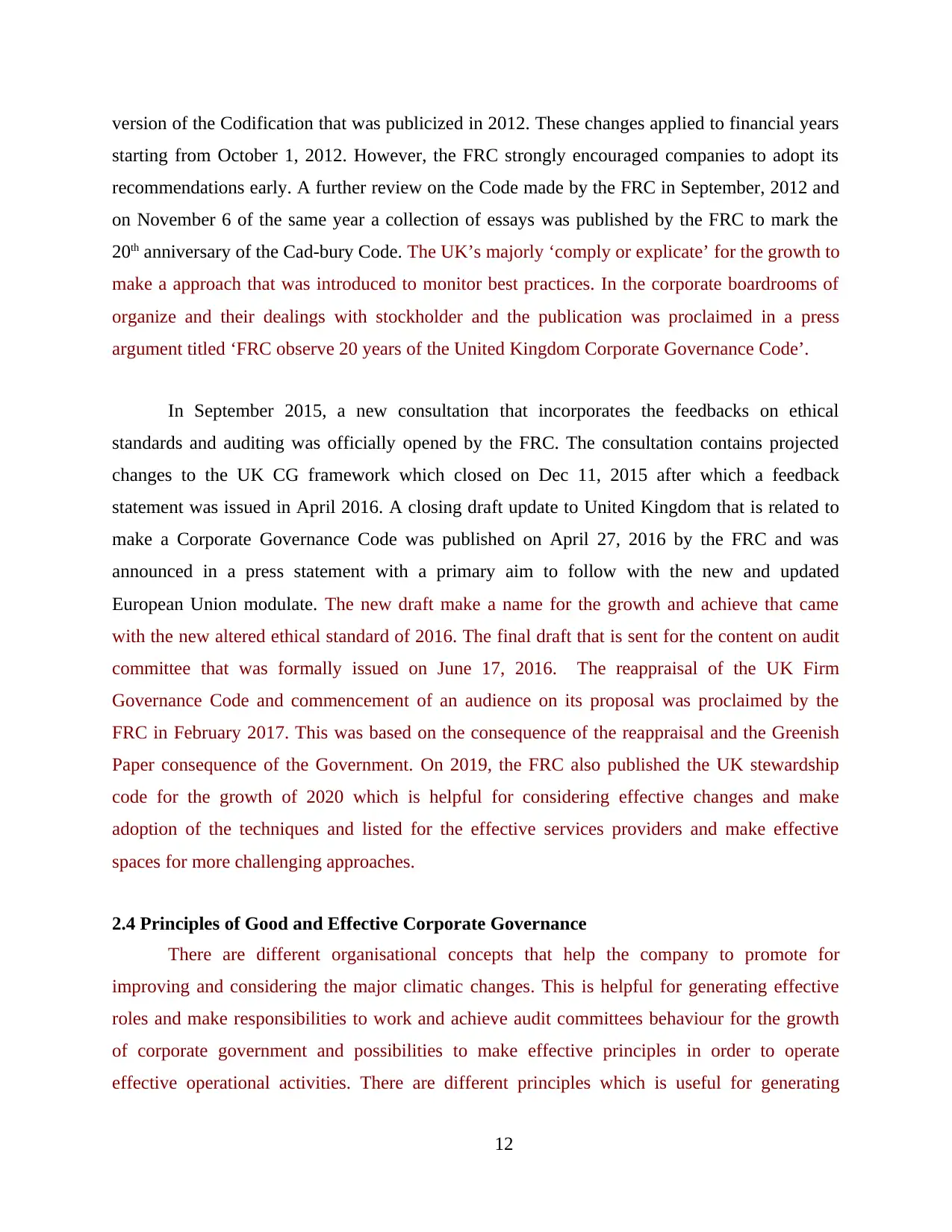
version of the Codification that was publicized in 2012. These changes applied to financial years
starting from October 1, 2012. However, the FRC strongly encouraged companies to adopt its
recommendations early. A further review on the Code made by the FRC in September, 2012 and
on November 6 of the same year a collection of essays was published by the FRC to mark the
20th anniversary of the Cad-bury Code. The UK’s majorly ‘comply or explicate’ for the growth to
make a approach that was introduced to monitor best practices. In the corporate boardrooms of
organize and their dealings with stockholder and the publication was proclaimed in a press
argument titled ‘FRC observe 20 years of the United Kingdom Corporate Governance Code’.
In September 2015, a new consultation that incorporates the feedbacks on ethical
standards and auditing was officially opened by the FRC. The consultation contains projected
changes to the UK CG framework which closed on Dec 11, 2015 after which a feedback
statement was issued in April 2016. A closing draft update to United Kingdom that is related to
make a Corporate Governance Code was published on April 27, 2016 by the FRC and was
announced in a press statement with a primary aim to follow with the new and updated
European Union modulate. The new draft make a name for the growth and achieve that came
with the new altered ethical standard of 2016. The final draft that is sent for the content on audit
committee that was formally issued on June 17, 2016. The reappraisal of the UK Firm
Governance Code and commencement of an audience on its proposal was proclaimed by the
FRC in February 2017. This was based on the consequence of the reappraisal and the Greenish
Paper consequence of the Government. On 2019, the FRC also published the UK stewardship
code for the growth of 2020 which is helpful for considering effective changes and make
adoption of the techniques and listed for the effective services providers and make effective
spaces for more challenging approaches.
2.4 Principles of Good and Effective Corporate Governance
There are different organisational concepts that help the company to promote for
improving and considering the major climatic changes. This is helpful for generating effective
roles and make responsibilities to work and achieve audit committees behaviour for the growth
of corporate government and possibilities to make effective principles in order to operate
effective operational activities. There are different principles which is useful for generating
12
starting from October 1, 2012. However, the FRC strongly encouraged companies to adopt its
recommendations early. A further review on the Code made by the FRC in September, 2012 and
on November 6 of the same year a collection of essays was published by the FRC to mark the
20th anniversary of the Cad-bury Code. The UK’s majorly ‘comply or explicate’ for the growth to
make a approach that was introduced to monitor best practices. In the corporate boardrooms of
organize and their dealings with stockholder and the publication was proclaimed in a press
argument titled ‘FRC observe 20 years of the United Kingdom Corporate Governance Code’.
In September 2015, a new consultation that incorporates the feedbacks on ethical
standards and auditing was officially opened by the FRC. The consultation contains projected
changes to the UK CG framework which closed on Dec 11, 2015 after which a feedback
statement was issued in April 2016. A closing draft update to United Kingdom that is related to
make a Corporate Governance Code was published on April 27, 2016 by the FRC and was
announced in a press statement with a primary aim to follow with the new and updated
European Union modulate. The new draft make a name for the growth and achieve that came
with the new altered ethical standard of 2016. The final draft that is sent for the content on audit
committee that was formally issued on June 17, 2016. The reappraisal of the UK Firm
Governance Code and commencement of an audience on its proposal was proclaimed by the
FRC in February 2017. This was based on the consequence of the reappraisal and the Greenish
Paper consequence of the Government. On 2019, the FRC also published the UK stewardship
code for the growth of 2020 which is helpful for considering effective changes and make
adoption of the techniques and listed for the effective services providers and make effective
spaces for more challenging approaches.
2.4 Principles of Good and Effective Corporate Governance
There are different organisational concepts that help the company to promote for
improving and considering the major climatic changes. This is helpful for generating effective
roles and make responsibilities to work and achieve audit committees behaviour for the growth
of corporate government and possibilities to make effective principles in order to operate
effective operational activities. There are different principles which is useful for generating
12

integrity, respect and make a corporative culture for the growth of an individual and market
growth. There ten major principle are related to; effective solid foundation for the growth of
management and oversight behavioural activities. This is helpful for analysing board vales and
their progress, promote ethical and responsible to make effective decision-making process in the
UK market. Another principle is related to timely balanced promotion and make suitable changes
for respecting girls and reduce the discrimination to make suitable challenges in the market. All
is related to make legitimate interest of their stakeholders and achieve higher value in the market.
The study of Okpara (2011) suggested that an organisation must clearly spell out its roles
and responsibilities if it aspires to achieve effectiveness and efficiency in its governance. This
means that the organisation must explicitly portray its short and long term goals, including
stakeholders’ expectations, roles of the executives and other management staff and individual
responsibilities. To maintain a sound structure and composition of the organisation the executive
committee must work closely with the right group of people that are result oriented with a
positive mind set and have a good background of each individual, experience and required skills,
and the impact of employing an additional worker on the overall productivity of the organisation
and the effective functioning of the committee (Dillard et al., 2004). The executive committee
can help facilitate the likelihood that their organisations will deliver on their purpose (Dart,
2004). An effective and good governance of an organization will require the executive
committee to effectively determine and assess the appropriate performance, indicators and
categories for the organization. It is quite pertinent that the executive committee ensures a free
and timely flow of relevant information to the executive board that helps in making useful
decisions (Bravo et al, 2019). There must be accountability and transparency for external
stakeholders to enable know that their resources are being utilized in more effective and efficient
manner. Furthermore, the financial statement of the organization must reflect integrity and
safeguard other relevant information. For an effective and good governance to be achieved the
executive committee must ensure to sustain and enhance the capabilities and capacity of the
organization in which they serve (Cohen et al, 2007).
2.5 The Importance of Good and the Effective Corporate Governance
If effectively and efficiently carried out, corporate governance will create an open and
honest business environment which will encourage structure in terms of speed of execution,
planning, and also encourages the executive committees and board members to allocate more
13
growth. There ten major principle are related to; effective solid foundation for the growth of
management and oversight behavioural activities. This is helpful for analysing board vales and
their progress, promote ethical and responsible to make effective decision-making process in the
UK market. Another principle is related to timely balanced promotion and make suitable changes
for respecting girls and reduce the discrimination to make suitable challenges in the market. All
is related to make legitimate interest of their stakeholders and achieve higher value in the market.
The study of Okpara (2011) suggested that an organisation must clearly spell out its roles
and responsibilities if it aspires to achieve effectiveness and efficiency in its governance. This
means that the organisation must explicitly portray its short and long term goals, including
stakeholders’ expectations, roles of the executives and other management staff and individual
responsibilities. To maintain a sound structure and composition of the organisation the executive
committee must work closely with the right group of people that are result oriented with a
positive mind set and have a good background of each individual, experience and required skills,
and the impact of employing an additional worker on the overall productivity of the organisation
and the effective functioning of the committee (Dillard et al., 2004). The executive committee
can help facilitate the likelihood that their organisations will deliver on their purpose (Dart,
2004). An effective and good governance of an organization will require the executive
committee to effectively determine and assess the appropriate performance, indicators and
categories for the organization. It is quite pertinent that the executive committee ensures a free
and timely flow of relevant information to the executive board that helps in making useful
decisions (Bravo et al, 2019). There must be accountability and transparency for external
stakeholders to enable know that their resources are being utilized in more effective and efficient
manner. Furthermore, the financial statement of the organization must reflect integrity and
safeguard other relevant information. For an effective and good governance to be achieved the
executive committee must ensure to sustain and enhance the capabilities and capacity of the
organization in which they serve (Cohen et al, 2007).
2.5 The Importance of Good and the Effective Corporate Governance
If effectively and efficiently carried out, corporate governance will create an open and
honest business environment which will encourage structure in terms of speed of execution,
planning, and also encourages the executive committees and board members to allocate more
13
Paraphrase This Document
Need a fresh take? Get an instant paraphrase of this document with our AI Paraphraser
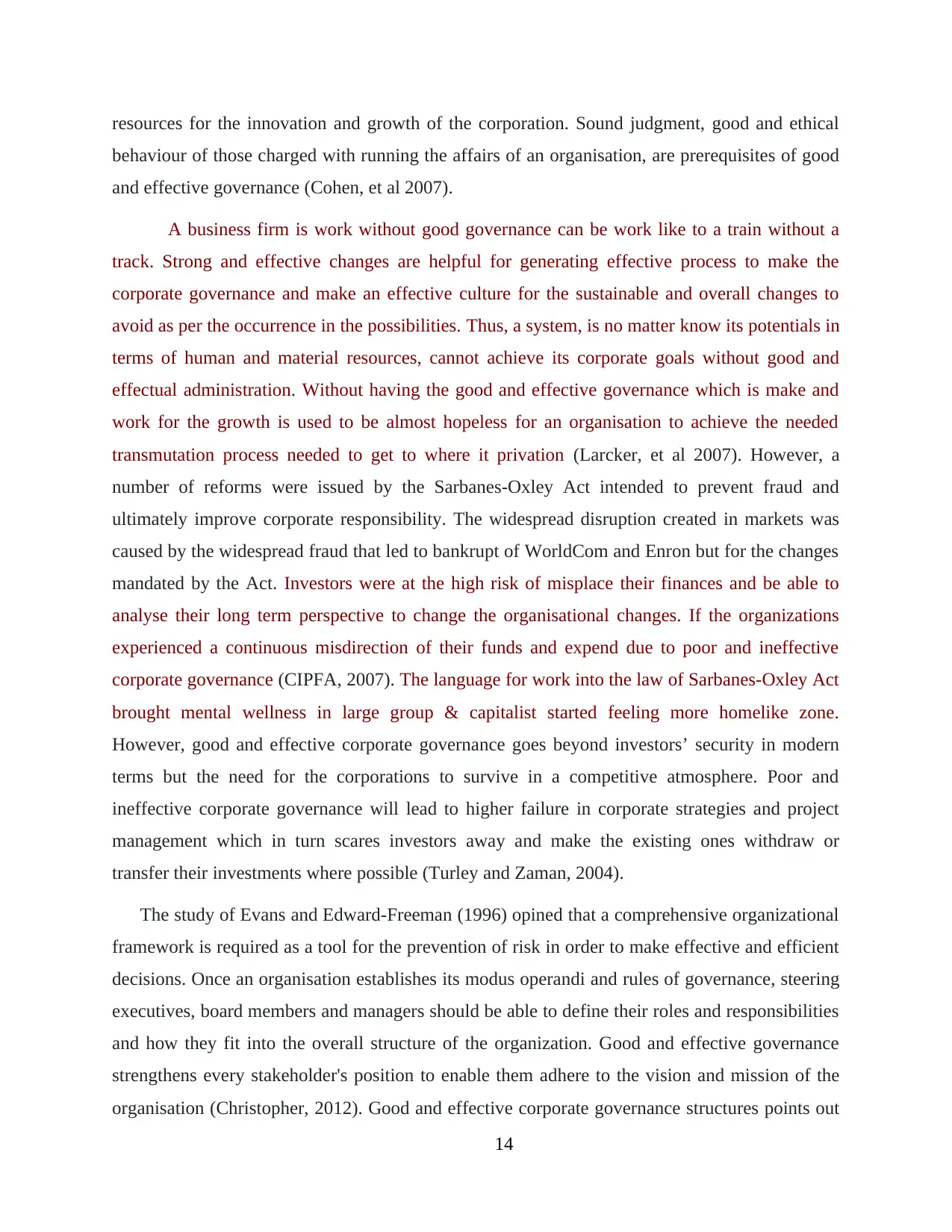
resources for the innovation and growth of the corporation. Sound judgment, good and ethical
behaviour of those charged with running the affairs of an organisation, are prerequisites of good
and effective governance (Cohen, et al 2007).
A business firm is work without good governance can be work like to a train without a
track. Strong and effective changes are helpful for generating effective process to make the
corporate governance and make an effective culture for the sustainable and overall changes to
avoid as per the occurrence in the possibilities. Thus, a system, is no matter know its potentials in
terms of human and material resources, cannot achieve its corporate goals without good and
effectual administration. Without having the good and effective governance which is make and
work for the growth is used to be almost hopeless for an organisation to achieve the needed
transmutation process needed to get to where it privation (Larcker, et al 2007). However, a
number of reforms were issued by the Sarbanes-Oxley Act intended to prevent fraud and
ultimately improve corporate responsibility. The widespread disruption created in markets was
caused by the widespread fraud that led to bankrupt of WorldCom and Enron but for the changes
mandated by the Act. Investors were at the high risk of misplace their finances and be able to
analyse their long term perspective to change the organisational changes. If the organizations
experienced a continuous misdirection of their funds and expend due to poor and ineffective
corporate governance (CIPFA, 2007). The language for work into the law of Sarbanes-Oxley Act
brought mental wellness in large group & capitalist started feeling more homelike zone.
However, good and effective corporate governance goes beyond investors’ security in modern
terms but the need for the corporations to survive in a competitive atmosphere. Poor and
ineffective corporate governance will lead to higher failure in corporate strategies and project
management which in turn scares investors away and make the existing ones withdraw or
transfer their investments where possible (Turley and Zaman, 2004).
The study of Evans and Edward-Freeman (1996) opined that a comprehensive organizational
framework is required as a tool for the prevention of risk in order to make effective and efficient
decisions. Once an organisation establishes its modus operandi and rules of governance, steering
executives, board members and managers should be able to define their roles and responsibilities
and how they fit into the overall structure of the organization. Good and effective governance
strengthens every stakeholder's position to enable them adhere to the vision and mission of the
organisation (Christopher, 2012). Good and effective corporate governance structures points out
14
behaviour of those charged with running the affairs of an organisation, are prerequisites of good
and effective governance (Cohen, et al 2007).
A business firm is work without good governance can be work like to a train without a
track. Strong and effective changes are helpful for generating effective process to make the
corporate governance and make an effective culture for the sustainable and overall changes to
avoid as per the occurrence in the possibilities. Thus, a system, is no matter know its potentials in
terms of human and material resources, cannot achieve its corporate goals without good and
effectual administration. Without having the good and effective governance which is make and
work for the growth is used to be almost hopeless for an organisation to achieve the needed
transmutation process needed to get to where it privation (Larcker, et al 2007). However, a
number of reforms were issued by the Sarbanes-Oxley Act intended to prevent fraud and
ultimately improve corporate responsibility. The widespread disruption created in markets was
caused by the widespread fraud that led to bankrupt of WorldCom and Enron but for the changes
mandated by the Act. Investors were at the high risk of misplace their finances and be able to
analyse their long term perspective to change the organisational changes. If the organizations
experienced a continuous misdirection of their funds and expend due to poor and ineffective
corporate governance (CIPFA, 2007). The language for work into the law of Sarbanes-Oxley Act
brought mental wellness in large group & capitalist started feeling more homelike zone.
However, good and effective corporate governance goes beyond investors’ security in modern
terms but the need for the corporations to survive in a competitive atmosphere. Poor and
ineffective corporate governance will lead to higher failure in corporate strategies and project
management which in turn scares investors away and make the existing ones withdraw or
transfer their investments where possible (Turley and Zaman, 2004).
The study of Evans and Edward-Freeman (1996) opined that a comprehensive organizational
framework is required as a tool for the prevention of risk in order to make effective and efficient
decisions. Once an organisation establishes its modus operandi and rules of governance, steering
executives, board members and managers should be able to define their roles and responsibilities
and how they fit into the overall structure of the organization. Good and effective governance
strengthens every stakeholder's position to enable them adhere to the vision and mission of the
organisation (Christopher, 2012). Good and effective corporate governance structures points out
14
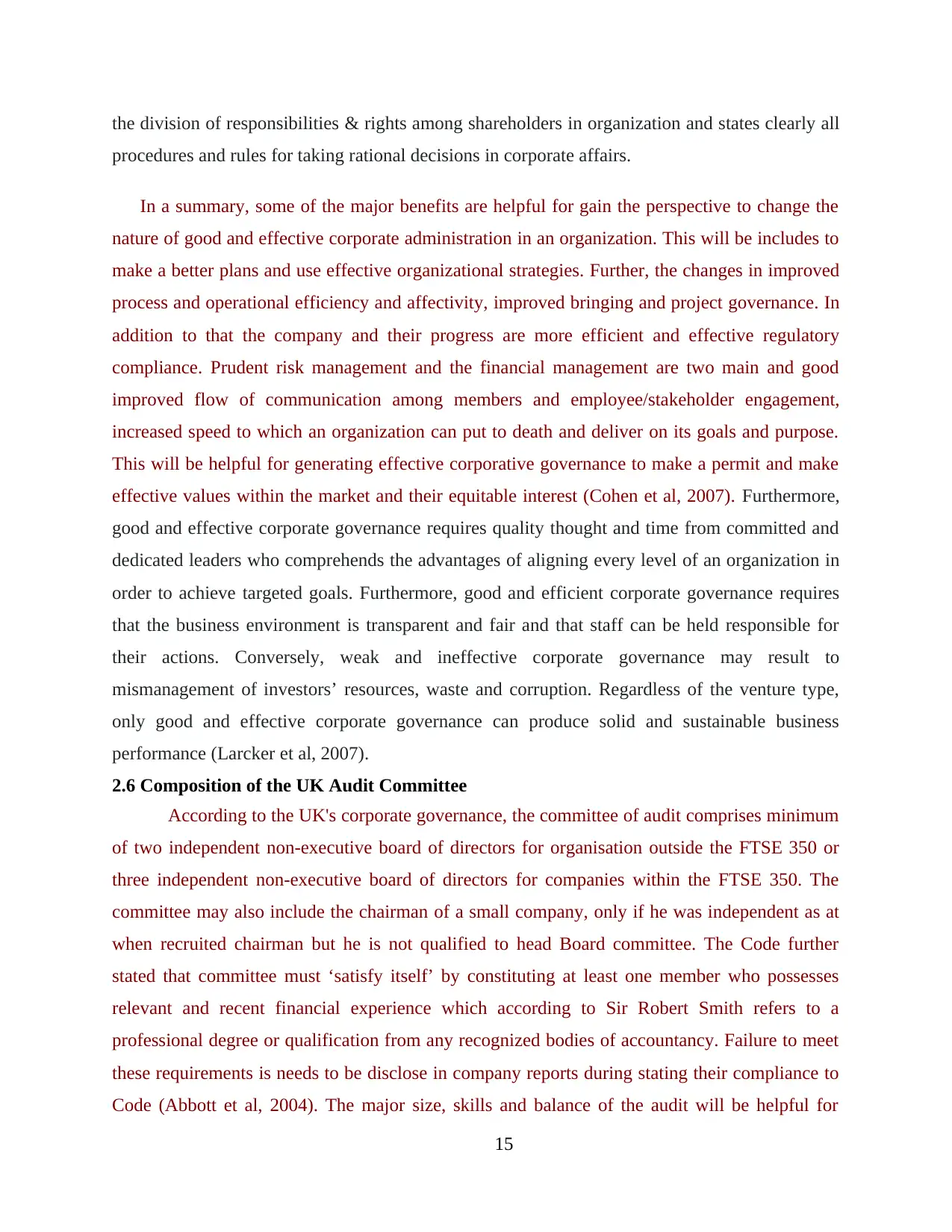
the division of responsibilities & rights among shareholders in organization and states clearly all
procedures and rules for taking rational decisions in corporate affairs.
In a summary, some of the major benefits are helpful for gain the perspective to change the
nature of good and effective corporate administration in an organization. This will be includes to
make a better plans and use effective organizational strategies. Further, the changes in improved
process and operational efficiency and affectivity, improved bringing and project governance. In
addition to that the company and their progress are more efficient and effective regulatory
compliance. Prudent risk management and the financial management are two main and good
improved flow of communication among members and employee/stakeholder engagement,
increased speed to which an organization can put to death and deliver on its goals and purpose.
This will be helpful for generating effective corporative governance to make a permit and make
effective values within the market and their equitable interest (Cohen et al, 2007). Furthermore,
good and effective corporate governance requires quality thought and time from committed and
dedicated leaders who comprehends the advantages of aligning every level of an organization in
order to achieve targeted goals. Furthermore, good and efficient corporate governance requires
that the business environment is transparent and fair and that staff can be held responsible for
their actions. Conversely, weak and ineffective corporate governance may result to
mismanagement of investors’ resources, waste and corruption. Regardless of the venture type,
only good and effective corporate governance can produce solid and sustainable business
performance (Larcker et al, 2007).
2.6 Composition of the UK Audit Committee
According to the UK's corporate governance, the committee of audit comprises minimum
of two independent non-executive board of directors for organisation outside the FTSE 350 or
three independent non-executive board of directors for companies within the FTSE 350. The
committee may also include the chairman of a small company, only if he was independent as at
when recruited chairman but he is not qualified to head Board committee. The Code further
stated that committee must ‘satisfy itself’ by constituting at least one member who possesses
relevant and recent financial experience which according to Sir Robert Smith refers to a
professional degree or qualification from any recognized bodies of accountancy. Failure to meet
these requirements is needs to be disclose in company reports during stating their compliance to
Code (Abbott et al, 2004). The major size, skills and balance of the audit will be helpful for
15
procedures and rules for taking rational decisions in corporate affairs.
In a summary, some of the major benefits are helpful for gain the perspective to change the
nature of good and effective corporate administration in an organization. This will be includes to
make a better plans and use effective organizational strategies. Further, the changes in improved
process and operational efficiency and affectivity, improved bringing and project governance. In
addition to that the company and their progress are more efficient and effective regulatory
compliance. Prudent risk management and the financial management are two main and good
improved flow of communication among members and employee/stakeholder engagement,
increased speed to which an organization can put to death and deliver on its goals and purpose.
This will be helpful for generating effective corporative governance to make a permit and make
effective values within the market and their equitable interest (Cohen et al, 2007). Furthermore,
good and effective corporate governance requires quality thought and time from committed and
dedicated leaders who comprehends the advantages of aligning every level of an organization in
order to achieve targeted goals. Furthermore, good and efficient corporate governance requires
that the business environment is transparent and fair and that staff can be held responsible for
their actions. Conversely, weak and ineffective corporate governance may result to
mismanagement of investors’ resources, waste and corruption. Regardless of the venture type,
only good and effective corporate governance can produce solid and sustainable business
performance (Larcker et al, 2007).
2.6 Composition of the UK Audit Committee
According to the UK's corporate governance, the committee of audit comprises minimum
of two independent non-executive board of directors for organisation outside the FTSE 350 or
three independent non-executive board of directors for companies within the FTSE 350. The
committee may also include the chairman of a small company, only if he was independent as at
when recruited chairman but he is not qualified to head Board committee. The Code further
stated that committee must ‘satisfy itself’ by constituting at least one member who possesses
relevant and recent financial experience which according to Sir Robert Smith refers to a
professional degree or qualification from any recognized bodies of accountancy. Failure to meet
these requirements is needs to be disclose in company reports during stating their compliance to
Code (Abbott et al, 2004). The major size, skills and balance of the audit will be helpful for
15
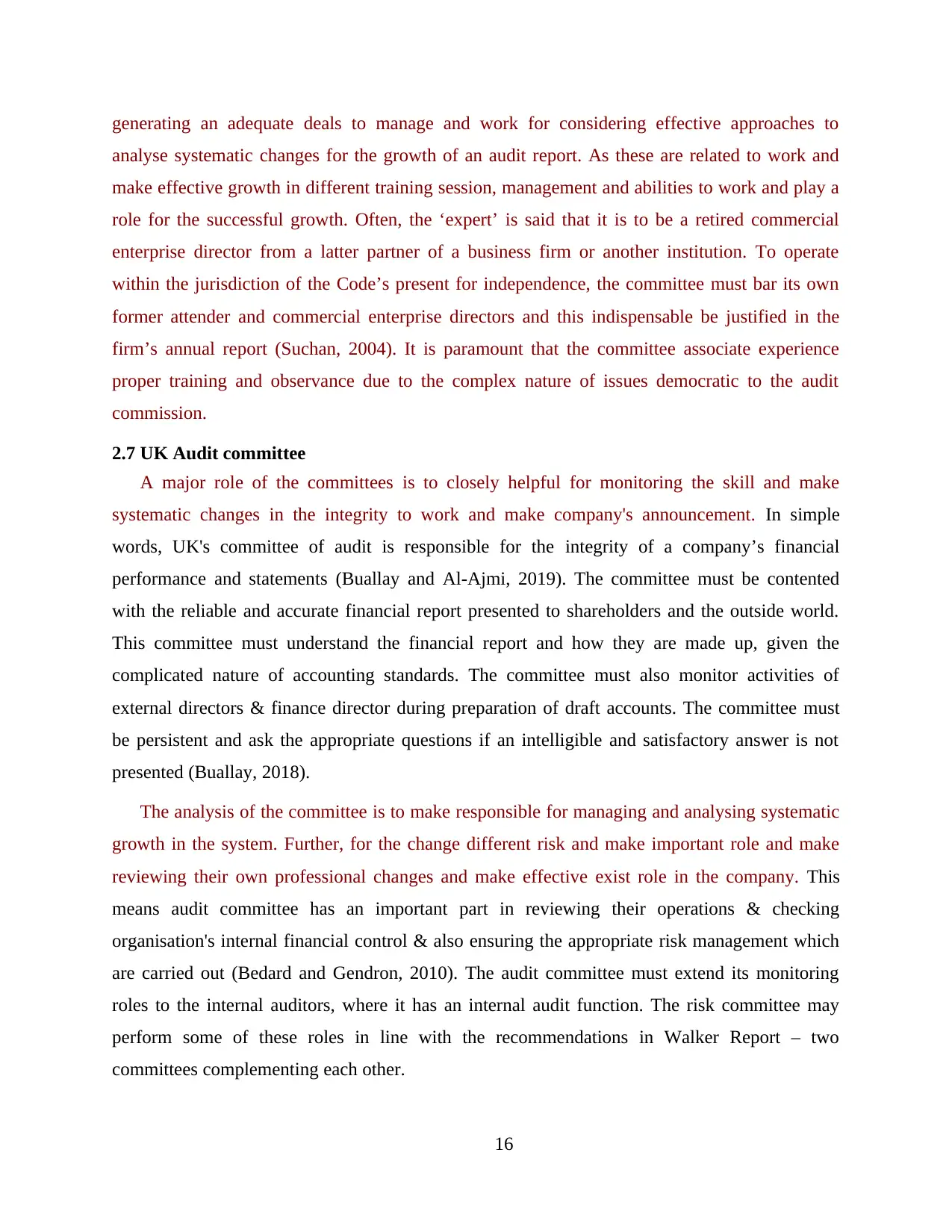
generating an adequate deals to manage and work for considering effective approaches to
analyse systematic changes for the growth of an audit report. As these are related to work and
make effective growth in different training session, management and abilities to work and play a
role for the successful growth. Often, the ‘expert’ is said that it is to be a retired commercial
enterprise director from a latter partner of a business firm or another institution. To operate
within the jurisdiction of the Code’s present for independence, the committee must bar its own
former attender and commercial enterprise directors and this indispensable be justified in the
firm’s annual report (Suchan, 2004). It is paramount that the committee associate experience
proper training and observance due to the complex nature of issues democratic to the audit
commission.
2.7 UK Audit committee
A major role of the committees is to closely helpful for monitoring the skill and make
systematic changes in the integrity to work and make company's announcement. In simple
words, UK's committee of audit is responsible for the integrity of a company’s financial
performance and statements (Buallay and Al-Ajmi, 2019). The committee must be contented
with the reliable and accurate financial report presented to shareholders and the outside world.
This committee must understand the financial report and how they are made up, given the
complicated nature of accounting standards. The committee must also monitor activities of
external directors & finance director during preparation of draft accounts. The committee must
be persistent and ask the appropriate questions if an intelligible and satisfactory answer is not
presented (Buallay, 2018).
The analysis of the committee is to make responsible for managing and analysing systematic
growth in the system. Further, for the change different risk and make important role and make
reviewing their own professional changes and make effective exist role in the company. This
means audit committee has an important part in reviewing their operations & checking
organisation's internal financial control & also ensuring the appropriate risk management which
are carried out (Bedard and Gendron, 2010). The audit committee must extend its monitoring
roles to the internal auditors, where it has an internal audit function. The risk committee may
perform some of these roles in line with the recommendations in Walker Report – two
committees complementing each other.
16
analyse systematic changes for the growth of an audit report. As these are related to work and
make effective growth in different training session, management and abilities to work and play a
role for the successful growth. Often, the ‘expert’ is said that it is to be a retired commercial
enterprise director from a latter partner of a business firm or another institution. To operate
within the jurisdiction of the Code’s present for independence, the committee must bar its own
former attender and commercial enterprise directors and this indispensable be justified in the
firm’s annual report (Suchan, 2004). It is paramount that the committee associate experience
proper training and observance due to the complex nature of issues democratic to the audit
commission.
2.7 UK Audit committee
A major role of the committees is to closely helpful for monitoring the skill and make
systematic changes in the integrity to work and make company's announcement. In simple
words, UK's committee of audit is responsible for the integrity of a company’s financial
performance and statements (Buallay and Al-Ajmi, 2019). The committee must be contented
with the reliable and accurate financial report presented to shareholders and the outside world.
This committee must understand the financial report and how they are made up, given the
complicated nature of accounting standards. The committee must also monitor activities of
external directors & finance director during preparation of draft accounts. The committee must
be persistent and ask the appropriate questions if an intelligible and satisfactory answer is not
presented (Buallay, 2018).
The analysis of the committee is to make responsible for managing and analysing systematic
growth in the system. Further, for the change different risk and make important role and make
reviewing their own professional changes and make effective exist role in the company. This
means audit committee has an important part in reviewing their operations & checking
organisation's internal financial control & also ensuring the appropriate risk management which
are carried out (Bedard and Gendron, 2010). The audit committee must extend its monitoring
roles to the internal auditors, where it has an internal audit function. The risk committee may
perform some of these roles in line with the recommendations in Walker Report – two
committees complementing each other.
16
Secure Best Marks with AI Grader
Need help grading? Try our AI Grader for instant feedback on your assignments.
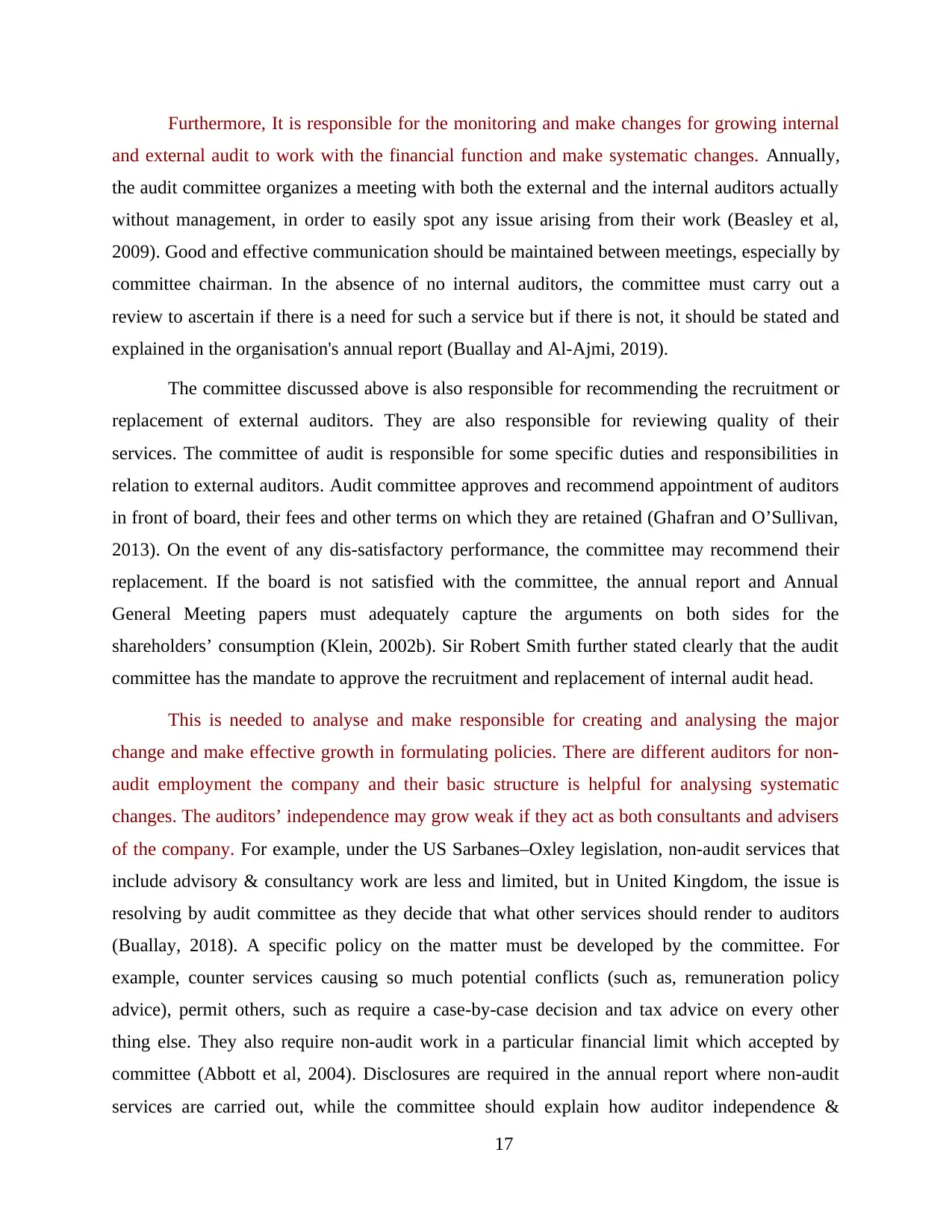
Furthermore, It is responsible for the monitoring and make changes for growing internal
and external audit to work with the financial function and make systematic changes. Annually,
the audit committee organizes a meeting with both the external and the internal auditors actually
without management, in order to easily spot any issue arising from their work (Beasley et al,
2009). Good and effective communication should be maintained between meetings, especially by
committee chairman. In the absence of no internal auditors, the committee must carry out a
review to ascertain if there is a need for such a service but if there is not, it should be stated and
explained in the organisation's annual report (Buallay and Al-Ajmi, 2019).
The committee discussed above is also responsible for recommending the recruitment or
replacement of external auditors. They are also responsible for reviewing quality of their
services. The committee of audit is responsible for some specific duties and responsibilities in
relation to external auditors. Audit committee approves and recommend appointment of auditors
in front of board, their fees and other terms on which they are retained (Ghafran and O’Sullivan,
2013). On the event of any dis-satisfactory performance, the committee may recommend their
replacement. If the board is not satisfied with the committee, the annual report and Annual
General Meeting papers must adequately capture the arguments on both sides for the
shareholders’ consumption (Klein, 2002b). Sir Robert Smith further stated clearly that the audit
committee has the mandate to approve the recruitment and replacement of internal audit head.
This is needed to analyse and make responsible for creating and analysing the major
change and make effective growth in formulating policies. There are different auditors for non-
audit employment the company and their basic structure is helpful for analysing systematic
changes. The auditors’ independence may grow weak if they act as both consultants and advisers
of the company. For example, under the US Sarbanes–Oxley legislation, non-audit services that
include advisory & consultancy work are less and limited, but in United Kingdom, the issue is
resolving by audit committee as they decide that what other services should render to auditors
(Buallay, 2018). A specific policy on the matter must be developed by the committee. For
example, counter services causing so much potential conflicts (such as, remuneration policy
advice), permit others, such as require a case-by-case decision and tax advice on every other
thing else. They also require non-audit work in a particular financial limit which accepted by
committee (Abbott et al, 2004). Disclosures are required in the annual report where non-audit
services are carried out, while the committee should explain how auditor independence &
17
and external audit to work with the financial function and make systematic changes. Annually,
the audit committee organizes a meeting with both the external and the internal auditors actually
without management, in order to easily spot any issue arising from their work (Beasley et al,
2009). Good and effective communication should be maintained between meetings, especially by
committee chairman. In the absence of no internal auditors, the committee must carry out a
review to ascertain if there is a need for such a service but if there is not, it should be stated and
explained in the organisation's annual report (Buallay and Al-Ajmi, 2019).
The committee discussed above is also responsible for recommending the recruitment or
replacement of external auditors. They are also responsible for reviewing quality of their
services. The committee of audit is responsible for some specific duties and responsibilities in
relation to external auditors. Audit committee approves and recommend appointment of auditors
in front of board, their fees and other terms on which they are retained (Ghafran and O’Sullivan,
2013). On the event of any dis-satisfactory performance, the committee may recommend their
replacement. If the board is not satisfied with the committee, the annual report and Annual
General Meeting papers must adequately capture the arguments on both sides for the
shareholders’ consumption (Klein, 2002b). Sir Robert Smith further stated clearly that the audit
committee has the mandate to approve the recruitment and replacement of internal audit head.
This is needed to analyse and make responsible for creating and analysing the major
change and make effective growth in formulating policies. There are different auditors for non-
audit employment the company and their basic structure is helpful for analysing systematic
changes. The auditors’ independence may grow weak if they act as both consultants and advisers
of the company. For example, under the US Sarbanes–Oxley legislation, non-audit services that
include advisory & consultancy work are less and limited, but in United Kingdom, the issue is
resolving by audit committee as they decide that what other services should render to auditors
(Buallay, 2018). A specific policy on the matter must be developed by the committee. For
example, counter services causing so much potential conflicts (such as, remuneration policy
advice), permit others, such as require a case-by-case decision and tax advice on every other
thing else. They also require non-audit work in a particular financial limit which accepted by
committee (Abbott et al, 2004). Disclosures are required in the annual report where non-audit
services are carried out, while the committee should explain how auditor independence &
17
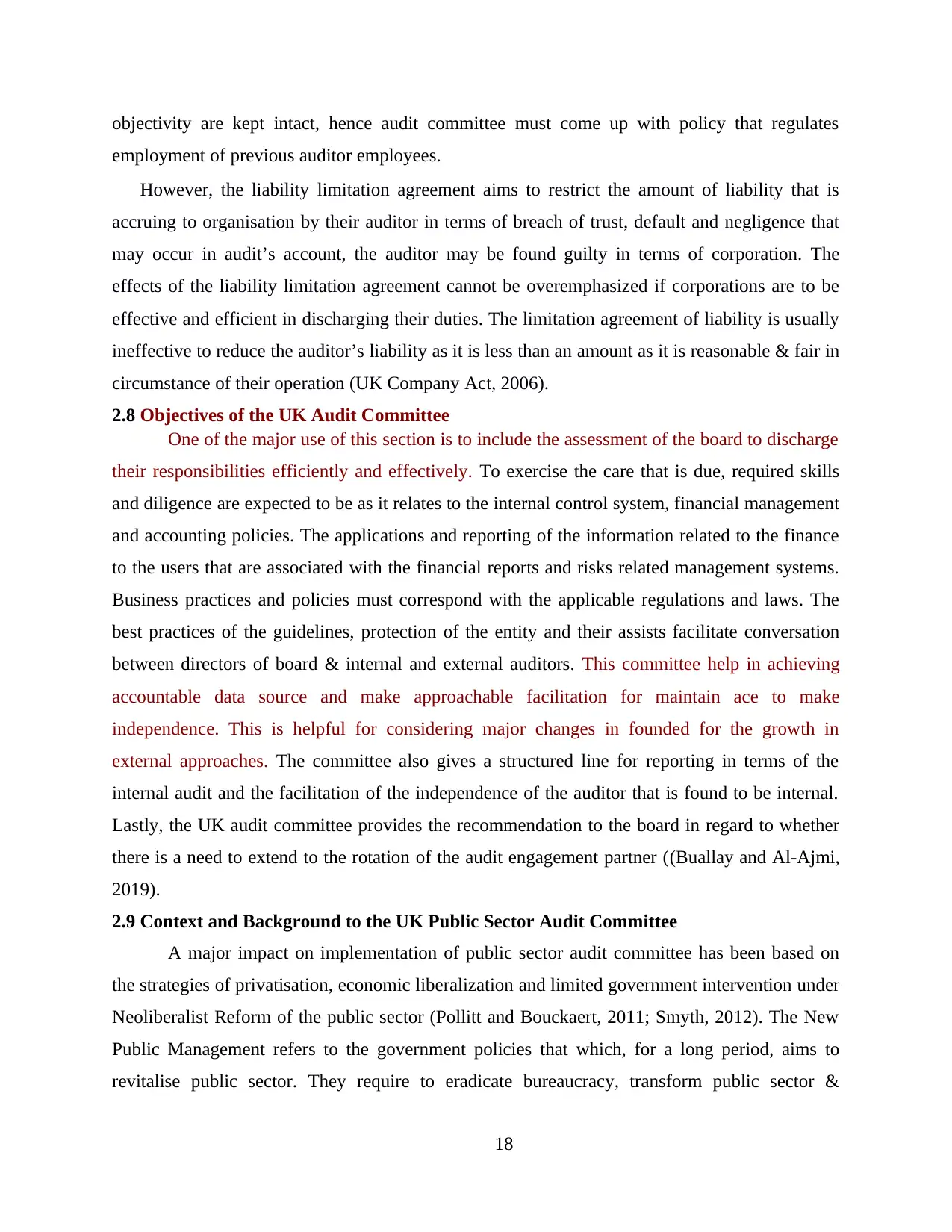
objectivity are kept intact, hence audit committee must come up with policy that regulates
employment of previous auditor employees.
However, the liability limitation agreement aims to restrict the amount of liability that is
accruing to organisation by their auditor in terms of breach of trust, default and negligence that
may occur in audit’s account, the auditor may be found guilty in terms of corporation. The
effects of the liability limitation agreement cannot be overemphasized if corporations are to be
effective and efficient in discharging their duties. The limitation agreement of liability is usually
ineffective to reduce the auditor’s liability as it is less than an amount as it is reasonable & fair in
circumstance of their operation (UK Company Act, 2006).
2.8 Objectives of the UK Audit Committee
One of the major use of this section is to include the assessment of the board to discharge
their responsibilities efficiently and effectively. To exercise the care that is due, required skills
and diligence are expected to be as it relates to the internal control system, financial management
and accounting policies. The applications and reporting of the information related to the finance
to the users that are associated with the financial reports and risks related management systems.
Business practices and policies must correspond with the applicable regulations and laws. The
best practices of the guidelines, protection of the entity and their assists facilitate conversation
between directors of board & internal and external auditors. This committee help in achieving
accountable data source and make approachable facilitation for maintain ace to make
independence. This is helpful for considering major changes in founded for the growth in
external approaches. The committee also gives a structured line for reporting in terms of the
internal audit and the facilitation of the independence of the auditor that is found to be internal.
Lastly, the UK audit committee provides the recommendation to the board in regard to whether
there is a need to extend to the rotation of the audit engagement partner ((Buallay and Al-Ajmi,
2019).
2.9 Context and Background to the UK Public Sector Audit Committee
A major impact on implementation of public sector audit committee has been based on
the strategies of privatisation, economic liberalization and limited government intervention under
Neoliberalist Reform of the public sector (Pollitt and Bouckaert, 2011; Smyth, 2012). The New
Public Management refers to the government policies that which, for a long period, aims to
revitalise public sector. They require to eradicate bureaucracy, transform public sector &
18
employment of previous auditor employees.
However, the liability limitation agreement aims to restrict the amount of liability that is
accruing to organisation by their auditor in terms of breach of trust, default and negligence that
may occur in audit’s account, the auditor may be found guilty in terms of corporation. The
effects of the liability limitation agreement cannot be overemphasized if corporations are to be
effective and efficient in discharging their duties. The limitation agreement of liability is usually
ineffective to reduce the auditor’s liability as it is less than an amount as it is reasonable & fair in
circumstance of their operation (UK Company Act, 2006).
2.8 Objectives of the UK Audit Committee
One of the major use of this section is to include the assessment of the board to discharge
their responsibilities efficiently and effectively. To exercise the care that is due, required skills
and diligence are expected to be as it relates to the internal control system, financial management
and accounting policies. The applications and reporting of the information related to the finance
to the users that are associated with the financial reports and risks related management systems.
Business practices and policies must correspond with the applicable regulations and laws. The
best practices of the guidelines, protection of the entity and their assists facilitate conversation
between directors of board & internal and external auditors. This committee help in achieving
accountable data source and make approachable facilitation for maintain ace to make
independence. This is helpful for considering major changes in founded for the growth in
external approaches. The committee also gives a structured line for reporting in terms of the
internal audit and the facilitation of the independence of the auditor that is found to be internal.
Lastly, the UK audit committee provides the recommendation to the board in regard to whether
there is a need to extend to the rotation of the audit engagement partner ((Buallay and Al-Ajmi,
2019).
2.9 Context and Background to the UK Public Sector Audit Committee
A major impact on implementation of public sector audit committee has been based on
the strategies of privatisation, economic liberalization and limited government intervention under
Neoliberalist Reform of the public sector (Pollitt and Bouckaert, 2011; Smyth, 2012). The New
Public Management refers to the government policies that which, for a long period, aims to
revitalise public sector. They require to eradicate bureaucracy, transform public sector &
18
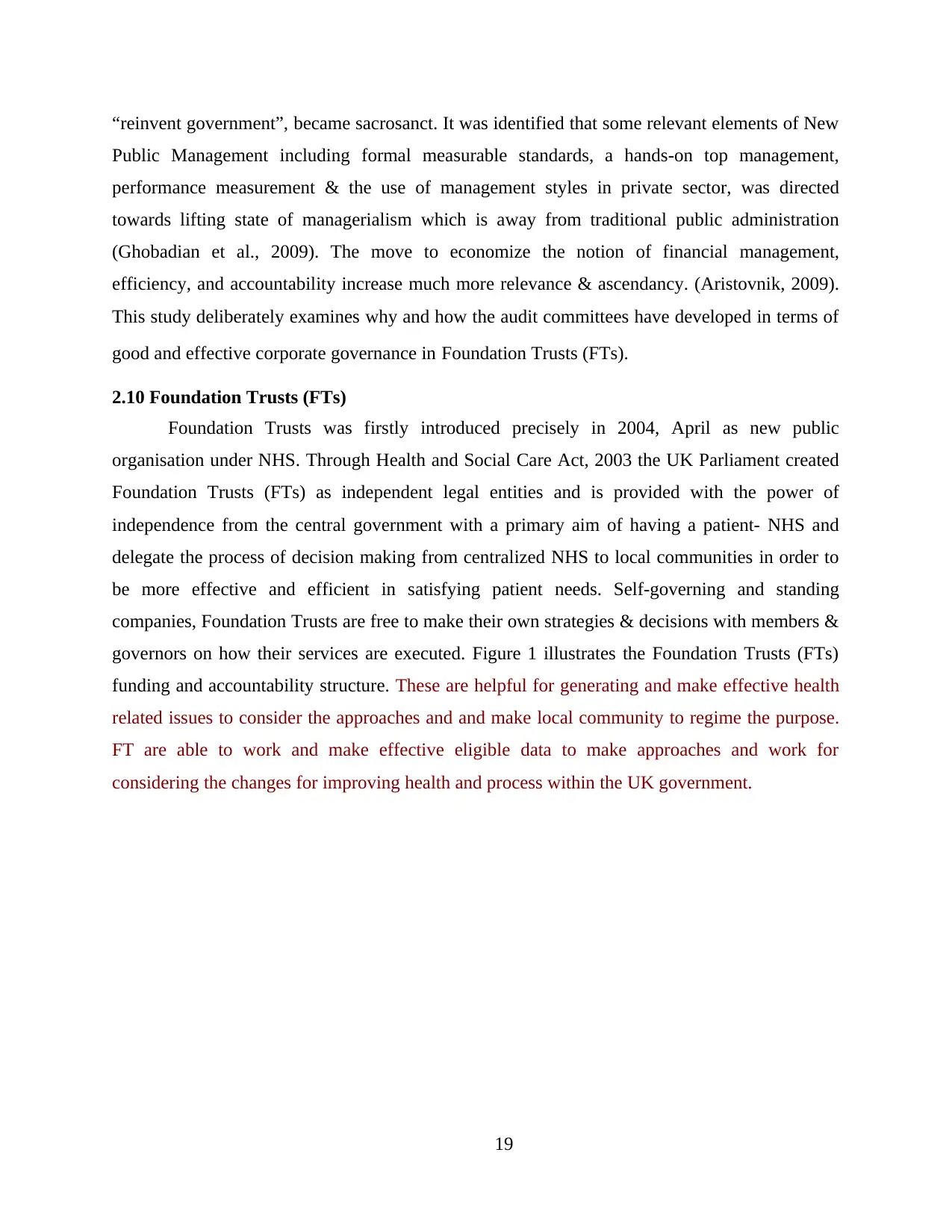
“reinvent government”, became sacrosanct. It was identified that some relevant elements of New
Public Management including formal measurable standards, a hands-on top management,
performance measurement & the use of management styles in private sector, was directed
towards lifting state of managerialism which is away from traditional public administration
(Ghobadian et al., 2009). The move to economize the notion of financial management,
efficiency, and accountability increase much more relevance & ascendancy. (Aristovnik, 2009).
This study deliberately examines why and how the audit committees have developed in terms of
good and effective corporate governance in Foundation Trusts (FTs).
2.10 Foundation Trusts (FTs)
Foundation Trusts was firstly introduced precisely in 2004, April as new public
organisation under NHS. Through Health and Social Care Act, 2003 the UK Parliament created
Foundation Trusts (FTs) as independent legal entities and is provided with the power of
independence from the central government with a primary aim of having a patient- NHS and
delegate the process of decision making from centralized NHS to local communities in order to
be more effective and efficient in satisfying patient needs. Self-governing and standing
companies, Foundation Trusts are free to make their own strategies & decisions with members &
governors on how their services are executed. Figure 1 illustrates the Foundation Trusts (FTs)
funding and accountability structure. These are helpful for generating and make effective health
related issues to consider the approaches and and make local community to regime the purpose.
FT are able to work and make effective eligible data to make approaches and work for
considering the changes for improving health and process within the UK government.
19
Public Management including formal measurable standards, a hands-on top management,
performance measurement & the use of management styles in private sector, was directed
towards lifting state of managerialism which is away from traditional public administration
(Ghobadian et al., 2009). The move to economize the notion of financial management,
efficiency, and accountability increase much more relevance & ascendancy. (Aristovnik, 2009).
This study deliberately examines why and how the audit committees have developed in terms of
good and effective corporate governance in Foundation Trusts (FTs).
2.10 Foundation Trusts (FTs)
Foundation Trusts was firstly introduced precisely in 2004, April as new public
organisation under NHS. Through Health and Social Care Act, 2003 the UK Parliament created
Foundation Trusts (FTs) as independent legal entities and is provided with the power of
independence from the central government with a primary aim of having a patient- NHS and
delegate the process of decision making from centralized NHS to local communities in order to
be more effective and efficient in satisfying patient needs. Self-governing and standing
companies, Foundation Trusts are free to make their own strategies & decisions with members &
governors on how their services are executed. Figure 1 illustrates the Foundation Trusts (FTs)
funding and accountability structure. These are helpful for generating and make effective health
related issues to consider the approaches and and make local community to regime the purpose.
FT are able to work and make effective eligible data to make approaches and work for
considering the changes for improving health and process within the UK government.
19
Paraphrase This Document
Need a fresh take? Get an instant paraphrase of this document with our AI Paraphraser
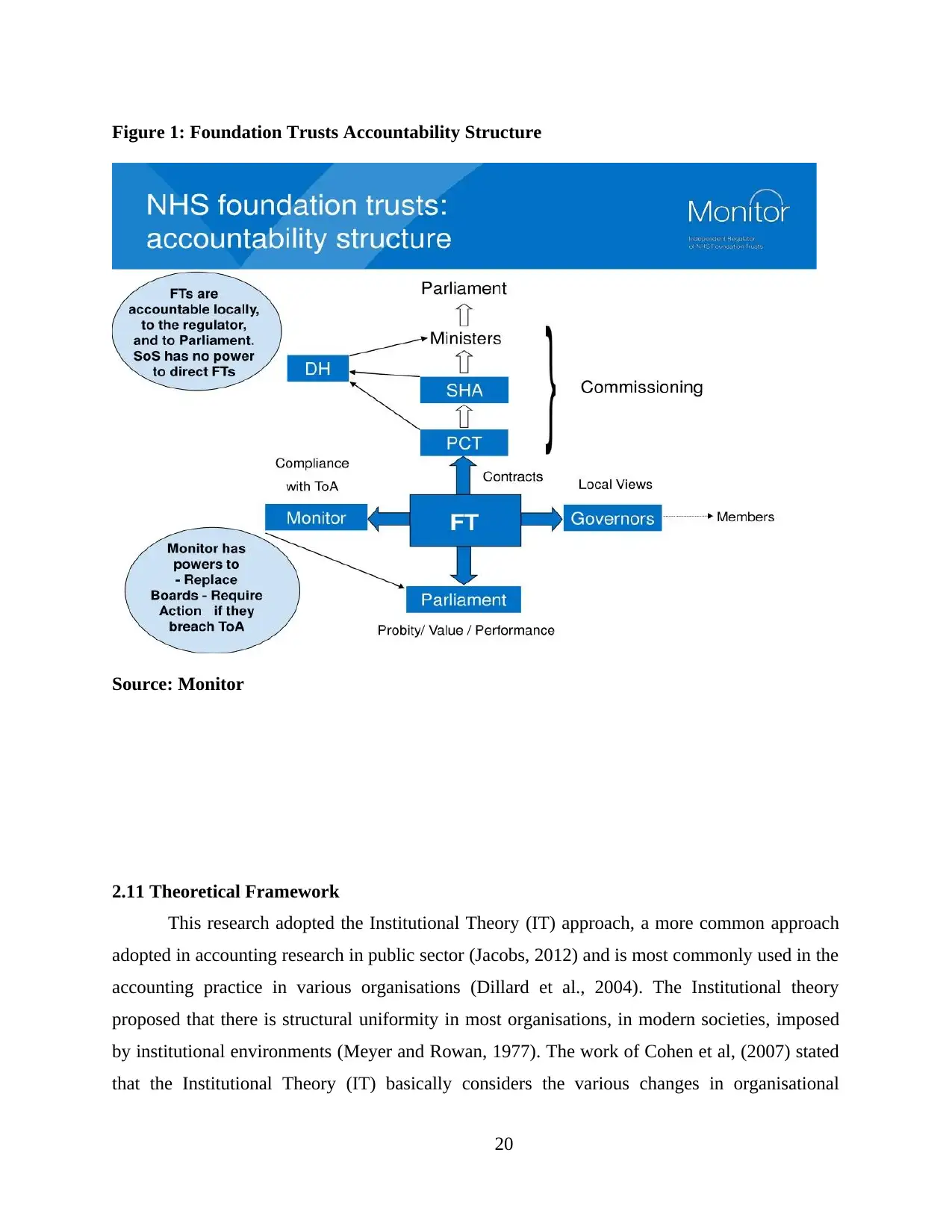
Figure 1: Foundation Trusts Accountability Structure
Source: Monitor
2.11 Theoretical Framework
This research adopted the Institutional Theory (IT) approach, a more common approach
adopted in accounting research in public sector (Jacobs, 2012) and is most commonly used in the
accounting practice in various organisations (Dillard et al., 2004). The Institutional theory
proposed that there is structural uniformity in most organisations, in modern societies, imposed
by institutional environments (Meyer and Rowan, 1977). The work of Cohen et al, (2007) stated
that the Institutional Theory (IT) basically considers the various changes in organisational
20
Source: Monitor
2.11 Theoretical Framework
This research adopted the Institutional Theory (IT) approach, a more common approach
adopted in accounting research in public sector (Jacobs, 2012) and is most commonly used in the
accounting practice in various organisations (Dillard et al., 2004). The Institutional theory
proposed that there is structural uniformity in most organisations, in modern societies, imposed
by institutional environments (Meyer and Rowan, 1977). The work of Cohen et al, (2007) stated
that the Institutional Theory (IT) basically considers the various changes in organisational
20

processes over time and also explains why organizations exhibit similar forms and
characteristics. The study of Dart (2004) revealed that the researchers opined that public sector is
transited into being competitive, corporate & has a more professional mode in operations, since
the NPM reforms was implemented into the public sector, and this has caused the embedding and
adoption of those practices that are institutionally acceptable at different organizational level.
Some relevant questions are raised when adopting the Institutional Theory (IT) to study the
Audit Committee as a mechanism of NPM-driven reform about how and why organisations in
the public sector are implementing audit committees whether for business efficiency or
legitimation (Broadbent and Guthrie, 1992; Lapsley, 1999). Besides, Institutional Theory (IT)
exhibit political core which suggests public sector companies that triggers & drives
institutionalization resulting from isomorphic mechanisms leading to the increasing homogeneity
inherent within the provided domains & which conform with expectations of broader
institutional surroundings. Organisations are seen to operate within a social set up of values and
norms which conform in order to reward for survival capabilities, increased resources, and
legitimacy (Hawley, 1968).
2.12 Summary
This chapter explicitly reviewed related literatures in development of roles and
responsibilities of UK audit committee for effective and good governance, taking Foundation
Trusts (FTs) as case study. Current literatures on the principles of good and effective
governance, importance of good and effective corporate governance, objectives of the UK audit
committee and its composition were reviewed. Others include the UK's corporate governance
codes & their evolution and roles of UK audit committee. These literatures were able to give a
clearer picture of the basic concepts of the study. The theoretical framework is based on the
Institutional Theory (IT) attack which is a more communal approach adoptive in public sector
accounting investigation. It would be effective and helpful for generating profit and make
suitable changes in the Literature review consent.
21
characteristics. The study of Dart (2004) revealed that the researchers opined that public sector is
transited into being competitive, corporate & has a more professional mode in operations, since
the NPM reforms was implemented into the public sector, and this has caused the embedding and
adoption of those practices that are institutionally acceptable at different organizational level.
Some relevant questions are raised when adopting the Institutional Theory (IT) to study the
Audit Committee as a mechanism of NPM-driven reform about how and why organisations in
the public sector are implementing audit committees whether for business efficiency or
legitimation (Broadbent and Guthrie, 1992; Lapsley, 1999). Besides, Institutional Theory (IT)
exhibit political core which suggests public sector companies that triggers & drives
institutionalization resulting from isomorphic mechanisms leading to the increasing homogeneity
inherent within the provided domains & which conform with expectations of broader
institutional surroundings. Organisations are seen to operate within a social set up of values and
norms which conform in order to reward for survival capabilities, increased resources, and
legitimacy (Hawley, 1968).
2.12 Summary
This chapter explicitly reviewed related literatures in development of roles and
responsibilities of UK audit committee for effective and good governance, taking Foundation
Trusts (FTs) as case study. Current literatures on the principles of good and effective
governance, importance of good and effective corporate governance, objectives of the UK audit
committee and its composition were reviewed. Others include the UK's corporate governance
codes & their evolution and roles of UK audit committee. These literatures were able to give a
clearer picture of the basic concepts of the study. The theoretical framework is based on the
Institutional Theory (IT) attack which is a more communal approach adoptive in public sector
accounting investigation. It would be effective and helpful for generating profit and make
suitable changes in the Literature review consent.
21
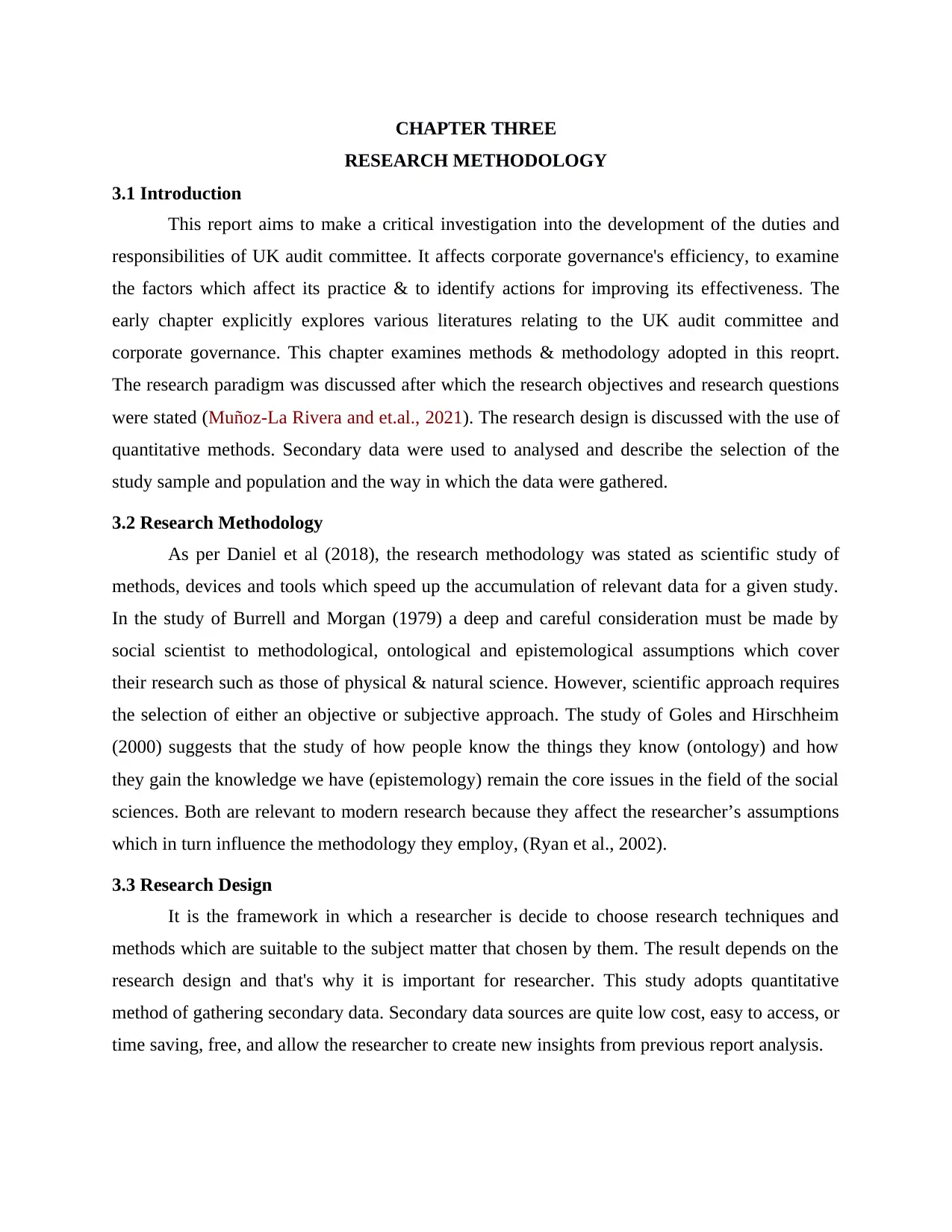
CHAPTER THREE
RESEARCH METHODOLOGY
3.1 Introduction
This report aims to make a critical investigation into the development of the duties and
responsibilities of UK audit committee. It affects corporate governance's efficiency, to examine
the factors which affect its practice & to identify actions for improving its effectiveness. The
early chapter explicitly explores various literatures relating to the UK audit committee and
corporate governance. This chapter examines methods & methodology adopted in this reoprt.
The research paradigm was discussed after which the research objectives and research questions
were stated (Muñoz-La Rivera and et.al., 2021). The research design is discussed with the use of
quantitative methods. Secondary data were used to analysed and describe the selection of the
study sample and population and the way in which the data were gathered.
3.2 Research Methodology
As per Daniel et al (2018), the research methodology was stated as scientific study of
methods, devices and tools which speed up the accumulation of relevant data for a given study.
In the study of Burrell and Morgan (1979) a deep and careful consideration must be made by
social scientist to methodological, ontological and epistemological assumptions which cover
their research such as those of physical & natural science. However, scientific approach requires
the selection of either an objective or subjective approach. The study of Goles and Hirschheim
(2000) suggests that the study of how people know the things they know (ontology) and how
they gain the knowledge we have (epistemology) remain the core issues in the field of the social
sciences. Both are relevant to modern research because they affect the researcher’s assumptions
which in turn influence the methodology they employ, (Ryan et al., 2002).
3.3 Research Design
It is the framework in which a researcher is decide to choose research techniques and
methods which are suitable to the subject matter that chosen by them. The result depends on the
research design and that's why it is important for researcher. This study adopts quantitative
method of gathering secondary data. Secondary data sources are quite low cost, easy to access, or
time saving, free, and allow the researcher to create new insights from previous report analysis.
RESEARCH METHODOLOGY
3.1 Introduction
This report aims to make a critical investigation into the development of the duties and
responsibilities of UK audit committee. It affects corporate governance's efficiency, to examine
the factors which affect its practice & to identify actions for improving its effectiveness. The
early chapter explicitly explores various literatures relating to the UK audit committee and
corporate governance. This chapter examines methods & methodology adopted in this reoprt.
The research paradigm was discussed after which the research objectives and research questions
were stated (Muñoz-La Rivera and et.al., 2021). The research design is discussed with the use of
quantitative methods. Secondary data were used to analysed and describe the selection of the
study sample and population and the way in which the data were gathered.
3.2 Research Methodology
As per Daniel et al (2018), the research methodology was stated as scientific study of
methods, devices and tools which speed up the accumulation of relevant data for a given study.
In the study of Burrell and Morgan (1979) a deep and careful consideration must be made by
social scientist to methodological, ontological and epistemological assumptions which cover
their research such as those of physical & natural science. However, scientific approach requires
the selection of either an objective or subjective approach. The study of Goles and Hirschheim
(2000) suggests that the study of how people know the things they know (ontology) and how
they gain the knowledge we have (epistemology) remain the core issues in the field of the social
sciences. Both are relevant to modern research because they affect the researcher’s assumptions
which in turn influence the methodology they employ, (Ryan et al., 2002).
3.3 Research Design
It is the framework in which a researcher is decide to choose research techniques and
methods which are suitable to the subject matter that chosen by them. The result depends on the
research design and that's why it is important for researcher. This study adopts quantitative
method of gathering secondary data. Secondary data sources are quite low cost, easy to access, or
time saving, free, and allow the researcher to create new insights from previous report analysis.
Secure Best Marks with AI Grader
Need help grading? Try our AI Grader for instant feedback on your assignments.
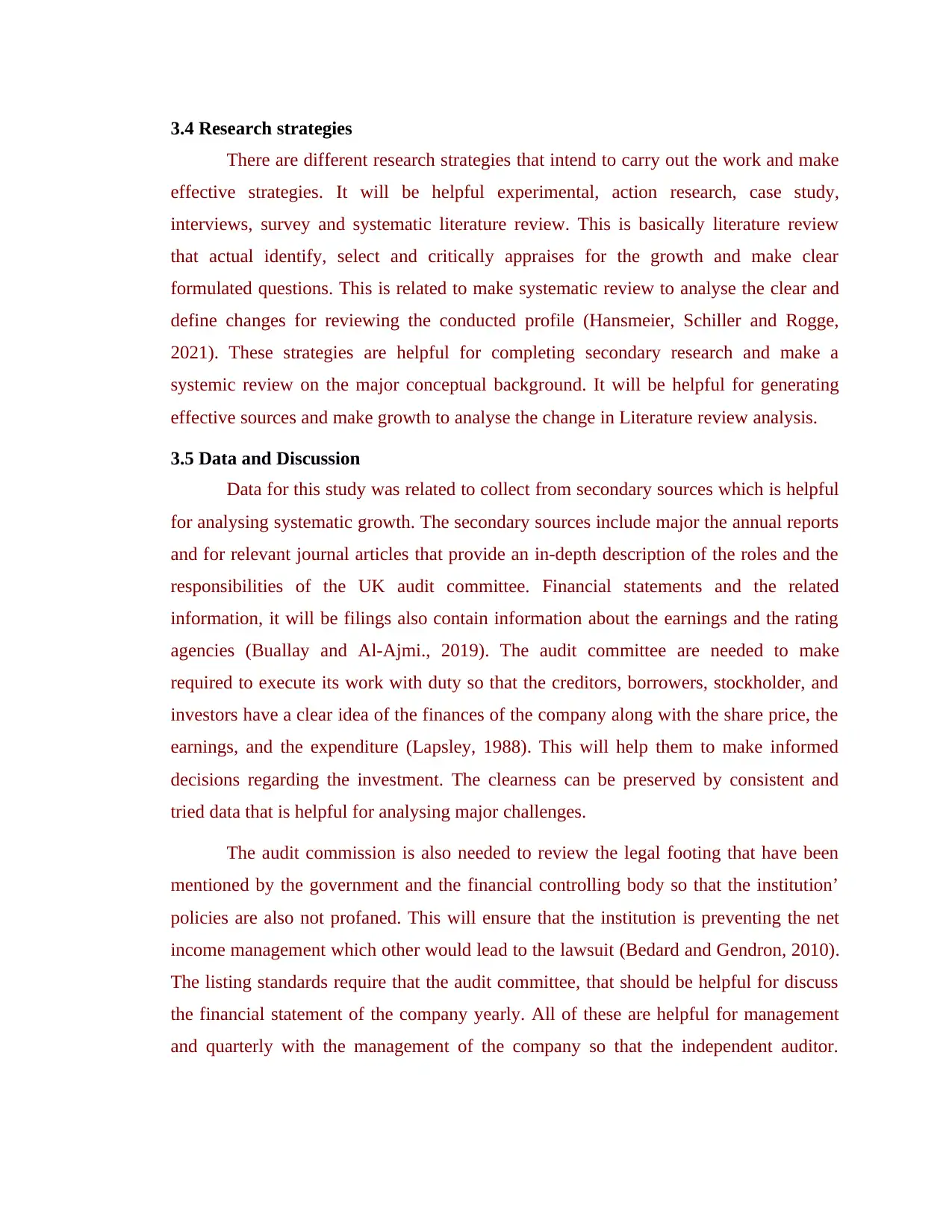
3.4 Research strategies
There are different research strategies that intend to carry out the work and make
effective strategies. It will be helpful experimental, action research, case study,
interviews, survey and systematic literature review. This is basically literature review
that actual identify, select and critically appraises for the growth and make clear
formulated questions. This is related to make systematic review to analyse the clear and
define changes for reviewing the conducted profile (Hansmeier, Schiller and Rogge,
2021). These strategies are helpful for completing secondary research and make a
systemic review on the major conceptual background. It will be helpful for generating
effective sources and make growth to analyse the change in Literature review analysis.
3.5 Data and Discussion
Data for this study was related to collect from secondary sources which is helpful
for analysing systematic growth. The secondary sources include major the annual reports
and for relevant journal articles that provide an in-depth description of the roles and the
responsibilities of the UK audit committee. Financial statements and the related
information, it will be filings also contain information about the earnings and the rating
agencies (Buallay and Al-Ajmi., 2019). The audit committee are needed to make
required to execute its work with duty so that the creditors, borrowers, stockholder, and
investors have a clear idea of the finances of the company along with the share price, the
earnings, and the expenditure (Lapsley, 1988). This will help them to make informed
decisions regarding the investment. The clearness can be preserved by consistent and
tried data that is helpful for analysing major challenges.
The audit commission is also needed to review the legal footing that have been
mentioned by the government and the financial controlling body so that the institution’
policies are also not profaned. This will ensure that the institution is preventing the net
income management which other would lead to the lawsuit (Bedard and Gendron, 2010).
The listing standards require that the audit committee, that should be helpful for discuss
the financial statement of the company yearly. All of these are helpful for management
and quarterly with the management of the company so that the independent auditor.
There are different research strategies that intend to carry out the work and make
effective strategies. It will be helpful experimental, action research, case study,
interviews, survey and systematic literature review. This is basically literature review
that actual identify, select and critically appraises for the growth and make clear
formulated questions. This is related to make systematic review to analyse the clear and
define changes for reviewing the conducted profile (Hansmeier, Schiller and Rogge,
2021). These strategies are helpful for completing secondary research and make a
systemic review on the major conceptual background. It will be helpful for generating
effective sources and make growth to analyse the change in Literature review analysis.
3.5 Data and Discussion
Data for this study was related to collect from secondary sources which is helpful
for analysing systematic growth. The secondary sources include major the annual reports
and for relevant journal articles that provide an in-depth description of the roles and the
responsibilities of the UK audit committee. Financial statements and the related
information, it will be filings also contain information about the earnings and the rating
agencies (Buallay and Al-Ajmi., 2019). The audit committee are needed to make
required to execute its work with duty so that the creditors, borrowers, stockholder, and
investors have a clear idea of the finances of the company along with the share price, the
earnings, and the expenditure (Lapsley, 1988). This will help them to make informed
decisions regarding the investment. The clearness can be preserved by consistent and
tried data that is helpful for analysing major challenges.
The audit commission is also needed to review the legal footing that have been
mentioned by the government and the financial controlling body so that the institution’
policies are also not profaned. This will ensure that the institution is preventing the net
income management which other would lead to the lawsuit (Bedard and Gendron, 2010).
The listing standards require that the audit committee, that should be helpful for discuss
the financial statement of the company yearly. All of these are helpful for management
and quarterly with the management of the company so that the independent auditor.
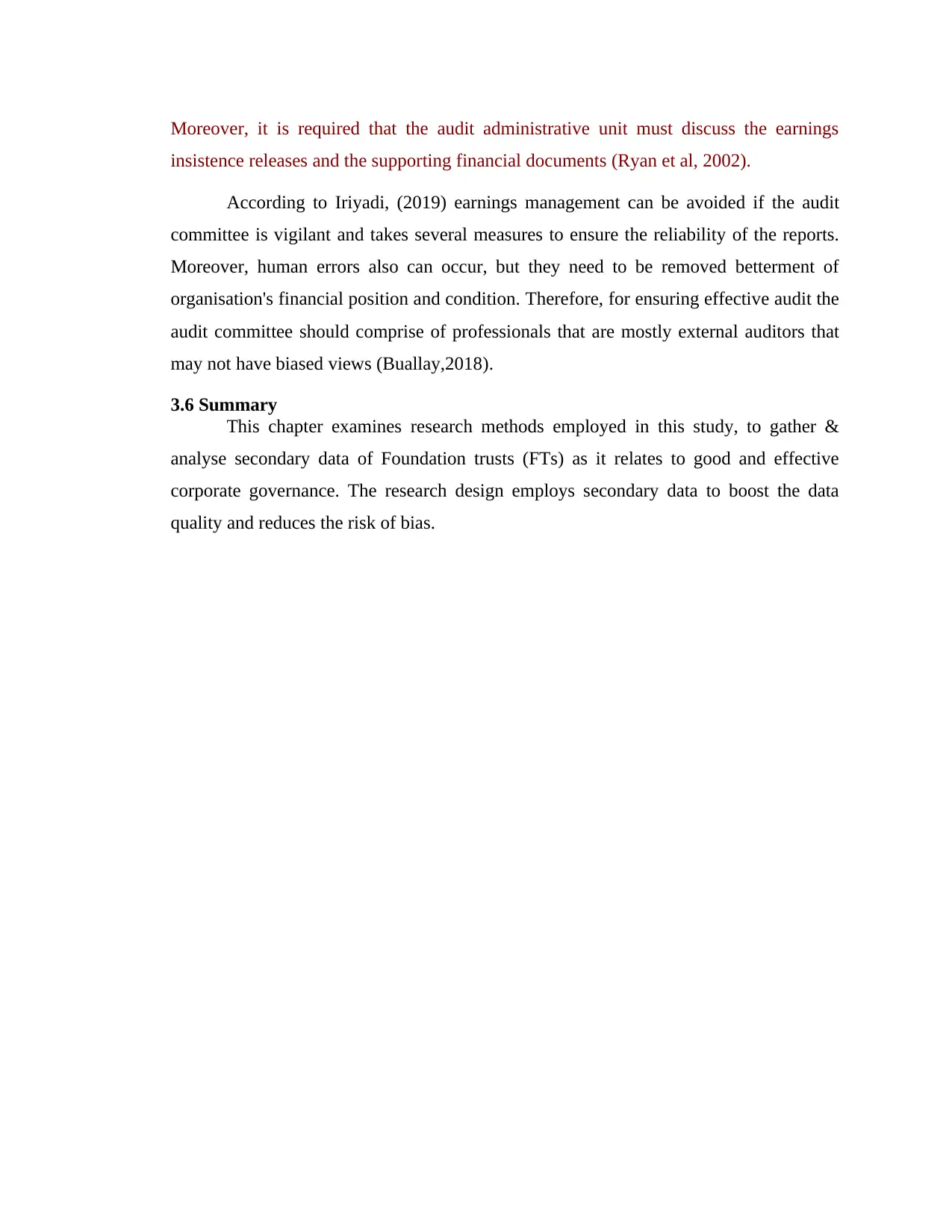
Moreover, it is required that the audit administrative unit must discuss the earnings
insistence releases and the supporting financial documents (Ryan et al, 2002).
According to Iriyadi, (2019) earnings management can be avoided if the audit
committee is vigilant and takes several measures to ensure the reliability of the reports.
Moreover, human errors also can occur, but they need to be removed betterment of
organisation's financial position and condition. Therefore, for ensuring effective audit the
audit committee should comprise of professionals that are mostly external auditors that
may not have biased views (Buallay,2018).
3.6 Summary
This chapter examines research methods employed in this study, to gather &
analyse secondary data of Foundation trusts (FTs) as it relates to good and effective
corporate governance. The research design employs secondary data to boost the data
quality and reduces the risk of bias.
insistence releases and the supporting financial documents (Ryan et al, 2002).
According to Iriyadi, (2019) earnings management can be avoided if the audit
committee is vigilant and takes several measures to ensure the reliability of the reports.
Moreover, human errors also can occur, but they need to be removed betterment of
organisation's financial position and condition. Therefore, for ensuring effective audit the
audit committee should comprise of professionals that are mostly external auditors that
may not have biased views (Buallay,2018).
3.6 Summary
This chapter examines research methods employed in this study, to gather &
analyse secondary data of Foundation trusts (FTs) as it relates to good and effective
corporate governance. The research design employs secondary data to boost the data
quality and reduces the risk of bias.

CHAPTER FOUR
PRESENTATION AND ANALYSIS OF DATA
4.1 UK Audit Committee and Foundation Trusts Financial Performance
4.1.1 Income and Expenditure
The effects of good and effective corporate governance in Foundation Trusts
financial performance by the UK audit committee cannot be overemphasized. Data on
the financial performance of Foundation Trusts (FTs) by the Monitor (2020) clearly
revealed that the first three months of the 2019/2020 financial year of the Foundation
Trusts was £445m net deficit. Although, the 2019/2020 financial year recorded a £354m
deficit but £90m worsened than that planned and larger than full year. In 2020, operating
revenue was near same as designed but the extra pay costs was £59m and non- pay costs
stood at £8m above plan. This caused a reduction of EBITDA. The ‘other non-operating
items’ was another huge variance that led to the overall deficit and this was due to
different planned donations & a single property worth £12.7m at South Tyneside NHSFT
being postponed.
Table 4.1a: Foundation Trusts Income and Expenditure Analysis
Q1 2019/2020 Variance to plan Q1 2018/2019
3 months ended 30 June
2019
Actual £m Plan £m £ % Actual £m
Operating Revenue for
EBITDA
11,246.0 11,247.0 (1.0) 0.0% 10,468
Pay Costs (7,411.0) (7,352.0) (59.0) 0.8% (6,776.0)
Other operating expenses (3,729.0) (3,720.0) (8.0) 0.2% (3,34.0)
EBITGA 106.0 174.0 (68.0) -39.1% 353.0
Depreciation (325.0) (331.0) 6.0 -1.7% (305.0)
Finance Cost (94.0) (96.0) 2.0 -1.8% 90.0
PDC Dividends (142.0) (144.0) 1.0 -0.9% (128.0)
Other non-Operating Items 19.0 57.0 (38.0) -66.1% 9.0
Restructuring Costs (9.0) (15.0) (7.0) -43.3% (6.0)
Net Surplus/(deficits) (445.0) (354.0) (90) 25.5% (167.0)
Gains/(losses) on transfers 0.0 0.0 0.0 0.0% 0.0
Impairments/Reversals (5.0) (8.0) 3.0 -36.5% (2.0)
Net surplus/(deficit) after
impairments & transfers
(450.0). (363.0) (87.0) 24.1% (170.0)
PRESENTATION AND ANALYSIS OF DATA
4.1 UK Audit Committee and Foundation Trusts Financial Performance
4.1.1 Income and Expenditure
The effects of good and effective corporate governance in Foundation Trusts
financial performance by the UK audit committee cannot be overemphasized. Data on
the financial performance of Foundation Trusts (FTs) by the Monitor (2020) clearly
revealed that the first three months of the 2019/2020 financial year of the Foundation
Trusts was £445m net deficit. Although, the 2019/2020 financial year recorded a £354m
deficit but £90m worsened than that planned and larger than full year. In 2020, operating
revenue was near same as designed but the extra pay costs was £59m and non- pay costs
stood at £8m above plan. This caused a reduction of EBITDA. The ‘other non-operating
items’ was another huge variance that led to the overall deficit and this was due to
different planned donations & a single property worth £12.7m at South Tyneside NHSFT
being postponed.
Table 4.1a: Foundation Trusts Income and Expenditure Analysis
Q1 2019/2020 Variance to plan Q1 2018/2019
3 months ended 30 June
2019
Actual £m Plan £m £ % Actual £m
Operating Revenue for
EBITDA
11,246.0 11,247.0 (1.0) 0.0% 10,468
Pay Costs (7,411.0) (7,352.0) (59.0) 0.8% (6,776.0)
Other operating expenses (3,729.0) (3,720.0) (8.0) 0.2% (3,34.0)
EBITGA 106.0 174.0 (68.0) -39.1% 353.0
Depreciation (325.0) (331.0) 6.0 -1.7% (305.0)
Finance Cost (94.0) (96.0) 2.0 -1.8% 90.0
PDC Dividends (142.0) (144.0) 1.0 -0.9% (128.0)
Other non-Operating Items 19.0 57.0 (38.0) -66.1% 9.0
Restructuring Costs (9.0) (15.0) (7.0) -43.3% (6.0)
Net Surplus/(deficits) (445.0) (354.0) (90) 25.5% (167.0)
Gains/(losses) on transfers 0.0 0.0 0.0 0.0% 0.0
Impairments/Reversals (5.0) (8.0) 3.0 -36.5% (2.0)
Net surplus/(deficit) after
impairments & transfers
(450.0). (363.0) (87.0) 24.1% (170.0)
Paraphrase This Document
Need a fresh take? Get an instant paraphrase of this document with our AI Paraphraser
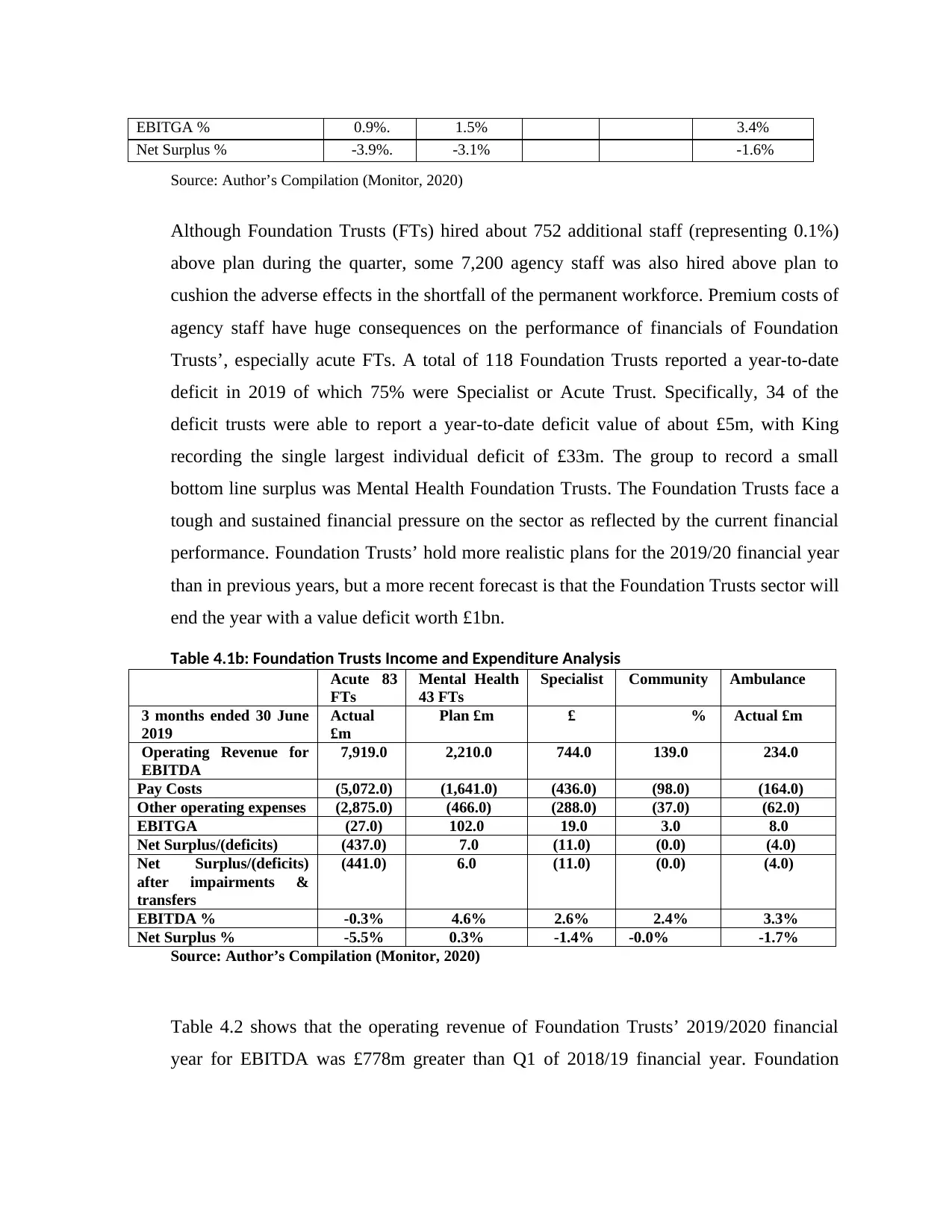
EBITGA % 0.9%. 1.5% 3.4%
Net Surplus % -3.9%. -3.1% -1.6%
Source: Author’s Compilation (Monitor, 2020)
Although Foundation Trusts (FTs) hired about 752 additional staff (representing 0.1%)
above plan during the quarter, some 7,200 agency staff was also hired above plan to
cushion the adverse effects in the shortfall of the permanent workforce. Premium costs of
agency staff have huge consequences on the performance of financials of Foundation
Trusts’, especially acute FTs. A total of 118 Foundation Trusts reported a year-to-date
deficit in 2019 of which 75% were Specialist or Acute Trust. Specifically, 34 of the
deficit trusts were able to report a year-to-date deficit value of about £5m, with King
recording the single largest individual deficit of £33m. The group to record a small
bottom line surplus was Mental Health Foundation Trusts. The Foundation Trusts face a
tough and sustained financial pressure on the sector as reflected by the current financial
performance. Foundation Trusts’ hold more realistic plans for the 2019/20 financial year
than in previous years, but a more recent forecast is that the Foundation Trusts sector will
end the year with a value deficit worth £1bn.
Table 4.1b: Foundation Trusts Income and Expenditure Analysis
Acute 83
FTs
Mental Health
43 FTs
Specialist Community Ambulance
3 months ended 30 June
2019
Actual
£m
Plan £m £ % Actual £m
Operating Revenue for
EBITDA
7,919.0 2,210.0 744.0 139.0 234.0
Pay Costs (5,072.0) (1,641.0) (436.0) (98.0) (164.0)
Other operating expenses (2,875.0) (466.0) (288.0) (37.0) (62.0)
EBITGA (27.0) 102.0 19.0 3.0 8.0
Net Surplus/(deficits) (437.0) 7.0 (11.0) (0.0) (4.0)
Net Surplus/(deficits)
after impairments &
transfers
(441.0) 6.0 (11.0) (0.0) (4.0)
EBITDA % -0.3% 4.6% 2.6% 2.4% 3.3%
Net Surplus % -5.5% 0.3% -1.4% -0.0% -1.7%
Source: Author’s Compilation (Monitor, 2020)
Table 4.2 shows that the operating revenue of Foundation Trusts’ 2019/2020 financial
year for EBITDA was £778m greater than Q1 of 2018/19 financial year. Foundation
Net Surplus % -3.9%. -3.1% -1.6%
Source: Author’s Compilation (Monitor, 2020)
Although Foundation Trusts (FTs) hired about 752 additional staff (representing 0.1%)
above plan during the quarter, some 7,200 agency staff was also hired above plan to
cushion the adverse effects in the shortfall of the permanent workforce. Premium costs of
agency staff have huge consequences on the performance of financials of Foundation
Trusts’, especially acute FTs. A total of 118 Foundation Trusts reported a year-to-date
deficit in 2019 of which 75% were Specialist or Acute Trust. Specifically, 34 of the
deficit trusts were able to report a year-to-date deficit value of about £5m, with King
recording the single largest individual deficit of £33m. The group to record a small
bottom line surplus was Mental Health Foundation Trusts. The Foundation Trusts face a
tough and sustained financial pressure on the sector as reflected by the current financial
performance. Foundation Trusts’ hold more realistic plans for the 2019/20 financial year
than in previous years, but a more recent forecast is that the Foundation Trusts sector will
end the year with a value deficit worth £1bn.
Table 4.1b: Foundation Trusts Income and Expenditure Analysis
Acute 83
FTs
Mental Health
43 FTs
Specialist Community Ambulance
3 months ended 30 June
2019
Actual
£m
Plan £m £ % Actual £m
Operating Revenue for
EBITDA
7,919.0 2,210.0 744.0 139.0 234.0
Pay Costs (5,072.0) (1,641.0) (436.0) (98.0) (164.0)
Other operating expenses (2,875.0) (466.0) (288.0) (37.0) (62.0)
EBITGA (27.0) 102.0 19.0 3.0 8.0
Net Surplus/(deficits) (437.0) 7.0 (11.0) (0.0) (4.0)
Net Surplus/(deficits)
after impairments &
transfers
(441.0) 6.0 (11.0) (0.0) (4.0)
EBITDA % -0.3% 4.6% 2.6% 2.4% 3.3%
Net Surplus % -5.5% 0.3% -1.4% -0.0% -1.7%
Source: Author’s Compilation (Monitor, 2020)
Table 4.2 shows that the operating revenue of Foundation Trusts’ 2019/2020 financial
year for EBITDA was £778m greater than Q1 of 2018/19 financial year. Foundation
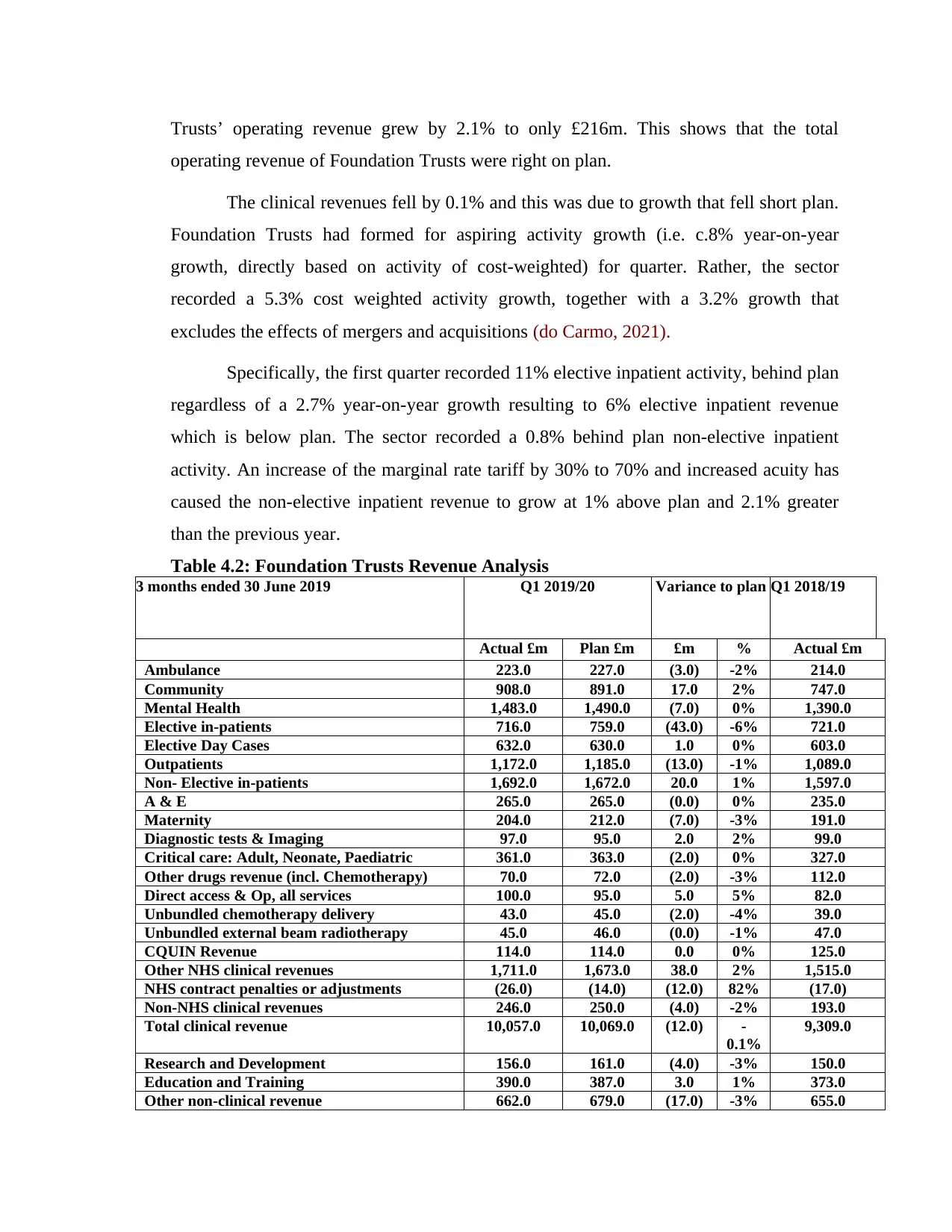
Trusts’ operating revenue grew by 2.1% to only £216m. This shows that the total
operating revenue of Foundation Trusts were right on plan.
The clinical revenues fell by 0.1% and this was due to growth that fell short plan.
Foundation Trusts had formed for aspiring activity growth (i.e. c.8% year-on-year
growth, directly based on activity of cost-weighted) for quarter. Rather, the sector
recorded a 5.3% cost weighted activity growth, together with a 3.2% growth that
excludes the effects of mergers and acquisitions (do Carmo, 2021).
Specifically, the first quarter recorded 11% elective inpatient activity, behind plan
regardless of a 2.7% year-on-year growth resulting to 6% elective inpatient revenue
which is below plan. The sector recorded a 0.8% behind plan non-elective inpatient
activity. An increase of the marginal rate tariff by 30% to 70% and increased acuity has
caused the non-elective inpatient revenue to grow at 1% above plan and 2.1% greater
than the previous year.
Table 4.2: Foundation Trusts Revenue Analysis
3 months ended 30 June 2019 Q1 2019/20 Variance to plan Q1 2018/19
Actual £m Plan £m £m % Actual £m
Ambulance 223.0 227.0 (3.0) -2% 214.0
Community 908.0 891.0 17.0 2% 747.0
Mental Health 1,483.0 1,490.0 (7.0) 0% 1,390.0
Elective in-patients 716.0 759.0 (43.0) -6% 721.0
Elective Day Cases 632.0 630.0 1.0 0% 603.0
Outpatients 1,172.0 1,185.0 (13.0) -1% 1,089.0
Non- Elective in-patients 1,692.0 1,672.0 20.0 1% 1,597.0
A & E 265.0 265.0 (0.0) 0% 235.0
Maternity 204.0 212.0 (7.0) -3% 191.0
Diagnostic tests & Imaging 97.0 95.0 2.0 2% 99.0
Critical care: Adult, Neonate, Paediatric 361.0 363.0 (2.0) 0% 327.0
Other drugs revenue (incl. Chemotherapy) 70.0 72.0 (2.0) -3% 112.0
Direct access & Op, all services 100.0 95.0 5.0 5% 82.0
Unbundled chemotherapy delivery 43.0 45.0 (2.0) -4% 39.0
Unbundled external beam radiotherapy 45.0 46.0 (0.0) -1% 47.0
CQUIN Revenue 114.0 114.0 0.0 0% 125.0
Other NHS clinical revenues 1,711.0 1,673.0 38.0 2% 1,515.0
NHS contract penalties or adjustments (26.0) (14.0) (12.0) 82% (17.0)
Non-NHS clinical revenues 246.0 250.0 (4.0) -2% 193.0
Total clinical revenue 10,057.0 10,069.0 (12.0) -
0.1%
9,309.0
Research and Development 156.0 161.0 (4.0) -3% 150.0
Education and Training 390.0 387.0 3.0 1% 373.0
Other non-clinical revenue 662.0 679.0 (17.0) -3% 655.0
operating revenue of Foundation Trusts were right on plan.
The clinical revenues fell by 0.1% and this was due to growth that fell short plan.
Foundation Trusts had formed for aspiring activity growth (i.e. c.8% year-on-year
growth, directly based on activity of cost-weighted) for quarter. Rather, the sector
recorded a 5.3% cost weighted activity growth, together with a 3.2% growth that
excludes the effects of mergers and acquisitions (do Carmo, 2021).
Specifically, the first quarter recorded 11% elective inpatient activity, behind plan
regardless of a 2.7% year-on-year growth resulting to 6% elective inpatient revenue
which is below plan. The sector recorded a 0.8% behind plan non-elective inpatient
activity. An increase of the marginal rate tariff by 30% to 70% and increased acuity has
caused the non-elective inpatient revenue to grow at 1% above plan and 2.1% greater
than the previous year.
Table 4.2: Foundation Trusts Revenue Analysis
3 months ended 30 June 2019 Q1 2019/20 Variance to plan Q1 2018/19
Actual £m Plan £m £m % Actual £m
Ambulance 223.0 227.0 (3.0) -2% 214.0
Community 908.0 891.0 17.0 2% 747.0
Mental Health 1,483.0 1,490.0 (7.0) 0% 1,390.0
Elective in-patients 716.0 759.0 (43.0) -6% 721.0
Elective Day Cases 632.0 630.0 1.0 0% 603.0
Outpatients 1,172.0 1,185.0 (13.0) -1% 1,089.0
Non- Elective in-patients 1,692.0 1,672.0 20.0 1% 1,597.0
A & E 265.0 265.0 (0.0) 0% 235.0
Maternity 204.0 212.0 (7.0) -3% 191.0
Diagnostic tests & Imaging 97.0 95.0 2.0 2% 99.0
Critical care: Adult, Neonate, Paediatric 361.0 363.0 (2.0) 0% 327.0
Other drugs revenue (incl. Chemotherapy) 70.0 72.0 (2.0) -3% 112.0
Direct access & Op, all services 100.0 95.0 5.0 5% 82.0
Unbundled chemotherapy delivery 43.0 45.0 (2.0) -4% 39.0
Unbundled external beam radiotherapy 45.0 46.0 (0.0) -1% 47.0
CQUIN Revenue 114.0 114.0 0.0 0% 125.0
Other NHS clinical revenues 1,711.0 1,673.0 38.0 2% 1,515.0
NHS contract penalties or adjustments (26.0) (14.0) (12.0) 82% (17.0)
Non-NHS clinical revenues 246.0 250.0 (4.0) -2% 193.0
Total clinical revenue 10,057.0 10,069.0 (12.0) -
0.1%
9,309.0
Research and Development 156.0 161.0 (4.0) -3% 150.0
Education and Training 390.0 387.0 3.0 1% 373.0
Other non-clinical revenue 662.0 679.0 (17.0) -3% 655.0
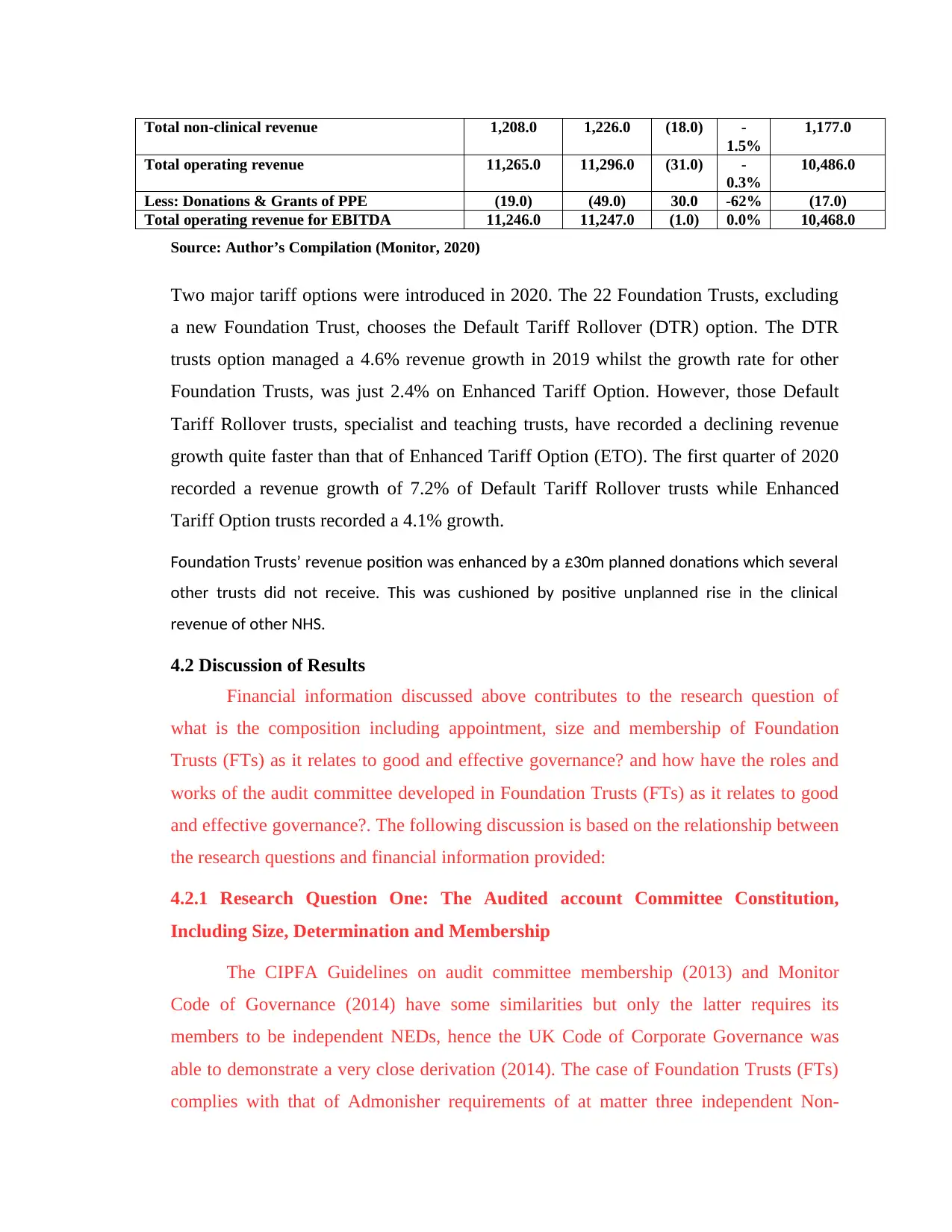
Total non-clinical revenue 1,208.0 1,226.0 (18.0) -
1.5%
1,177.0
Total operating revenue 11,265.0 11,296.0 (31.0) -
0.3%
10,486.0
Less: Donations & Grants of PPE (19.0) (49.0) 30.0 -62% (17.0)
Total operating revenue for EBITDA 11,246.0 11,247.0 (1.0) 0.0% 10,468.0
Source: Author’s Compilation (Monitor, 2020)
Two major tariff options were introduced in 2020. The 22 Foundation Trusts, excluding
a new Foundation Trust, chooses the Default Tariff Rollover (DTR) option. The DTR
trusts option managed a 4.6% revenue growth in 2019 whilst the growth rate for other
Foundation Trusts, was just 2.4% on Enhanced Tariff Option. However, those Default
Tariff Rollover trusts, specialist and teaching trusts, have recorded a declining revenue
growth quite faster than that of Enhanced Tariff Option (ETO). The first quarter of 2020
recorded a revenue growth of 7.2% of Default Tariff Rollover trusts while Enhanced
Tariff Option trusts recorded a 4.1% growth.
Foundation Trusts’ revenue position was enhanced by a £30m planned donations which several
other trusts did not receive. This was cushioned by positive unplanned rise in the clinical
revenue of other NHS.
4.2 Discussion of Results
Financial information discussed above contributes to the research question of
what is the composition including appointment, size and membership of Foundation
Trusts (FTs) as it relates to good and effective governance? and how have the roles and
works of the audit committee developed in Foundation Trusts (FTs) as it relates to good
and effective governance?. The following discussion is based on the relationship between
the research questions and financial information provided:
4.2.1 Research Question One: The Audited account Committee Constitution,
Including Size, Determination and Membership
The CIPFA Guidelines on audit committee membership (2013) and Monitor
Code of Governance (2014) have some similarities but only the latter requires its
members to be independent NEDs, hence the UK Code of Corporate Governance was
able to demonstrate a very close derivation (2014). The case of Foundation Trusts (FTs)
complies with that of Admonisher requirements of at matter three independent Non-
1.5%
1,177.0
Total operating revenue 11,265.0 11,296.0 (31.0) -
0.3%
10,486.0
Less: Donations & Grants of PPE (19.0) (49.0) 30.0 -62% (17.0)
Total operating revenue for EBITDA 11,246.0 11,247.0 (1.0) 0.0% 10,468.0
Source: Author’s Compilation (Monitor, 2020)
Two major tariff options were introduced in 2020. The 22 Foundation Trusts, excluding
a new Foundation Trust, chooses the Default Tariff Rollover (DTR) option. The DTR
trusts option managed a 4.6% revenue growth in 2019 whilst the growth rate for other
Foundation Trusts, was just 2.4% on Enhanced Tariff Option. However, those Default
Tariff Rollover trusts, specialist and teaching trusts, have recorded a declining revenue
growth quite faster than that of Enhanced Tariff Option (ETO). The first quarter of 2020
recorded a revenue growth of 7.2% of Default Tariff Rollover trusts while Enhanced
Tariff Option trusts recorded a 4.1% growth.
Foundation Trusts’ revenue position was enhanced by a £30m planned donations which several
other trusts did not receive. This was cushioned by positive unplanned rise in the clinical
revenue of other NHS.
4.2 Discussion of Results
Financial information discussed above contributes to the research question of
what is the composition including appointment, size and membership of Foundation
Trusts (FTs) as it relates to good and effective governance? and how have the roles and
works of the audit committee developed in Foundation Trusts (FTs) as it relates to good
and effective governance?. The following discussion is based on the relationship between
the research questions and financial information provided:
4.2.1 Research Question One: The Audited account Committee Constitution,
Including Size, Determination and Membership
The CIPFA Guidelines on audit committee membership (2013) and Monitor
Code of Governance (2014) have some similarities but only the latter requires its
members to be independent NEDs, hence the UK Code of Corporate Governance was
able to demonstrate a very close derivation (2014). The case of Foundation Trusts (FTs)
complies with that of Admonisher requirements of at matter three independent Non-
Secure Best Marks with AI Grader
Need help grading? Try our AI Grader for instant feedback on your assignments.
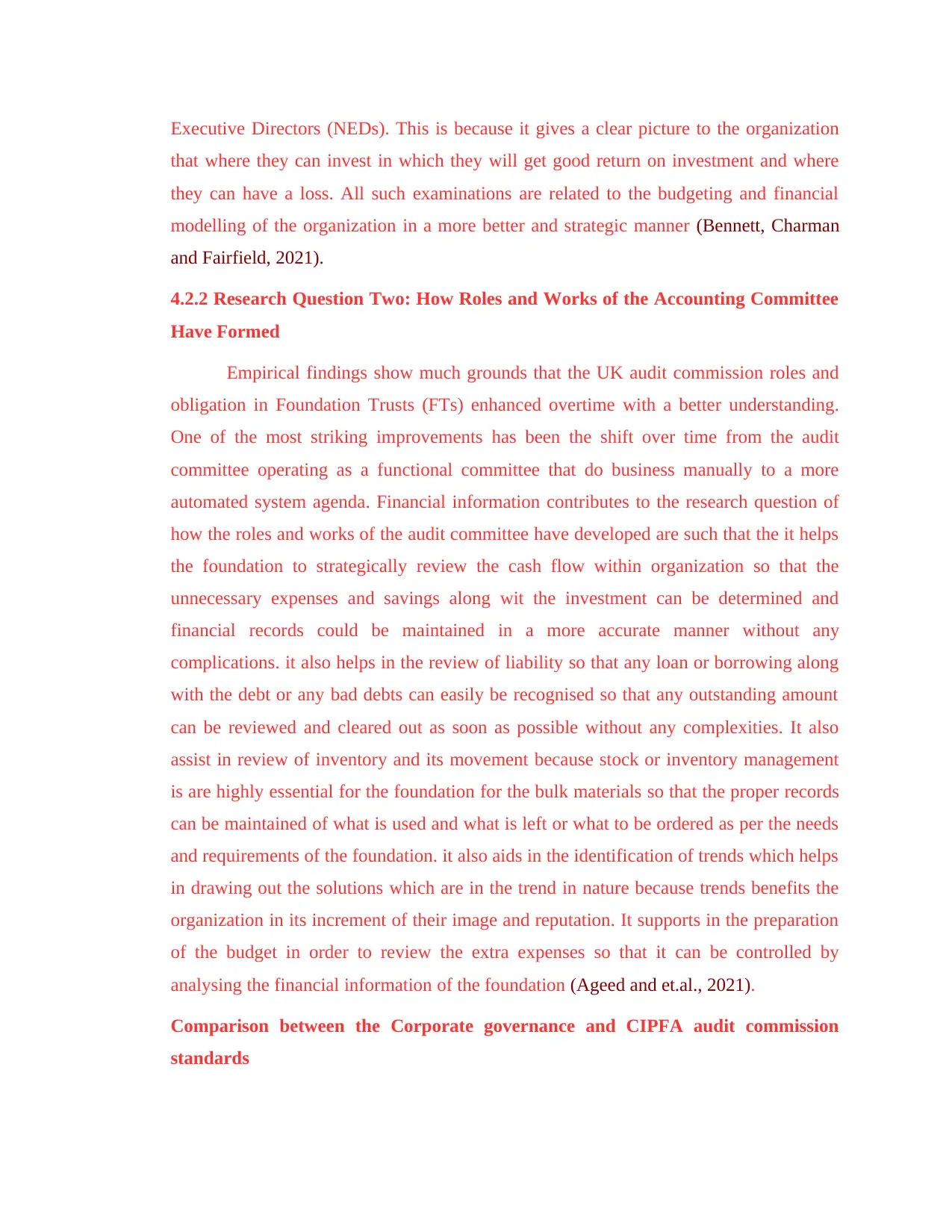
Executive Directors (NEDs). This is because it gives a clear picture to the organization
that where they can invest in which they will get good return on investment and where
they can have a loss. All such examinations are related to the budgeting and financial
modelling of the organization in a more better and strategic manner (Bennett, Charman
and Fairfield, 2021).
4.2.2 Research Question Two: How Roles and Works of the Accounting Committee
Have Formed
Empirical findings show much grounds that the UK audit commission roles and
obligation in Foundation Trusts (FTs) enhanced overtime with a better understanding.
One of the most striking improvements has been the shift over time from the audit
committee operating as a functional committee that do business manually to a more
automated system agenda. Financial information contributes to the research question of
how the roles and works of the audit committee have developed are such that the it helps
the foundation to strategically review the cash flow within organization so that the
unnecessary expenses and savings along wit the investment can be determined and
financial records could be maintained in a more accurate manner without any
complications. it also helps in the review of liability so that any loan or borrowing along
with the debt or any bad debts can easily be recognised so that any outstanding amount
can be reviewed and cleared out as soon as possible without any complexities. It also
assist in review of inventory and its movement because stock or inventory management
is are highly essential for the foundation for the bulk materials so that the proper records
can be maintained of what is used and what is left or what to be ordered as per the needs
and requirements of the foundation. it also aids in the identification of trends which helps
in drawing out the solutions which are in the trend in nature because trends benefits the
organization in its increment of their image and reputation. It supports in the preparation
of the budget in order to review the extra expenses so that it can be controlled by
analysing the financial information of the foundation (Ageed and et.al., 2021).
Comparison between the Corporate governance and CIPFA audit commission
standards
that where they can invest in which they will get good return on investment and where
they can have a loss. All such examinations are related to the budgeting and financial
modelling of the organization in a more better and strategic manner (Bennett, Charman
and Fairfield, 2021).
4.2.2 Research Question Two: How Roles and Works of the Accounting Committee
Have Formed
Empirical findings show much grounds that the UK audit commission roles and
obligation in Foundation Trusts (FTs) enhanced overtime with a better understanding.
One of the most striking improvements has been the shift over time from the audit
committee operating as a functional committee that do business manually to a more
automated system agenda. Financial information contributes to the research question of
how the roles and works of the audit committee have developed are such that the it helps
the foundation to strategically review the cash flow within organization so that the
unnecessary expenses and savings along wit the investment can be determined and
financial records could be maintained in a more accurate manner without any
complications. it also helps in the review of liability so that any loan or borrowing along
with the debt or any bad debts can easily be recognised so that any outstanding amount
can be reviewed and cleared out as soon as possible without any complexities. It also
assist in review of inventory and its movement because stock or inventory management
is are highly essential for the foundation for the bulk materials so that the proper records
can be maintained of what is used and what is left or what to be ordered as per the needs
and requirements of the foundation. it also aids in the identification of trends which helps
in drawing out the solutions which are in the trend in nature because trends benefits the
organization in its increment of their image and reputation. It supports in the preparation
of the budget in order to review the extra expenses so that it can be controlled by
analysing the financial information of the foundation (Ageed and et.al., 2021).
Comparison between the Corporate governance and CIPFA audit commission
standards

The role of the audited account committee forms cornerstone for effectual
corporate organisation. Boards rely for the growth of their audit NGO to offer effective
direction of the annual scrutiny process. Members of audit administrative unit do their
best attribute work when the figure of the social unit are breakaway and objective.
4.3 Summary
In summary, much evidence exists on the better in the audit committee
arrangements and in the understanding in Foundation Trusts (FTs). Moreover, it is
summarised that UK Audit Committee and Foundation Trusts Financial Performance is
an important conception to learn and survey so that its cognition can be applied in the
existent world form and situations so therefore, it is an important and essential to analyse
and examine the UK Audit Committee and Foundation Trusts Financial Performance
which includes Income and Expenditure along with the Foundation Trusts Income and
Expenditure Analysis which is followed by the Foundation Trusts Income and
Expenditure Analysis and also the Foundation Trusts Revenue Analysis. It is necessary
and significant to determine and gain the knowledge about Discussion of Results which
includes the Research Question One that is The Audit Committee Composition,
Including Size, Appointment and Membership and Research Question Two that is How
the Roles and Works of the Audit Committee Have Developed. Hence, presentation and
analysis part screen all such country in order to amended understand the concept of UK
Audit Committee and Foundation Trusts Financial Performance.
corporate organisation. Boards rely for the growth of their audit NGO to offer effective
direction of the annual scrutiny process. Members of audit administrative unit do their
best attribute work when the figure of the social unit are breakaway and objective.
4.3 Summary
In summary, much evidence exists on the better in the audit committee
arrangements and in the understanding in Foundation Trusts (FTs). Moreover, it is
summarised that UK Audit Committee and Foundation Trusts Financial Performance is
an important conception to learn and survey so that its cognition can be applied in the
existent world form and situations so therefore, it is an important and essential to analyse
and examine the UK Audit Committee and Foundation Trusts Financial Performance
which includes Income and Expenditure along with the Foundation Trusts Income and
Expenditure Analysis which is followed by the Foundation Trusts Income and
Expenditure Analysis and also the Foundation Trusts Revenue Analysis. It is necessary
and significant to determine and gain the knowledge about Discussion of Results which
includes the Research Question One that is The Audit Committee Composition,
Including Size, Appointment and Membership and Research Question Two that is How
the Roles and Works of the Audit Committee Have Developed. Hence, presentation and
analysis part screen all such country in order to amended understand the concept of UK
Audit Committee and Foundation Trusts Financial Performance.
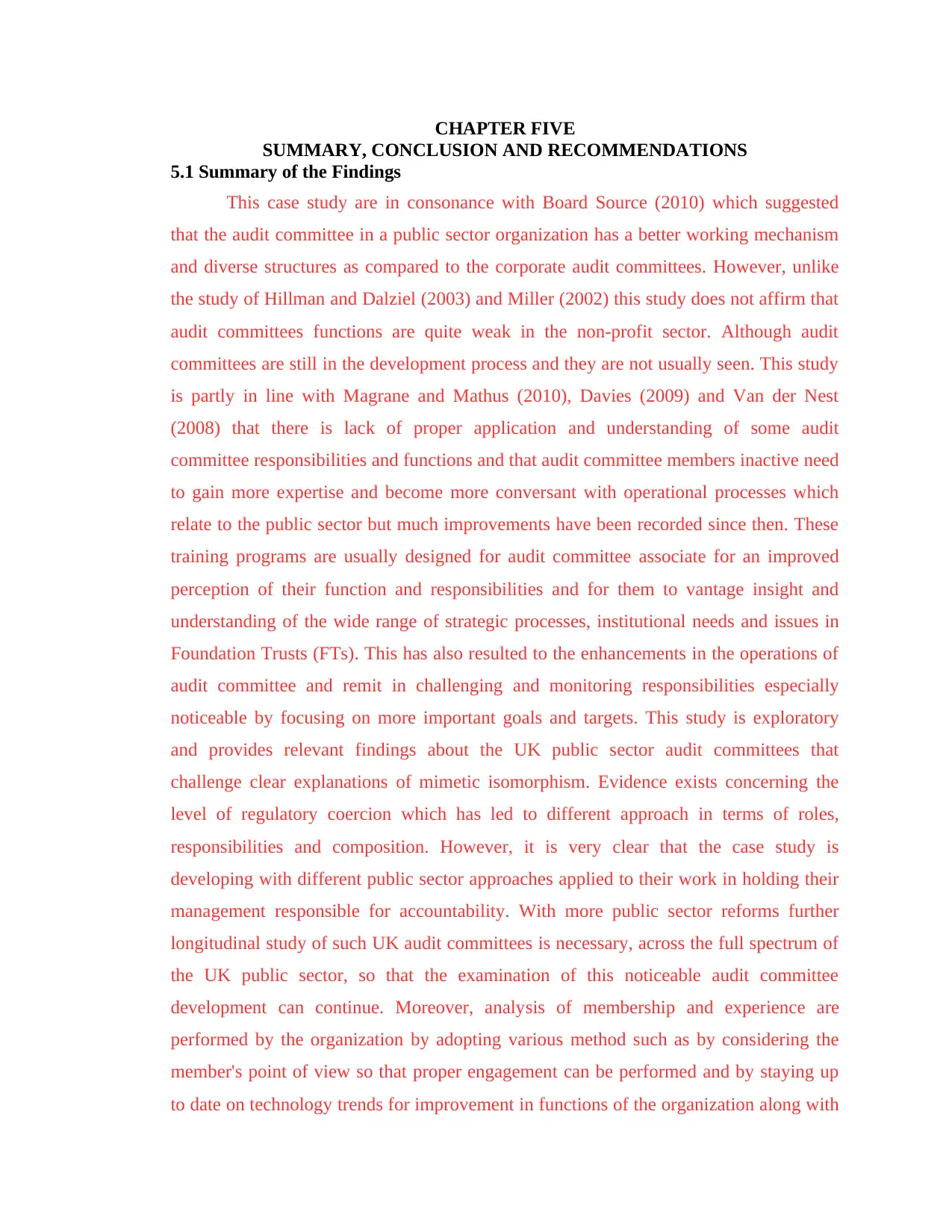
CHAPTER FIVE
SUMMARY, CONCLUSION AND RECOMMENDATIONS
5.1 Summary of the Findings
This case study are in consonance with Board Source (2010) which suggested
that the audit committee in a public sector organization has a better working mechanism
and diverse structures as compared to the corporate audit committees. However, unlike
the study of Hillman and Dalziel (2003) and Miller (2002) this study does not affirm that
audit committees functions are quite weak in the non-profit sector. Although audit
committees are still in the development process and they are not usually seen. This study
is partly in line with Magrane and Mathus (2010), Davies (2009) and Van der Nest
(2008) that there is lack of proper application and understanding of some audit
committee responsibilities and functions and that audit committee members inactive need
to gain more expertise and become more conversant with operational processes which
relate to the public sector but much improvements have been recorded since then. These
training programs are usually designed for audit committee associate for an improved
perception of their function and responsibilities and for them to vantage insight and
understanding of the wide range of strategic processes, institutional needs and issues in
Foundation Trusts (FTs). This has also resulted to the enhancements in the operations of
audit committee and remit in challenging and monitoring responsibilities especially
noticeable by focusing on more important goals and targets. This study is exploratory
and provides relevant findings about the UK public sector audit committees that
challenge clear explanations of mimetic isomorphism. Evidence exists concerning the
level of regulatory coercion which has led to different approach in terms of roles,
responsibilities and composition. However, it is very clear that the case study is
developing with different public sector approaches applied to their work in holding their
management responsible for accountability. With more public sector reforms further
longitudinal study of such UK audit committees is necessary, across the full spectrum of
the UK public sector, so that the examination of this noticeable audit committee
development can continue. Moreover, analysis of membership and experience are
performed by the organization by adopting various method such as by considering the
member's point of view so that proper engagement can be performed and by staying up
to date on technology trends for improvement in functions of the organization along with
SUMMARY, CONCLUSION AND RECOMMENDATIONS
5.1 Summary of the Findings
This case study are in consonance with Board Source (2010) which suggested
that the audit committee in a public sector organization has a better working mechanism
and diverse structures as compared to the corporate audit committees. However, unlike
the study of Hillman and Dalziel (2003) and Miller (2002) this study does not affirm that
audit committees functions are quite weak in the non-profit sector. Although audit
committees are still in the development process and they are not usually seen. This study
is partly in line with Magrane and Mathus (2010), Davies (2009) and Van der Nest
(2008) that there is lack of proper application and understanding of some audit
committee responsibilities and functions and that audit committee members inactive need
to gain more expertise and become more conversant with operational processes which
relate to the public sector but much improvements have been recorded since then. These
training programs are usually designed for audit committee associate for an improved
perception of their function and responsibilities and for them to vantage insight and
understanding of the wide range of strategic processes, institutional needs and issues in
Foundation Trusts (FTs). This has also resulted to the enhancements in the operations of
audit committee and remit in challenging and monitoring responsibilities especially
noticeable by focusing on more important goals and targets. This study is exploratory
and provides relevant findings about the UK public sector audit committees that
challenge clear explanations of mimetic isomorphism. Evidence exists concerning the
level of regulatory coercion which has led to different approach in terms of roles,
responsibilities and composition. However, it is very clear that the case study is
developing with different public sector approaches applied to their work in holding their
management responsible for accountability. With more public sector reforms further
longitudinal study of such UK audit committees is necessary, across the full spectrum of
the UK public sector, so that the examination of this noticeable audit committee
development can continue. Moreover, analysis of membership and experience are
performed by the organization by adopting various method such as by considering the
member's point of view so that proper engagement can be performed and by staying up
to date on technology trends for improvement in functions of the organization along with
Paraphrase This Document
Need a fresh take? Get an instant paraphrase of this document with our AI Paraphraser
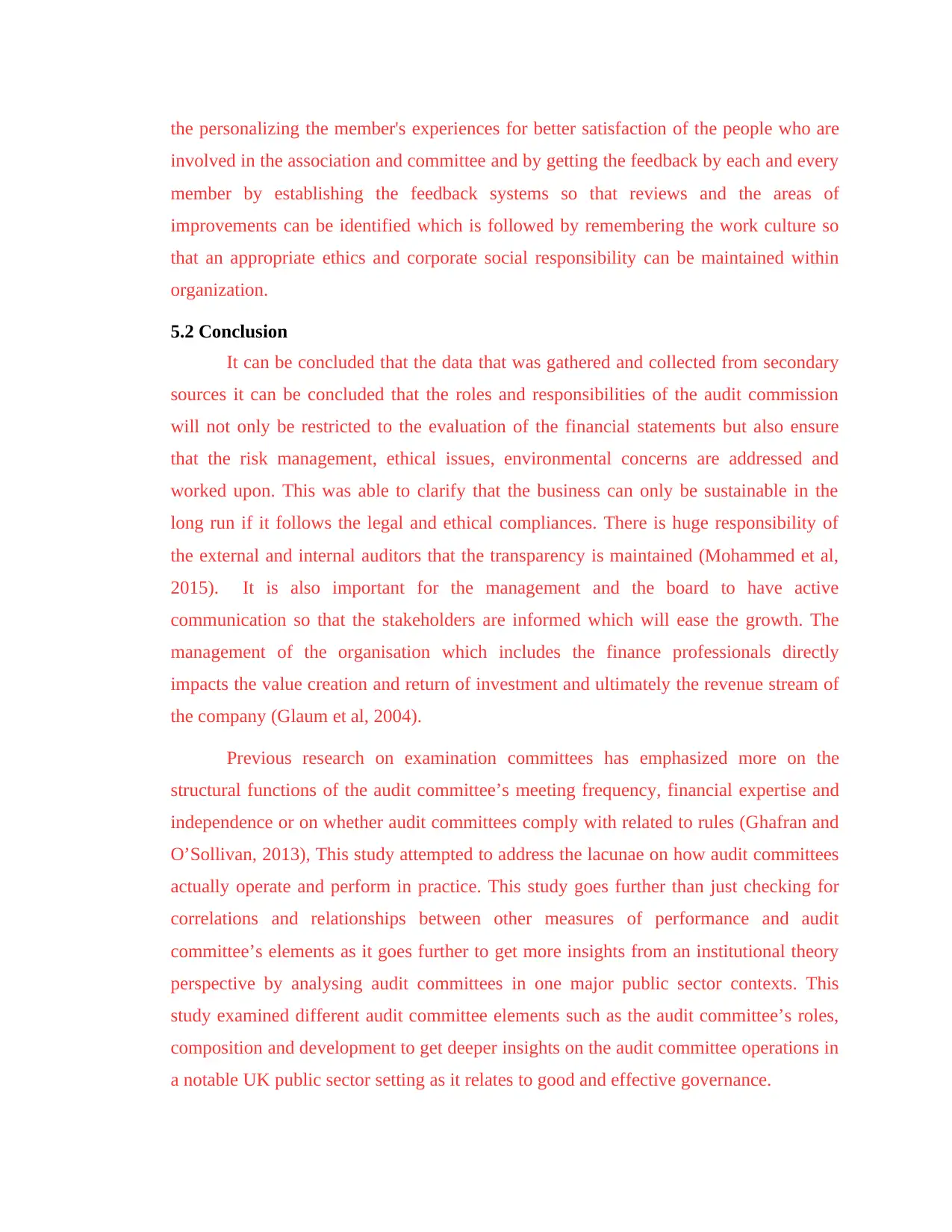
the personalizing the member's experiences for better satisfaction of the people who are
involved in the association and committee and by getting the feedback by each and every
member by establishing the feedback systems so that reviews and the areas of
improvements can be identified which is followed by remembering the work culture so
that an appropriate ethics and corporate social responsibility can be maintained within
organization.
5.2 Conclusion
It can be concluded that the data that was gathered and collected from secondary
sources it can be concluded that the roles and responsibilities of the audit commission
will not only be restricted to the evaluation of the financial statements but also ensure
that the risk management, ethical issues, environmental concerns are addressed and
worked upon. This was able to clarify that the business can only be sustainable in the
long run if it follows the legal and ethical compliances. There is huge responsibility of
the external and internal auditors that the transparency is maintained (Mohammed et al,
2015). It is also important for the management and the board to have active
communication so that the stakeholders are informed which will ease the growth. The
management of the organisation which includes the finance professionals directly
impacts the value creation and return of investment and ultimately the revenue stream of
the company (Glaum et al, 2004).
Previous research on examination committees has emphasized more on the
structural functions of the audit committee’s meeting frequency, financial expertise and
independence or on whether audit committees comply with related to rules (Ghafran and
O’Sollivan, 2013), This study attempted to address the lacunae on how audit committees
actually operate and perform in practice. This study goes further than just checking for
correlations and relationships between other measures of performance and audit
committee’s elements as it goes further to get more insights from an institutional theory
perspective by analysing audit committees in one major public sector contexts. This
study examined different audit committee elements such as the audit committee’s roles,
composition and development to get deeper insights on the audit committee operations in
a notable UK public sector setting as it relates to good and effective governance.
involved in the association and committee and by getting the feedback by each and every
member by establishing the feedback systems so that reviews and the areas of
improvements can be identified which is followed by remembering the work culture so
that an appropriate ethics and corporate social responsibility can be maintained within
organization.
5.2 Conclusion
It can be concluded that the data that was gathered and collected from secondary
sources it can be concluded that the roles and responsibilities of the audit commission
will not only be restricted to the evaluation of the financial statements but also ensure
that the risk management, ethical issues, environmental concerns are addressed and
worked upon. This was able to clarify that the business can only be sustainable in the
long run if it follows the legal and ethical compliances. There is huge responsibility of
the external and internal auditors that the transparency is maintained (Mohammed et al,
2015). It is also important for the management and the board to have active
communication so that the stakeholders are informed which will ease the growth. The
management of the organisation which includes the finance professionals directly
impacts the value creation and return of investment and ultimately the revenue stream of
the company (Glaum et al, 2004).
Previous research on examination committees has emphasized more on the
structural functions of the audit committee’s meeting frequency, financial expertise and
independence or on whether audit committees comply with related to rules (Ghafran and
O’Sollivan, 2013), This study attempted to address the lacunae on how audit committees
actually operate and perform in practice. This study goes further than just checking for
correlations and relationships between other measures of performance and audit
committee’s elements as it goes further to get more insights from an institutional theory
perspective by analysing audit committees in one major public sector contexts. This
study examined different audit committee elements such as the audit committee’s roles,
composition and development to get deeper insights on the audit committee operations in
a notable UK public sector setting as it relates to good and effective governance.
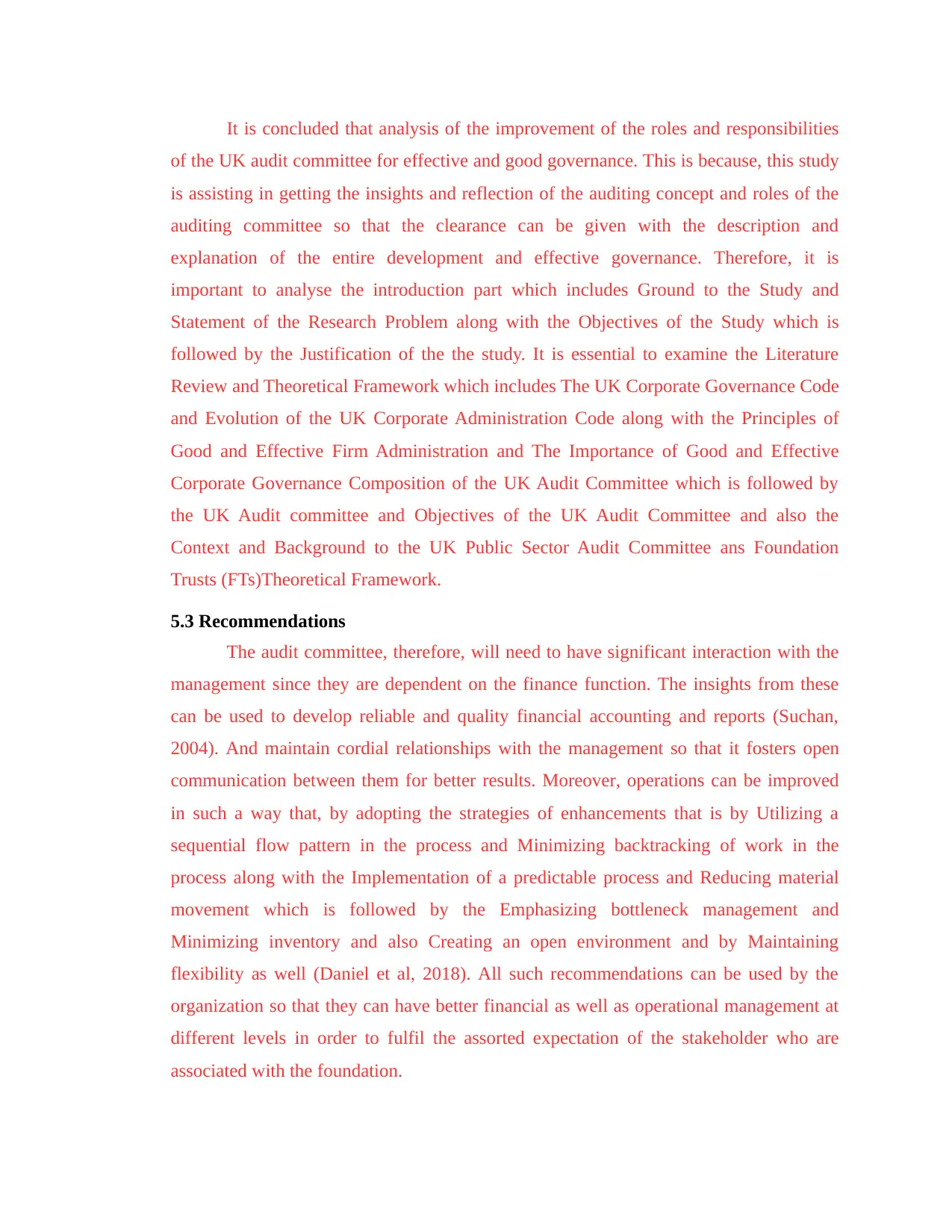
It is concluded that analysis of the improvement of the roles and responsibilities
of the UK audit committee for effective and good governance. This is because, this study
is assisting in getting the insights and reflection of the auditing concept and roles of the
auditing committee so that the clearance can be given with the description and
explanation of the entire development and effective governance. Therefore, it is
important to analyse the introduction part which includes Ground to the Study and
Statement of the Research Problem along with the Objectives of the Study which is
followed by the Justification of the the study. It is essential to examine the Literature
Review and Theoretical Framework which includes The UK Corporate Governance Code
and Evolution of the UK Corporate Administration Code along with the Principles of
Good and Effective Firm Administration and The Importance of Good and Effective
Corporate Governance Composition of the UK Audit Committee which is followed by
the UK Audit committee and Objectives of the UK Audit Committee and also the
Context and Background to the UK Public Sector Audit Committee ans Foundation
Trusts (FTs)Theoretical Framework.
5.3 Recommendations
The audit committee, therefore, will need to have significant interaction with the
management since they are dependent on the finance function. The insights from these
can be used to develop reliable and quality financial accounting and reports (Suchan,
2004). And maintain cordial relationships with the management so that it fosters open
communication between them for better results. Moreover, operations can be improved
in such a way that, by adopting the strategies of enhancements that is by Utilizing a
sequential flow pattern in the process and Minimizing backtracking of work in the
process along with the Implementation of a predictable process and Reducing material
movement which is followed by the Emphasizing bottleneck management and
Minimizing inventory and also Creating an open environment and by Maintaining
flexibility as well (Daniel et al, 2018). All such recommendations can be used by the
organization so that they can have better financial as well as operational management at
different levels in order to fulfil the assorted expectation of the stakeholder who are
associated with the foundation.
of the UK audit committee for effective and good governance. This is because, this study
is assisting in getting the insights and reflection of the auditing concept and roles of the
auditing committee so that the clearance can be given with the description and
explanation of the entire development and effective governance. Therefore, it is
important to analyse the introduction part which includes Ground to the Study and
Statement of the Research Problem along with the Objectives of the Study which is
followed by the Justification of the the study. It is essential to examine the Literature
Review and Theoretical Framework which includes The UK Corporate Governance Code
and Evolution of the UK Corporate Administration Code along with the Principles of
Good and Effective Firm Administration and The Importance of Good and Effective
Corporate Governance Composition of the UK Audit Committee which is followed by
the UK Audit committee and Objectives of the UK Audit Committee and also the
Context and Background to the UK Public Sector Audit Committee ans Foundation
Trusts (FTs)Theoretical Framework.
5.3 Recommendations
The audit committee, therefore, will need to have significant interaction with the
management since they are dependent on the finance function. The insights from these
can be used to develop reliable and quality financial accounting and reports (Suchan,
2004). And maintain cordial relationships with the management so that it fosters open
communication between them for better results. Moreover, operations can be improved
in such a way that, by adopting the strategies of enhancements that is by Utilizing a
sequential flow pattern in the process and Minimizing backtracking of work in the
process along with the Implementation of a predictable process and Reducing material
movement which is followed by the Emphasizing bottleneck management and
Minimizing inventory and also Creating an open environment and by Maintaining
flexibility as well (Daniel et al, 2018). All such recommendations can be used by the
organization so that they can have better financial as well as operational management at
different levels in order to fulfil the assorted expectation of the stakeholder who are
associated with the foundation.
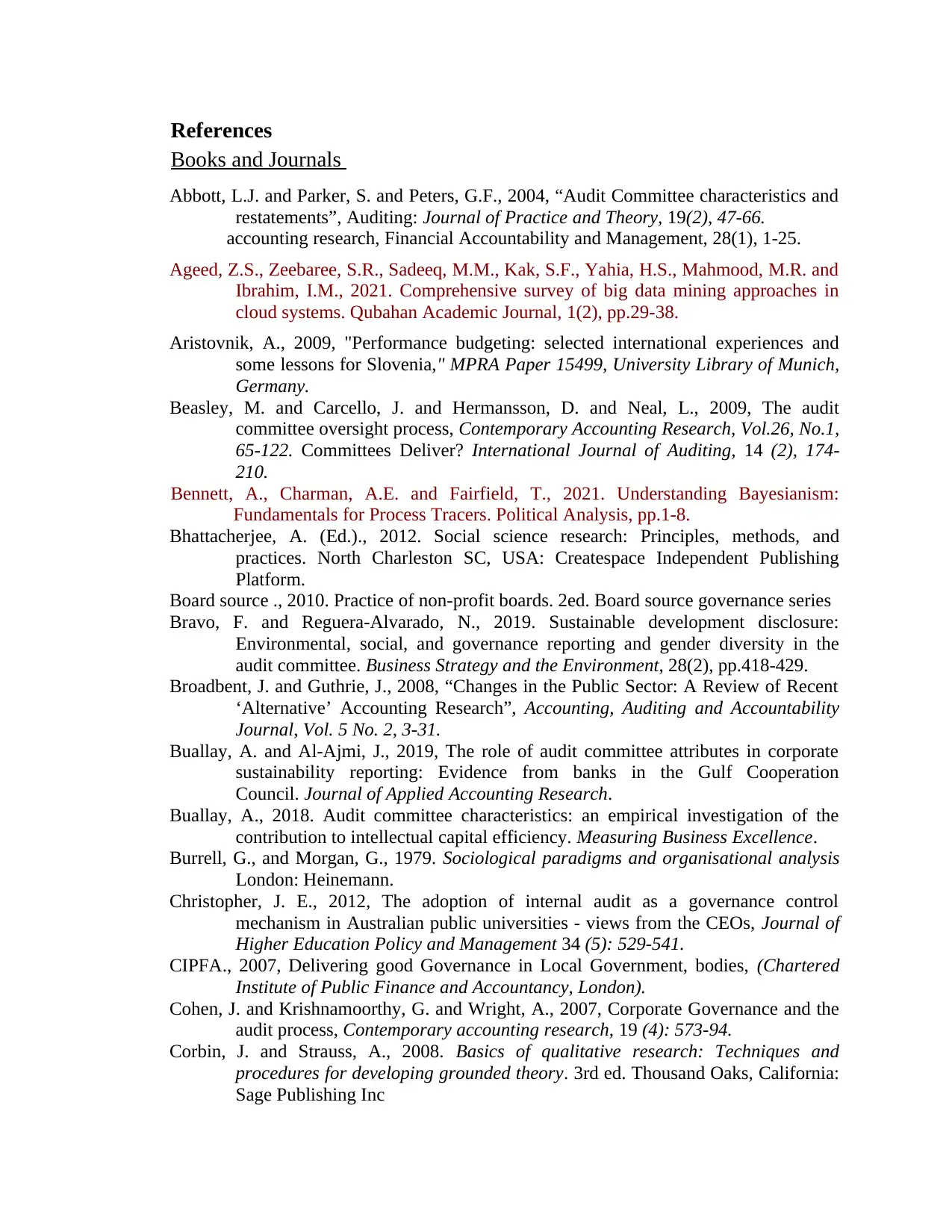
References
Books and Journals
Abbott, L.J. and Parker, S. and Peters, G.F., 2004, “Audit Committee characteristics and
restatements”, Auditing: Journal of Practice and Theory, 19(2), 47-66.
accounting research, Financial Accountability and Management, 28(1), 1-25.
Ageed, Z.S., Zeebaree, S.R., Sadeeq, M.M., Kak, S.F., Yahia, H.S., Mahmood, M.R. and
Ibrahim, I.M., 2021. Comprehensive survey of big data mining approaches in
cloud systems. Qubahan Academic Journal, 1(2), pp.29-38.
Aristovnik, A., 2009, "Performance budgeting: selected international experiences and
some lessons for Slovenia," MPRA Paper 15499, University Library of Munich,
Germany.
Beasley, M. and Carcello, J. and Hermansson, D. and Neal, L., 2009, The audit
committee oversight process, Contemporary Accounting Research, Vol.26, No.1,
65-122. Committees Deliver? International Journal of Auditing, 14 (2), 174-
210.
Bennett, A., Charman, A.E. and Fairfield, T., 2021. Understanding Bayesianism:
Fundamentals for Process Tracers. Political Analysis, pp.1-8.
Bhattacherjee, A. (Ed.)., 2012. Social science research: Principles, methods, and
practices. North Charleston SC, USA: Createspace Independent Publishing
Platform.
Board source ., 2010. Practice of non-profit boards. 2ed. Board source governance series
Bravo, F. and Reguera‐Alvarado, N., 2019. Sustainable development disclosure:
Environmental, social, and governance reporting and gender diversity in the
audit committee. Business Strategy and the Environment, 28(2), pp.418-429.
Broadbent, J. and Guthrie, J., 2008, “Changes in the Public Sector: A Review of Recent
‘Alternative’ Accounting Research”, Accounting, Auditing and Accountability
Journal, Vol. 5 No. 2, 3-31.
Buallay, A. and Al-Ajmi, J., 2019, The role of audit committee attributes in corporate
sustainability reporting: Evidence from banks in the Gulf Cooperation
Council. Journal of Applied Accounting Research.
Buallay, A., 2018. Audit committee characteristics: an empirical investigation of the
contribution to intellectual capital efficiency. Measuring Business Excellence.
Burrell, G., and Morgan, G., 1979. Sociological paradigms and organisational analysis
London: Heinemann.
Christopher, J. E., 2012, The adoption of internal audit as a governance control
mechanism in Australian public universities - views from the CEOs, Journal of
Higher Education Policy and Management 34 (5): 529-541.
CIPFA., 2007, Delivering good Governance in Local Government, bodies, (Chartered
Institute of Public Finance and Accountancy, London).
Cohen, J. and Krishnamoorthy, G. and Wright, A., 2007, Corporate Governance and the
audit process, Contemporary accounting research, 19 (4): 573-94.
Corbin, J. and Strauss, A., 2008. Basics of qualitative research: Techniques and
procedures for developing grounded theory. 3rd ed. Thousand Oaks, California:
Sage Publishing Inc
Books and Journals
Abbott, L.J. and Parker, S. and Peters, G.F., 2004, “Audit Committee characteristics and
restatements”, Auditing: Journal of Practice and Theory, 19(2), 47-66.
accounting research, Financial Accountability and Management, 28(1), 1-25.
Ageed, Z.S., Zeebaree, S.R., Sadeeq, M.M., Kak, S.F., Yahia, H.S., Mahmood, M.R. and
Ibrahim, I.M., 2021. Comprehensive survey of big data mining approaches in
cloud systems. Qubahan Academic Journal, 1(2), pp.29-38.
Aristovnik, A., 2009, "Performance budgeting: selected international experiences and
some lessons for Slovenia," MPRA Paper 15499, University Library of Munich,
Germany.
Beasley, M. and Carcello, J. and Hermansson, D. and Neal, L., 2009, The audit
committee oversight process, Contemporary Accounting Research, Vol.26, No.1,
65-122. Committees Deliver? International Journal of Auditing, 14 (2), 174-
210.
Bennett, A., Charman, A.E. and Fairfield, T., 2021. Understanding Bayesianism:
Fundamentals for Process Tracers. Political Analysis, pp.1-8.
Bhattacherjee, A. (Ed.)., 2012. Social science research: Principles, methods, and
practices. North Charleston SC, USA: Createspace Independent Publishing
Platform.
Board source ., 2010. Practice of non-profit boards. 2ed. Board source governance series
Bravo, F. and Reguera‐Alvarado, N., 2019. Sustainable development disclosure:
Environmental, social, and governance reporting and gender diversity in the
audit committee. Business Strategy and the Environment, 28(2), pp.418-429.
Broadbent, J. and Guthrie, J., 2008, “Changes in the Public Sector: A Review of Recent
‘Alternative’ Accounting Research”, Accounting, Auditing and Accountability
Journal, Vol. 5 No. 2, 3-31.
Buallay, A. and Al-Ajmi, J., 2019, The role of audit committee attributes in corporate
sustainability reporting: Evidence from banks in the Gulf Cooperation
Council. Journal of Applied Accounting Research.
Buallay, A., 2018. Audit committee characteristics: an empirical investigation of the
contribution to intellectual capital efficiency. Measuring Business Excellence.
Burrell, G., and Morgan, G., 1979. Sociological paradigms and organisational analysis
London: Heinemann.
Christopher, J. E., 2012, The adoption of internal audit as a governance control
mechanism in Australian public universities - views from the CEOs, Journal of
Higher Education Policy and Management 34 (5): 529-541.
CIPFA., 2007, Delivering good Governance in Local Government, bodies, (Chartered
Institute of Public Finance and Accountancy, London).
Cohen, J. and Krishnamoorthy, G. and Wright, A., 2007, Corporate Governance and the
audit process, Contemporary accounting research, 19 (4): 573-94.
Corbin, J. and Strauss, A., 2008. Basics of qualitative research: Techniques and
procedures for developing grounded theory. 3rd ed. Thousand Oaks, California:
Sage Publishing Inc
Secure Best Marks with AI Grader
Need help grading? Try our AI Grader for instant feedback on your assignments.
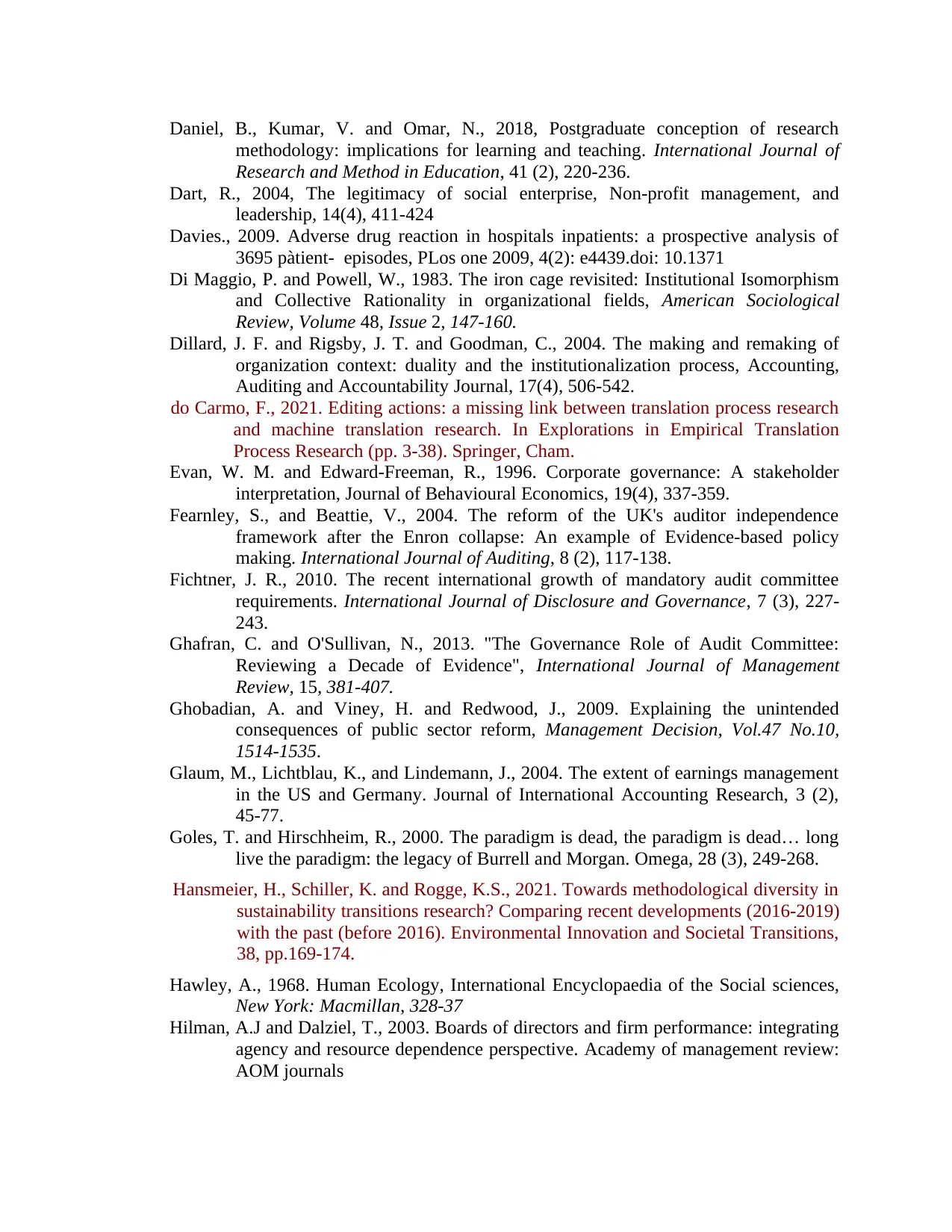
Daniel, B., Kumar, V. and Omar, N., 2018, Postgraduate conception of research
methodology: implications for learning and teaching. International Journal of
Research and Method in Education, 41 (2), 220-236.
Dart, R., 2004, The legitimacy of social enterprise, Non-profit management, and
leadership, 14(4), 411-424
Davies., 2009. Adverse drug reaction in hospitals inpatients: a prospective analysis of
3695 pàtient- episodes, PLos one 2009, 4(2): e4439.doi: 10.1371
Di Maggio, P. and Powell, W., 1983. The iron cage revisited: Institutional Isomorphism
and Collective Rationality in organizational fields, American Sociological
Review, Volume 48, Issue 2, 147-160.
Dillard, J. F. and Rigsby, J. T. and Goodman, C., 2004. The making and remaking of
organization context: duality and the institutionalization process, Accounting,
Auditing and Accountability Journal, 17(4), 506-542.
do Carmo, F., 2021. Editing actions: a missing link between translation process research
and machine translation research. In Explorations in Empirical Translation
Process Research (pp. 3-38). Springer, Cham.
Evan, W. M. and Edward-Freeman, R., 1996. Corporate governance: A stakeholder
interpretation, Journal of Behavioural Economics, 19(4), 337-359.
Fearnley, S., and Beattie, V., 2004. The reform of the UK's auditor independence
framework after the Enron collapse: An example of Evidence‐based policy
making. International Journal of Auditing, 8 (2), 117-138.
Fichtner, J. R., 2010. The recent international growth of mandatory audit committee
requirements. International Journal of Disclosure and Governance, 7 (3), 227-
243.
Ghafran, C. and O'Sullivan, N., 2013. "The Governance Role of Audit Committee:
Reviewing a Decade of Evidence", International Journal of Management
Review, 15, 381-407.
Ghobadian, A. and Viney, H. and Redwood, J., 2009. Explaining the unintended
consequences of public sector reform, Management Decision, Vol.47 No.10,
1514-1535.
Glaum, M., Lichtblau, K., and Lindemann, J., 2004. The extent of earnings management
in the US and Germany. Journal of International Accounting Research, 3 (2),
45-77.
Goles, T. and Hirschheim, R., 2000. The paradigm is dead, the paradigm is dead… long
live the paradigm: the legacy of Burrell and Morgan. Omega, 28 (3), 249-268.
Hansmeier, H., Schiller, K. and Rogge, K.S., 2021. Towards methodological diversity in
sustainability transitions research? Comparing recent developments (2016-2019)
with the past (before 2016). Environmental Innovation and Societal Transitions,
38, pp.169-174.
Hawley, A., 1968. Human Ecology, International Encyclopaedia of the Social sciences,
New York: Macmillan, 328-37
Hilman, A.J and Dalziel, T., 2003. Boards of directors and firm performance: integrating
agency and resource dependence perspective. Academy of management review:
AOM journals
methodology: implications for learning and teaching. International Journal of
Research and Method in Education, 41 (2), 220-236.
Dart, R., 2004, The legitimacy of social enterprise, Non-profit management, and
leadership, 14(4), 411-424
Davies., 2009. Adverse drug reaction in hospitals inpatients: a prospective analysis of
3695 pàtient- episodes, PLos one 2009, 4(2): e4439.doi: 10.1371
Di Maggio, P. and Powell, W., 1983. The iron cage revisited: Institutional Isomorphism
and Collective Rationality in organizational fields, American Sociological
Review, Volume 48, Issue 2, 147-160.
Dillard, J. F. and Rigsby, J. T. and Goodman, C., 2004. The making and remaking of
organization context: duality and the institutionalization process, Accounting,
Auditing and Accountability Journal, 17(4), 506-542.
do Carmo, F., 2021. Editing actions: a missing link between translation process research
and machine translation research. In Explorations in Empirical Translation
Process Research (pp. 3-38). Springer, Cham.
Evan, W. M. and Edward-Freeman, R., 1996. Corporate governance: A stakeholder
interpretation, Journal of Behavioural Economics, 19(4), 337-359.
Fearnley, S., and Beattie, V., 2004. The reform of the UK's auditor independence
framework after the Enron collapse: An example of Evidence‐based policy
making. International Journal of Auditing, 8 (2), 117-138.
Fichtner, J. R., 2010. The recent international growth of mandatory audit committee
requirements. International Journal of Disclosure and Governance, 7 (3), 227-
243.
Ghafran, C. and O'Sullivan, N., 2013. "The Governance Role of Audit Committee:
Reviewing a Decade of Evidence", International Journal of Management
Review, 15, 381-407.
Ghobadian, A. and Viney, H. and Redwood, J., 2009. Explaining the unintended
consequences of public sector reform, Management Decision, Vol.47 No.10,
1514-1535.
Glaum, M., Lichtblau, K., and Lindemann, J., 2004. The extent of earnings management
in the US and Germany. Journal of International Accounting Research, 3 (2),
45-77.
Goles, T. and Hirschheim, R., 2000. The paradigm is dead, the paradigm is dead… long
live the paradigm: the legacy of Burrell and Morgan. Omega, 28 (3), 249-268.
Hansmeier, H., Schiller, K. and Rogge, K.S., 2021. Towards methodological diversity in
sustainability transitions research? Comparing recent developments (2016-2019)
with the past (before 2016). Environmental Innovation and Societal Transitions,
38, pp.169-174.
Hawley, A., 1968. Human Ecology, International Encyclopaedia of the Social sciences,
New York: Macmillan, 328-37
Hilman, A.J and Dalziel, T., 2003. Boards of directors and firm performance: integrating
agency and resource dependence perspective. Academy of management review:
AOM journals

Hussey, J., and Hussey, R., 1997. Business research: A practical guide for undergraduate
and postgraduate students. Basingstoke, UK: Palgrave MacMillan
Iriyadi, I., 2019. Prevention of Earnings Management through Audit Committee and
Audit Quality in the Award-Winning and Non-Winning Companies. Journal of
Accounting Research, Organization and Economics, 2(2), pp.155-169.
Jacobs, K., 2012. Making sense of social practice: theoretical pluralism in public sector
Lapsley, I., 1999. Research in public sector accounting: an appraisal, Accounting,
Auditing and Accountability Journal, 1(1), 21-33.
Larcker, D. and Richardson, S. and Tuna, I., 2007. “Corporate governance, Accounting
Outcomes, and Organizational performance”, The Accounting Review, 82, 963-
1008.
Lubna., 2018. The Development of Audit Committees - A Review of the Literature on
Magrane, J and Malthus. S., 2010. Audit committee effectiveness: a public sector case
study, Managerial auditing journal. Vol 25. Issue 5
Meyer, J. W. and Rowan, B., 1977. Institutionalized organizations: Formal structure as
myth and ceremony, American journal of sociology, 340-363
Miller, K. D., 2002. Option value and entry timing: strategic management journal.vol.23.
Issue (7)., p655-665
Mohammed, A. M., Al-Habaibeh, A., Abdo, H., and Elabar, S., 2015. 2015. Towards
exporting renewable energy from MENA region to Europe: An investigation
into domestic energy use and householders’ energy behaviour in Libya. Applied
Energy, 146 (May 2015), 247-262.
Monitor., 2020. Annual Report. The HHS constitution, HC 1059.
Muñoz-La Rivera, F., Mora-Serrano, J., Valero, I. and Oñate, E., 2021. Methodological-
technological framework for Construction 4.0. Archives of Computational
Methods in Engineering, 28(2), pp.689-711.
Okpara, J. O., 2011. Corporate governance in a developing economy: Barriers, issues,
and implications for firms. Corporate Governance: The International Journal of
Business in Society, 11 (2), 184- 199.
Pollitt, C. and Bouckaert, G., 2011. Public management reform: A comparative analysis-
new public management, governance, and the Neo-Weberian state, Oxford
University Press.
Rustam, S., Rashid, K., and Zaman, K., 2013. The relationship between audit
committees, compensation incentives and corporate audit fees in Pakistan.
Economic Modelling, 31, (March), 697-716.
Ryan, B., Scapens, R. W., and Theobald, M., 2002. Research method and methodology in
finance and accounting (2nd ed.). London: Thomson.
Saunders, M., Lewis, P., and Thornhill, A., 2009. Research methods for business students
(5th ed.). Harlow, UK: Pearson Education Limited.
Smyth, S. 2012. Contesting public accountability: A dialogical exploration of
accountability and social housing, Critical Perspectives on Accounting, 23(3),
230-243
Stewart, B., 2006. The real reasons Enron failed. Journal of Applied Corporate Finance,
18 (2), 116- 119.
and postgraduate students. Basingstoke, UK: Palgrave MacMillan
Iriyadi, I., 2019. Prevention of Earnings Management through Audit Committee and
Audit Quality in the Award-Winning and Non-Winning Companies. Journal of
Accounting Research, Organization and Economics, 2(2), pp.155-169.
Jacobs, K., 2012. Making sense of social practice: theoretical pluralism in public sector
Lapsley, I., 1999. Research in public sector accounting: an appraisal, Accounting,
Auditing and Accountability Journal, 1(1), 21-33.
Larcker, D. and Richardson, S. and Tuna, I., 2007. “Corporate governance, Accounting
Outcomes, and Organizational performance”, The Accounting Review, 82, 963-
1008.
Lubna., 2018. The Development of Audit Committees - A Review of the Literature on
Magrane, J and Malthus. S., 2010. Audit committee effectiveness: a public sector case
study, Managerial auditing journal. Vol 25. Issue 5
Meyer, J. W. and Rowan, B., 1977. Institutionalized organizations: Formal structure as
myth and ceremony, American journal of sociology, 340-363
Miller, K. D., 2002. Option value and entry timing: strategic management journal.vol.23.
Issue (7)., p655-665
Mohammed, A. M., Al-Habaibeh, A., Abdo, H., and Elabar, S., 2015. 2015. Towards
exporting renewable energy from MENA region to Europe: An investigation
into domestic energy use and householders’ energy behaviour in Libya. Applied
Energy, 146 (May 2015), 247-262.
Monitor., 2020. Annual Report. The HHS constitution, HC 1059.
Muñoz-La Rivera, F., Mora-Serrano, J., Valero, I. and Oñate, E., 2021. Methodological-
technological framework for Construction 4.0. Archives of Computational
Methods in Engineering, 28(2), pp.689-711.
Okpara, J. O., 2011. Corporate governance in a developing economy: Barriers, issues,
and implications for firms. Corporate Governance: The International Journal of
Business in Society, 11 (2), 184- 199.
Pollitt, C. and Bouckaert, G., 2011. Public management reform: A comparative analysis-
new public management, governance, and the Neo-Weberian state, Oxford
University Press.
Rustam, S., Rashid, K., and Zaman, K., 2013. The relationship between audit
committees, compensation incentives and corporate audit fees in Pakistan.
Economic Modelling, 31, (March), 697-716.
Ryan, B., Scapens, R. W., and Theobald, M., 2002. Research method and methodology in
finance and accounting (2nd ed.). London: Thomson.
Saunders, M., Lewis, P., and Thornhill, A., 2009. Research methods for business students
(5th ed.). Harlow, UK: Pearson Education Limited.
Smyth, S. 2012. Contesting public accountability: A dialogical exploration of
accountability and social housing, Critical Perspectives on Accounting, 23(3),
230-243
Stewart, B., 2006. The real reasons Enron failed. Journal of Applied Corporate Finance,
18 (2), 116- 119.
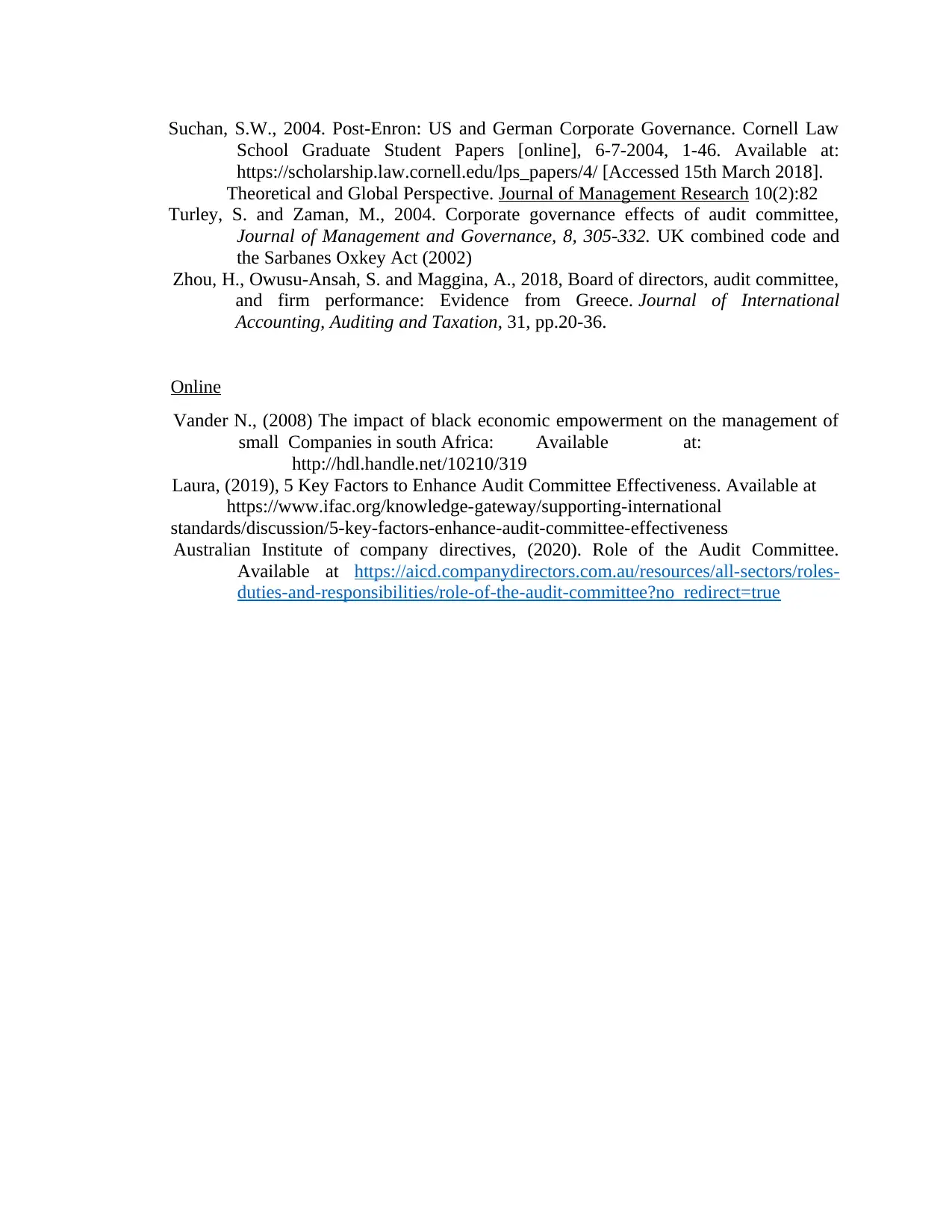
Suchan, S.W., 2004. Post-Enron: US and German Corporate Governance. Cornell Law
School Graduate Student Papers [online], 6-7-2004, 1-46. Available at:
https://scholarship.law.cornell.edu/lps_papers/4/ [Accessed 15th March 2018].
Theoretical and Global Perspective. Journal of Management Research 10(2):82
Turley, S. and Zaman, M., 2004. Corporate governance effects of audit committee,
Journal of Management and Governance, 8, 305-332. UK combined code and
the Sarbanes Oxkey Act (2002)
Zhou, H., Owusu-Ansah, S. and Maggina, A., 2018, Board of directors, audit committee,
and firm performance: Evidence from Greece. Journal of International
Accounting, Auditing and Taxation, 31, pp.20-36.
Online
Vander N., (2008) The impact of black economic empowerment on the management of
small Companies in south Africa: Available at:
http://hdl.handle.net/10210/319
Laura, (2019), 5 Key Factors to Enhance Audit Committee Effectiveness. Available at
https://www.ifac.org/knowledge-gateway/supporting-international
standards/discussion/5-key-factors-enhance-audit-committee-effectiveness
Australian Institute of company directives, (2020). Role of the Audit Committee.
Available at https://aicd.companydirectors.com.au/resources/all-sectors/roles-
duties-and-responsibilities/role-of-the-audit-committee?no_redirect=true
School Graduate Student Papers [online], 6-7-2004, 1-46. Available at:
https://scholarship.law.cornell.edu/lps_papers/4/ [Accessed 15th March 2018].
Theoretical and Global Perspective. Journal of Management Research 10(2):82
Turley, S. and Zaman, M., 2004. Corporate governance effects of audit committee,
Journal of Management and Governance, 8, 305-332. UK combined code and
the Sarbanes Oxkey Act (2002)
Zhou, H., Owusu-Ansah, S. and Maggina, A., 2018, Board of directors, audit committee,
and firm performance: Evidence from Greece. Journal of International
Accounting, Auditing and Taxation, 31, pp.20-36.
Online
Vander N., (2008) The impact of black economic empowerment on the management of
small Companies in south Africa: Available at:
http://hdl.handle.net/10210/319
Laura, (2019), 5 Key Factors to Enhance Audit Committee Effectiveness. Available at
https://www.ifac.org/knowledge-gateway/supporting-international
standards/discussion/5-key-factors-enhance-audit-committee-effectiveness
Australian Institute of company directives, (2020). Role of the Audit Committee.
Available at https://aicd.companydirectors.com.au/resources/all-sectors/roles-
duties-and-responsibilities/role-of-the-audit-committee?no_redirect=true
1 out of 37
Related Documents
Your All-in-One AI-Powered Toolkit for Academic Success.
+13062052269
info@desklib.com
Available 24*7 on WhatsApp / Email
![[object Object]](/_next/static/media/star-bottom.7253800d.svg)
Unlock your academic potential
© 2024 | Zucol Services PVT LTD | All rights reserved.





